Report

Written in collaboration with
Written in collaboration with
![]()
Introduction
Jacek Poświata
Managing Partner, Bain & Company Poland/CEE
I am delighted to present you with our first ever report on private equity and venture capital in Central and Eastern Europe (CEE), which highlights the region’s continued strong economic growth and examines the rich opportunities this presents for the industry. After two decades of development, the PE ecosystem in our region is well positioned for accelerated growth as local and international funds leverage CEE’s clear economic advantages.
The Central and Eastern European macroeconomic growth story is set to continue as the economies of the region catch up with those further west. That process is being driven by factors including a highly qualified labour force backed by outstanding universities; investments in nearshoring as manufacturers reconsider their global supply chains, and EU funding to help close the gap in infrastructure and support the transition to a green economy.
Against that backdrop, PE and VC funds have already scored some impressive successes in our region, and I’m proud to be able to tell their stories in this report. I’m also proud of Bain Poland/CEE’s role in this ecosystem: in the past 12 months alone, our consultants have advised on more than 20 projects in the region, working with local and global clients across the deal cycle—from GP investment strategy, through commercial due diligence, to post-acquisition strategy and exit support. And, of course, we’re part of the world’s leading consulting firm for the industry, with a global practice more than three times the size of our nearest competitor’s.
The report also discusses industry leaders’ outlook for the coming years, including positive trends such as consolidation within economies and the emergence of regional and global champions. Issues such as the war in Ukraine do indeed loom large in investors’ minds, though the good news is that respondents to our survey are convinced that the effect on their business is transitory. In that regard, it’s important to bear in mind that all the countries we cover in this report are members of the EU and NATO, benefitting from guarantees of military and economic security.
I’d like to thank all the representatives of the industry who took the time to participate in our interviews and survey, contributing useful insights that you’ll see highlighted throughout these pages. I’d also like to thank our partners from PSIK and PFR for helping make this report possible.
I’m convinced that you will find the report to be a valuable contribution on the role of PE and VC in our region, and I look forward to participating in the many conversations it will inspire.
Małgorzata Bobrowska-Jarząbek
President of the Board, Polish Private Equity and Venture Capital Association
Co-Founder and Managing Partner, Resource Partners
This report provides a valuable opportunity to take a fresh look at the PE and VC ecosystem in Central and Eastern Europe as we emerge from the global pandemic and gear up for a period of faster growth in the industry. I’m grateful for the chance to present our members’ views on the prospects for PE funds throughout the region, including the opportunities presented by CEE’s unique macroeconomic advantages.
Over the past two decades, PE professionals have worked hard to create a mature ecosystem for the industry, and they’re positioned to reap the rewards of that effort as CEE continues its long-term process of catching up with more developed economies in Western Europe. Experienced GPs, founders who are open to working with financial investors, and a deep pool of management talent for both funds and portfolio companies—all this adds up to a time of remarkable opportunity.
The insights in this report are sure to provide useful guidance for investors both old and new, and PSIK looks forward to continuing to support the industry as we move into a time of accelerated growth.
Maciej Ćwikiewicz
President of the Board, PFR Ventures
Venture capital in CEE has been booming in recent years, and PFR is proud to have played a fundamental role in that. As this report clearly shows, the fundamentals are strong and include world-class technical education, new opportunities in areas such as green transformation, and an emerging flywheel effect as alumni of successful companies begin to fund and mentor the next generation of start-ups.
This report provides key insights into the forces behind those trends and forecasts for how they will play out over the next few years. I’m particularly intrigued and excited by the thesis that VC in Central and Eastern Europe can grow as fast as two to three times over the next four years if the historical trajectory of Western European ecosystems is followed.
As PFR presses forward with our mission of supporting Poland’s economic development, this report offers clear insights into the factors that are driving the industry and that will account for its continued success. We’re grateful to our partners, Bain & Company and PSIK, for the opportunity to contribute to this impressive work.
Summary perspectives
The economies of Central and Eastern Europe (CEE) are on a path of sustained, fast growth as they catch up to their Western peers, offering attractive opportunities for private equity and venture capital investors. The industry itself has developed steadily over the past two decades, despite the global financial crisis and other headwinds that have kept its role in the economy smaller than in comparable regions. Today, with a mature ecosystem—including a pool of management talent, experienced GPs, and founders who are more open to working with funds—the PE and VC industry in this part of the world has all the pieces in place to embark on sustained acceleration. That should allow funds to capitalise on the unique advantages that will help the region continue to outperform more mature markets.
Those advantages include a well-educated and comparatively low-cost labour force and trends such as intra-regional consolidation and global manufacturers looking for locations close to the key markets of Western Europe. All of this is undergirded by membership in the European Union: the 11 countries offer access to the single market, with all the legal protections found in developed EU economies, combined with emerging markets’ faster rates of growth. That makes the region a sweet spot for investors, in comparison both with Western Europe and with emerging economies in less stable regions such as Southeast Asia or Latin America.
Of course, challenges also remain, such as less developed infrastructure, more difficult regulatory environments, and the effects of the war in Ukraine. Bear in mind, though, that the countries’ membership in the EU and NATO also provides a basis for addressing each of those issues: respectively, development funding from the EU, guarantees of the rule of law, and the political and economic security that come from membership in the bloc and the transatlantic alliance.
Against this backdrop, PE investments in CEE are in a steady growth phase, continuing the rebound that began in 2014 following the global financial crisis and the subsequent eurozone crisis. However, their dynamics have not matched the global PE market bonanza, leaving headroom for convergence to international benchmarks. The region’s maturing PE ecosystem, with more experienced GPs, entrepreneurs, and managers, is ever better equipped to absorb capital. Emerging opportunities will feed into the deal flow of both regionally based and international GPs.
Meanwhile, VC investments in CEE are booming. After reaching an inflection point in 2016, funding skyrocketed, making CEE outpace most other VC ecosystems in Europe. Further growth has strong fundamentals and will benefit from the start-up ecosystem flywheel effect, in which successful entrepreneurs inspire and sponsor succeeding generations. A comparison with other VC ecosystems supports the thesis that prospects for Central and Eastern Europe are dynamic, with growth as fast as two to three times over four years if the historical trajectory of Western European ecosystems is followed.
For this report, we define Central and Eastern Europe as the 11 countries of the region that are members of the European Union. They have a total population of more than 100 million and a combined GDP of €1.3 trillion (see Figure 1).
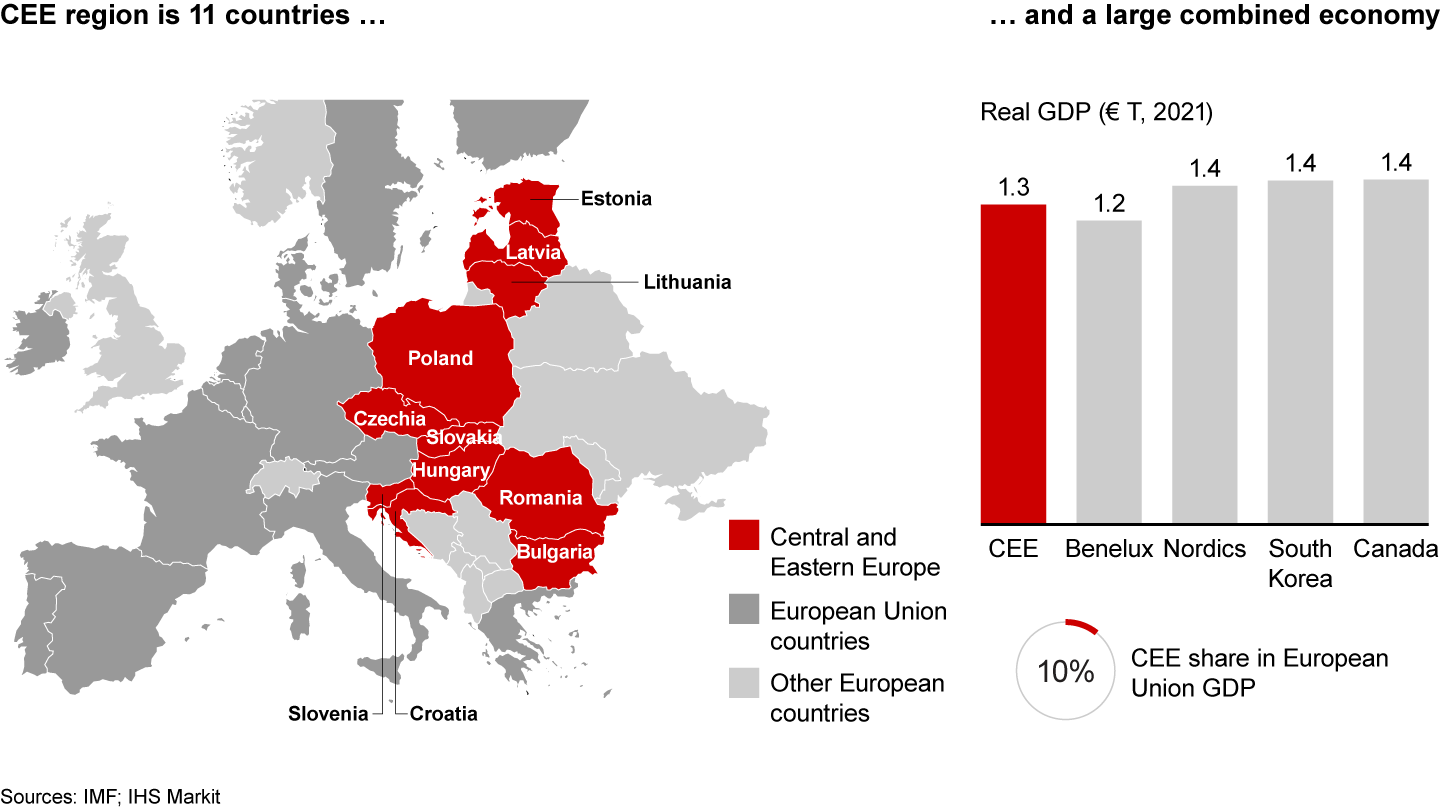
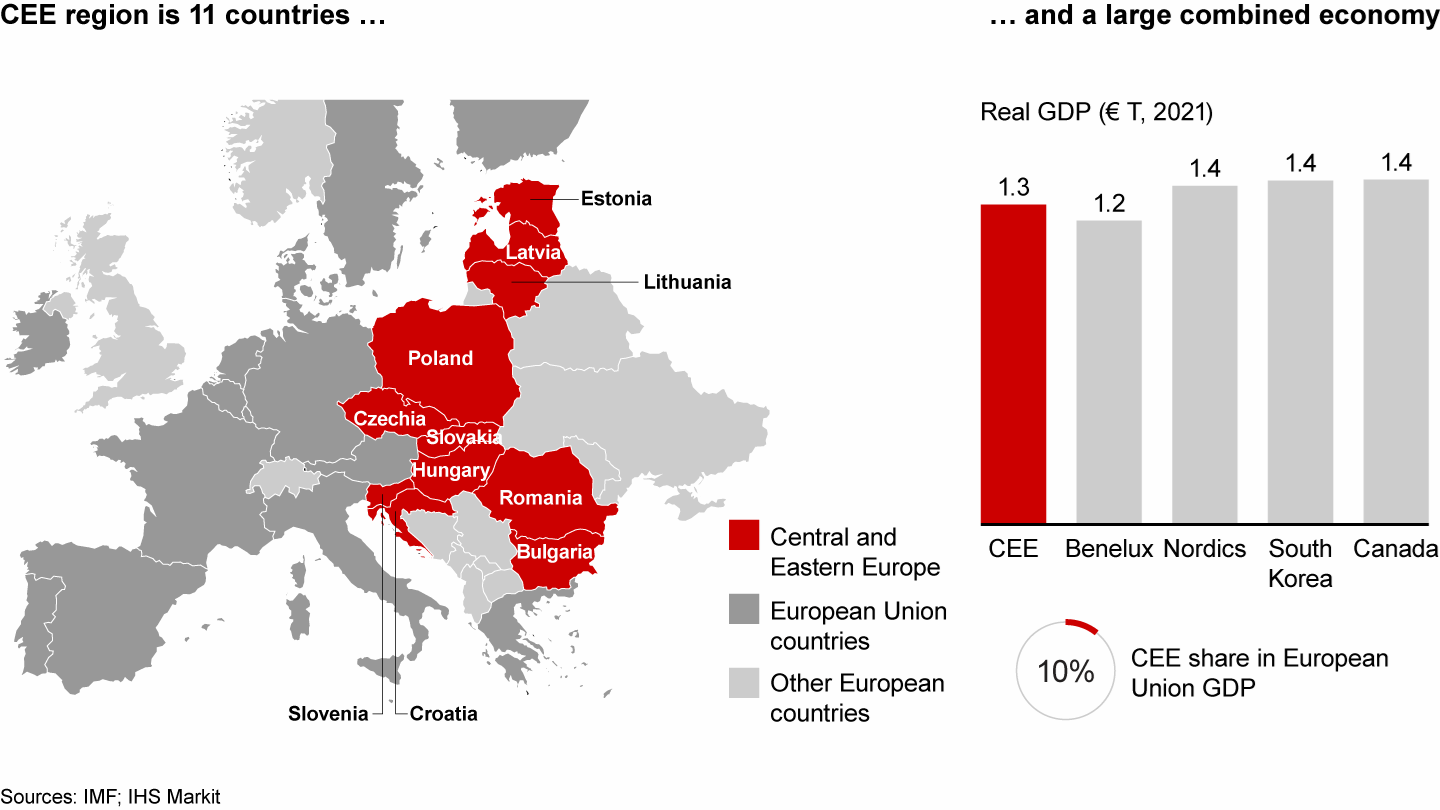
The macroeconomy’s solid foundation for growth creates opportunities for PE and VC investments
The CEE Economy
The 11 countries of Central and Eastern Europe had a combined GDP of €1.3 trillion in 2021, comparable to the GDPs of the Nordic countries, South Korea, or Canada, at €1.4 trillion each. That accounted for 10% of the EU’s economy, even though the region has about a quarter of the Union’s population—illustrating the room for growth. And indeed, growth of about 3% in 2016 to 2021 consistently outpaced the Western European rate of around 1% (see Figures 2 and 3).
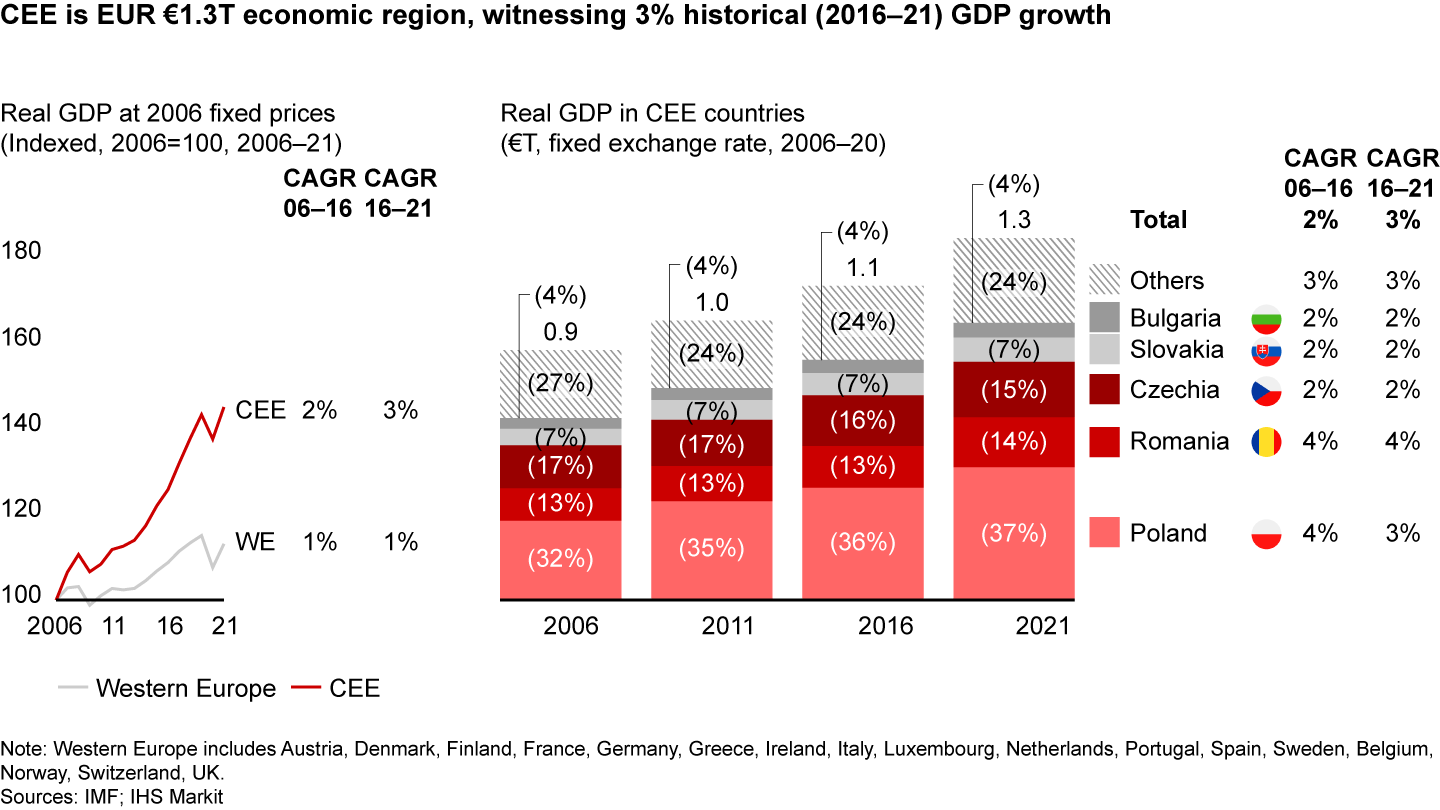
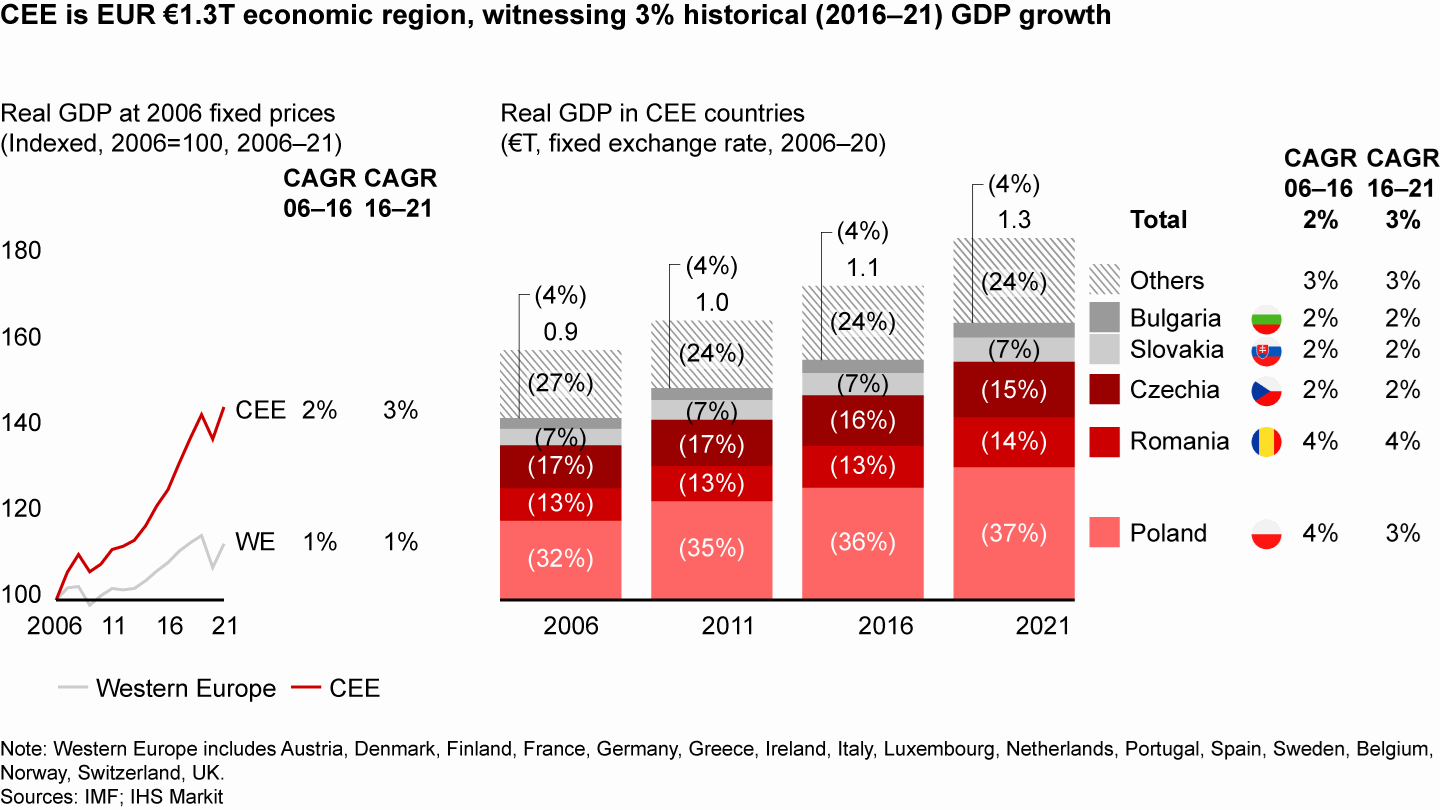
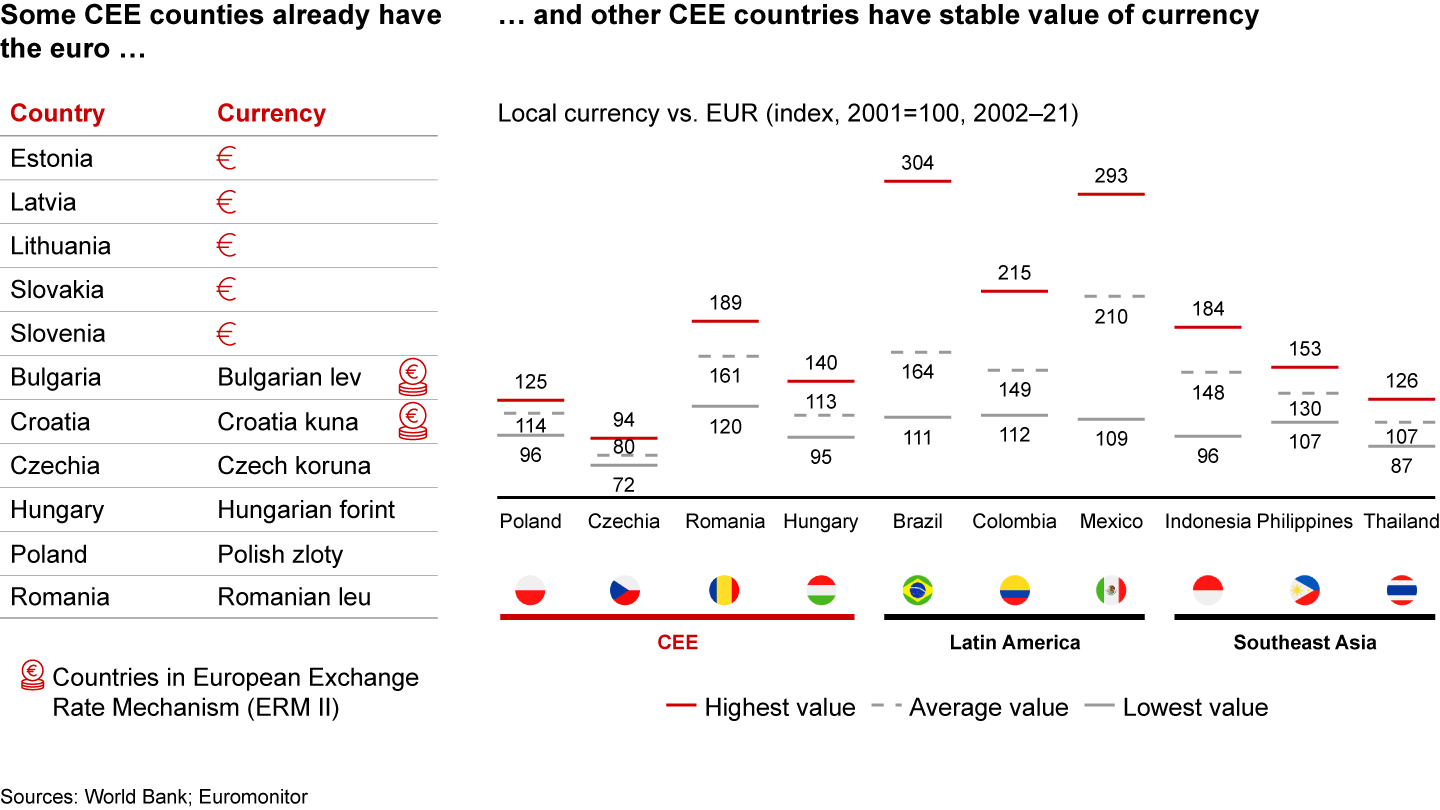
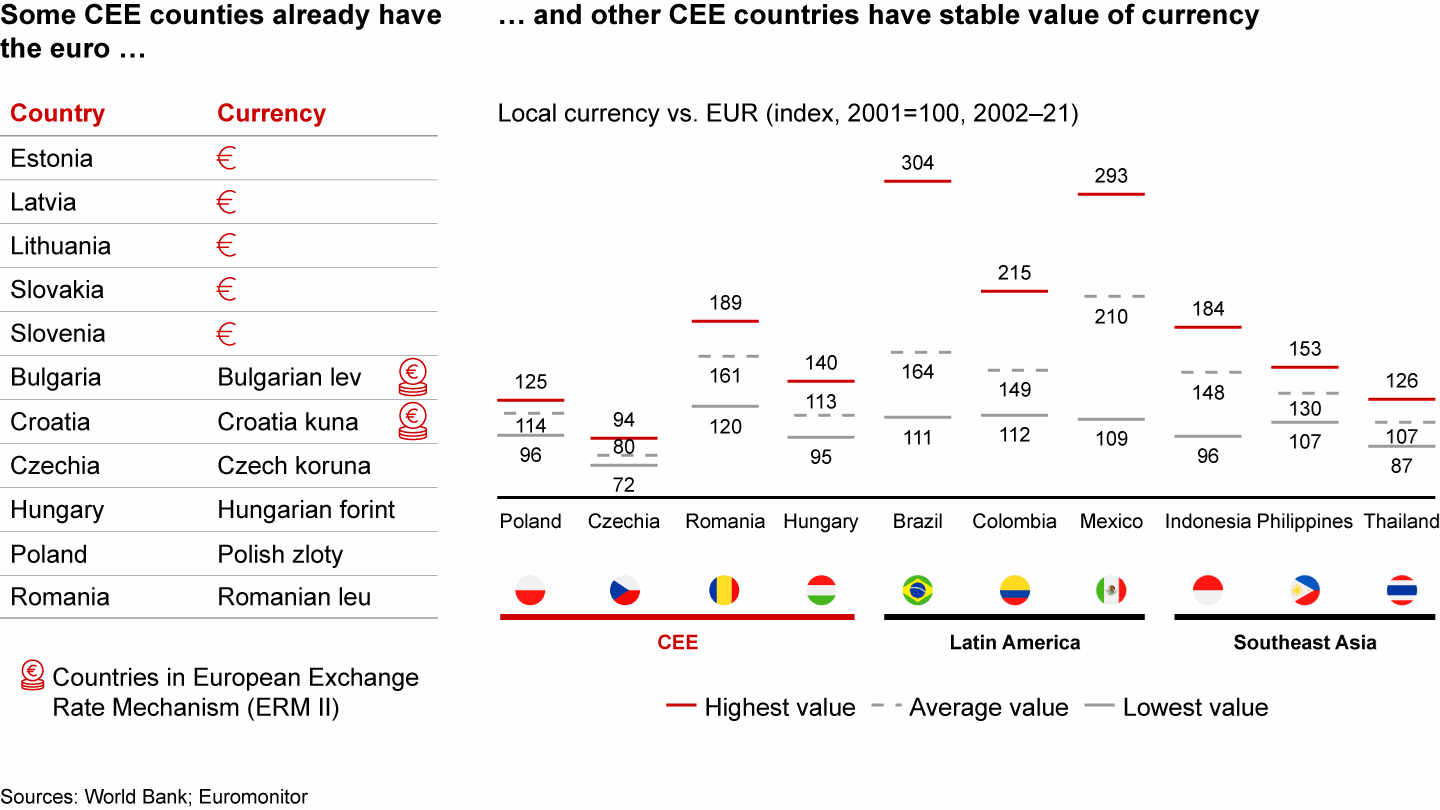
These faster rates of growth also come with lower volatility than other emerging markets, as seen in the narrower fluctuations of the region’s currencies. Integration with Western European economies through the single market; steady, long-term inflows from the EU; and the EU’s guarantees of legal certainty combine to have a stabilizing effect. In fact, five of the 11 countries have already adopted the euro, while another two have established pegs to the single currency.
An educated labour force
The region’s workforce is another attraction—not only for its lower labour costs compared with those of Western Europe, but for quality and skills that are impressive by global standards. In fact, by several measures the 11 countries in this report are ahead of the West. CEE has a higher percentage of graduates with engineering majors than Western Europe (14.8% versus 14.5% as of 2019) and accounts for 19% of the EU’s developer talent pool. Czechia, Hungary, Poland, and Slovakia took four of the top six places in the 2019 Skill Value Report, ranking the countries around the world with the best developers. And employment of ICT specialists in the region grew by 5% per year from 2011 to 2020, outstripping the 4% pace in Western Europe.
Within the region, Poland’s education system stands out as an effective engine for innovation, with 1.2 million students in its 368 academic centres. That includes 106,000 students in technical fields, and another 220,000 in business and administration. Already boasting CEE’s largest population at about 38 million, Poland is also increasingly attractive to international students from other emerging markets such as India and Ukraine.
Infrastructure development and EU funds
Central and Eastern Europe’s digital, technological, and transportation infrastructure are still catching up to those of Western Europe, with development underpinned by continual inflows of EU funds (see Figure 4). The rate of household broadband connections is similar to that of Western Europe, at 87% versus 92%, while 5G coverage lags behind, reaching 6% of households compared with 18%. Corporates have room for improvement in cloud computing usage, bringing their rate up from 25%, closer to the Western European level of 41%.
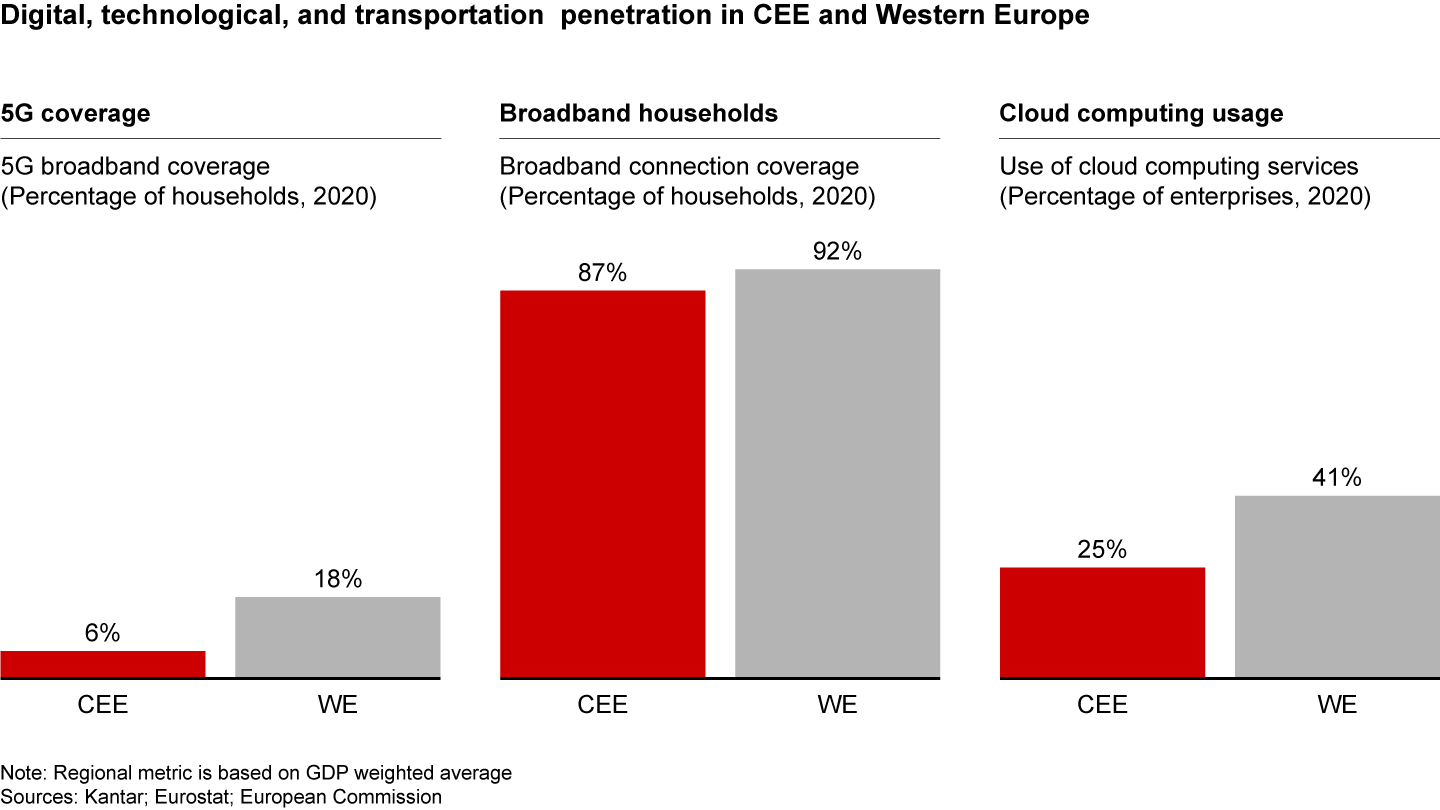
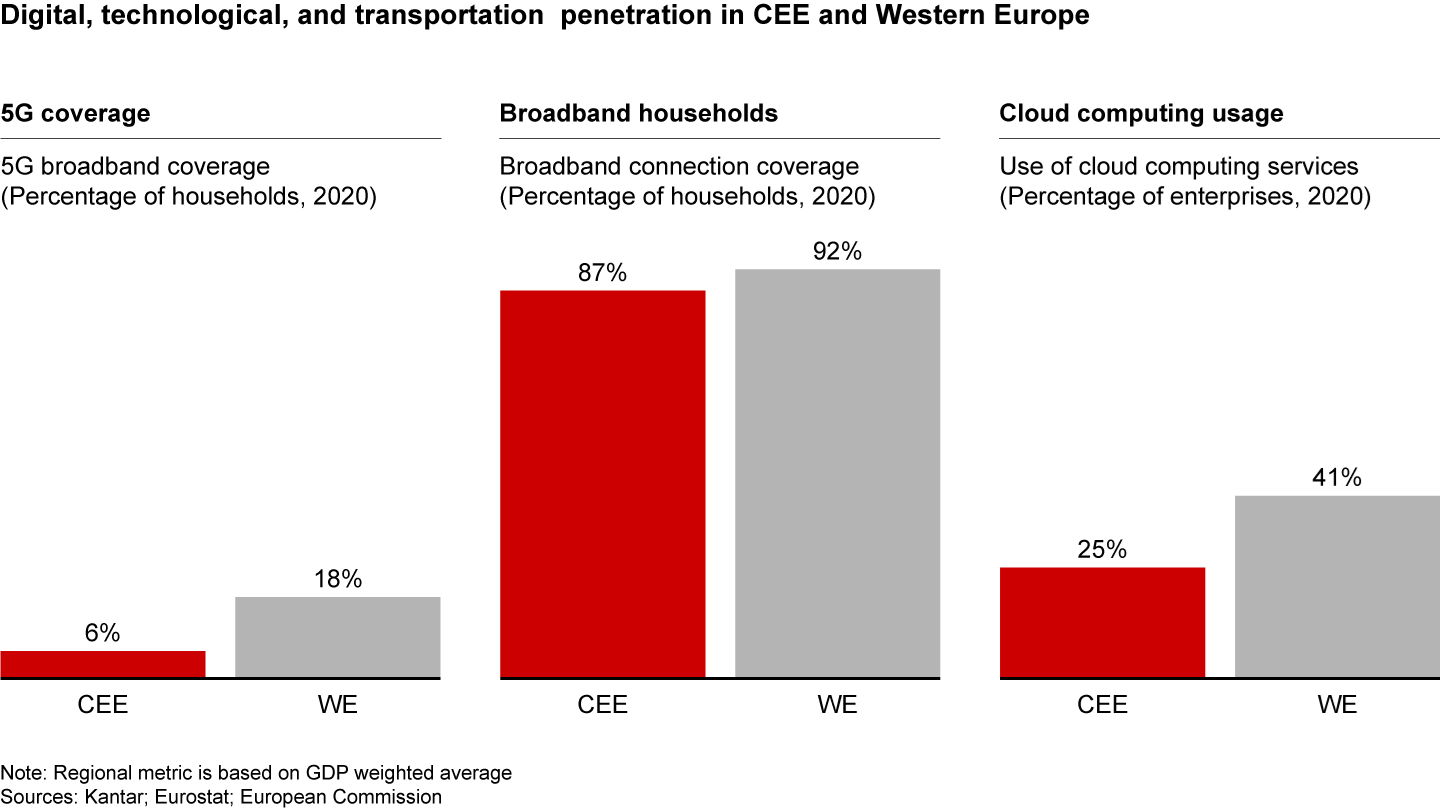
In the two decades from 2007 to 2027, the EU is plowing €584 billion of cohesion policy funding into the region to support development. During the most recently completed phase, in 2014–2020, 24% of the funding went into network infrastructure in transportion and energy; the No. 2 priority was the low-carbon economy, with 11%, followed by environmental protection and resource efficiency at 10%.
The current funding period, which runs from 2021 to 2027, is focusing on five policy objectives:
- a more competitive and smarter Europe;
- greener, low-carbon transitioning toward a net-zero economy;
- a more connected Europe, by enhancing mobility;
- a more social and inclusive Europe; and
- a Europe that’s closer to its citizens by fostering the sustainable and integrated development of all types of territories.
As infrastructure catches up with more developed economies in Western Europe, so too does productivity. The gap in average labour productivity per capita between the region’s countries and their Western peers has steadily narrowed over the past 15 years (see Figure 5).
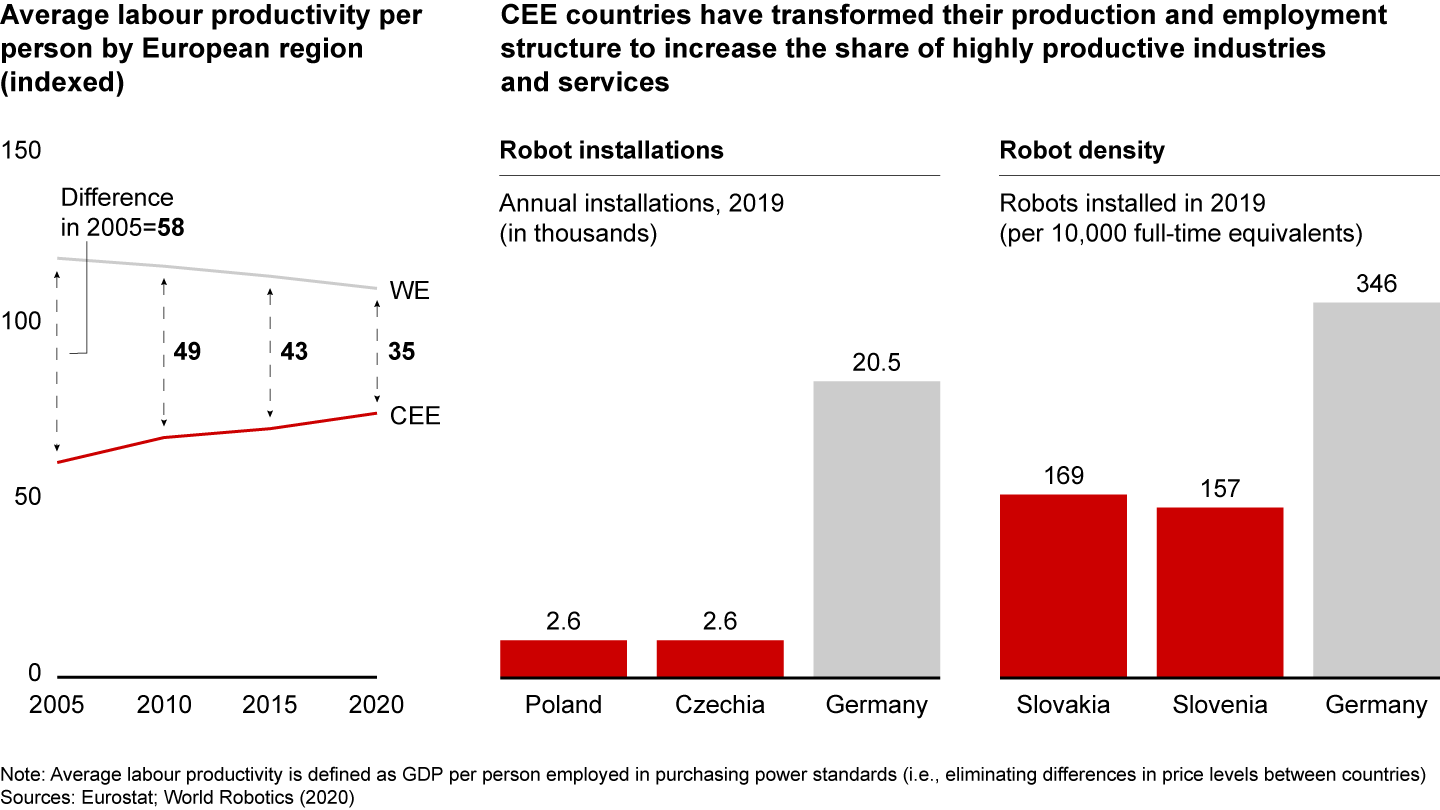
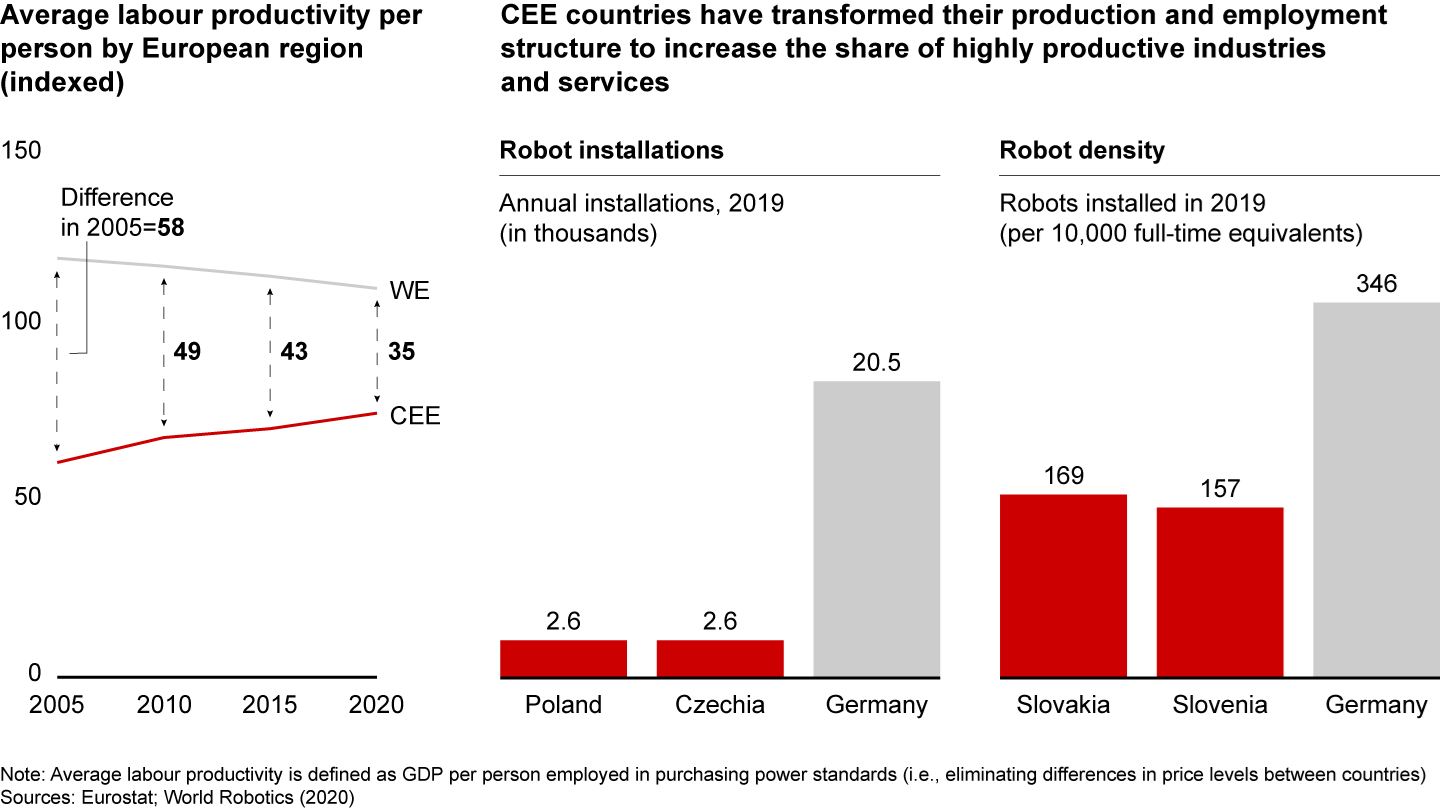
FDI inflows
In addition to the flow of EU cash, private investment also continues to move into the region. The value of greenfield FDI projects in CEE grew faster than the global rate in 2015–2020 (see Figure 6). Poland in particular ranked No. 3 in Europe by the value of such projects announced in 2020, outpacing the larger economies in France, Spain, Italy, and the Netherlands. Four other markets in the region also made the top 15. And once again, the story of CEE is not just about low labour costs: these investments are increasingly advanced, with several multinational tech companies choosing this part of the world as a location for their R&D centres and hubs (see Figure 7). Poland posted a compound annual growth rate (CAGR) of about 8% in the number of R&D personnel from 2010 to 2020, and a 14% CAGR in the number of R&D entities.
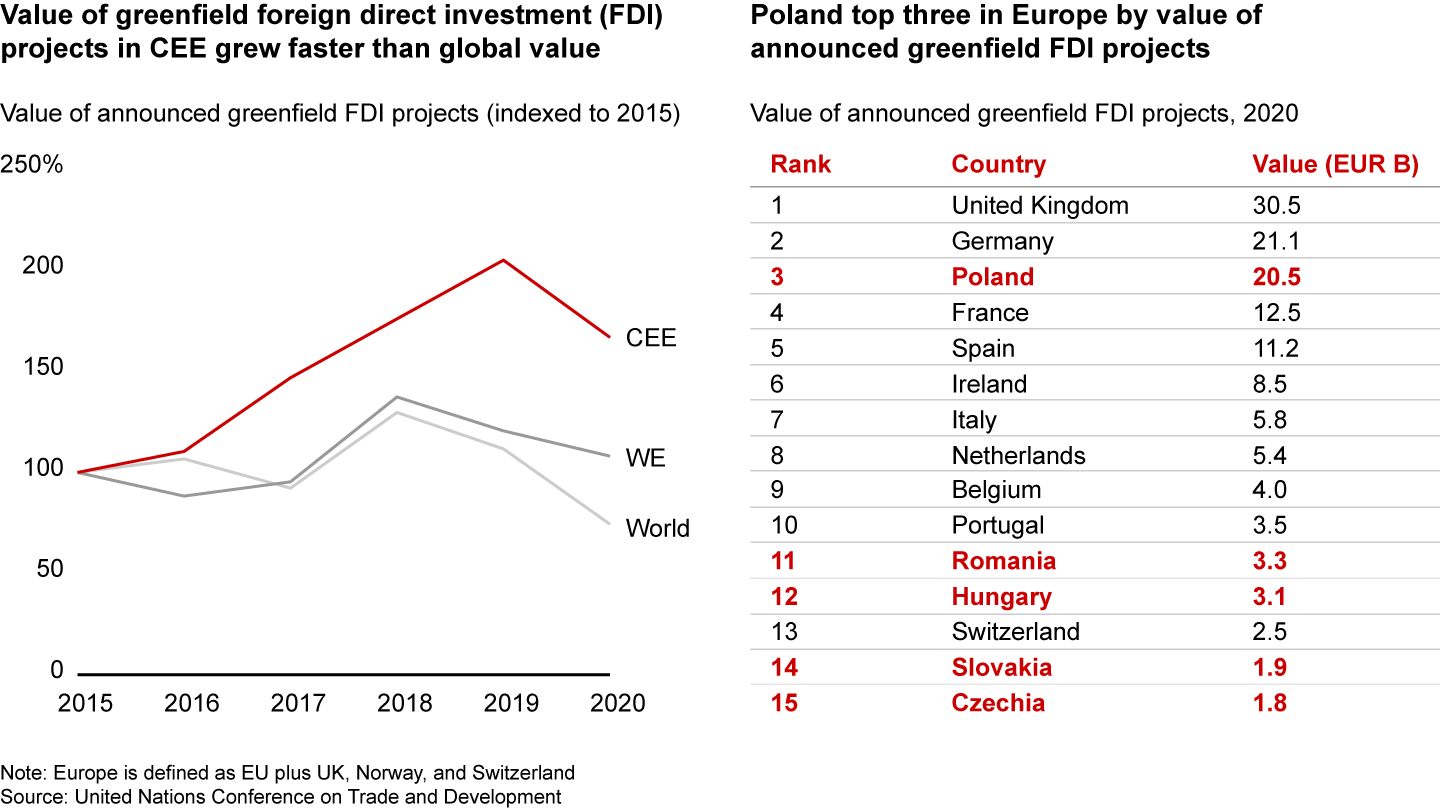
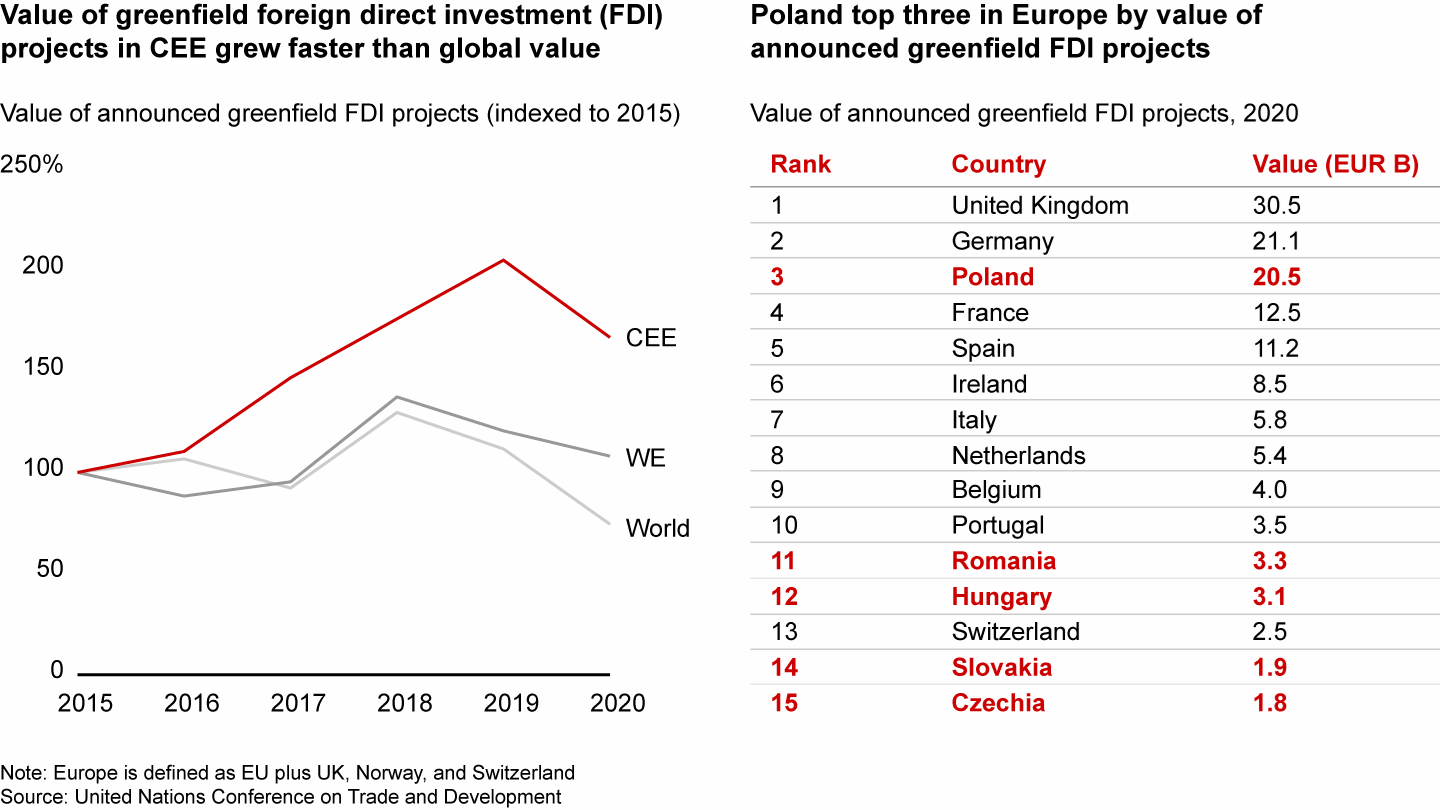
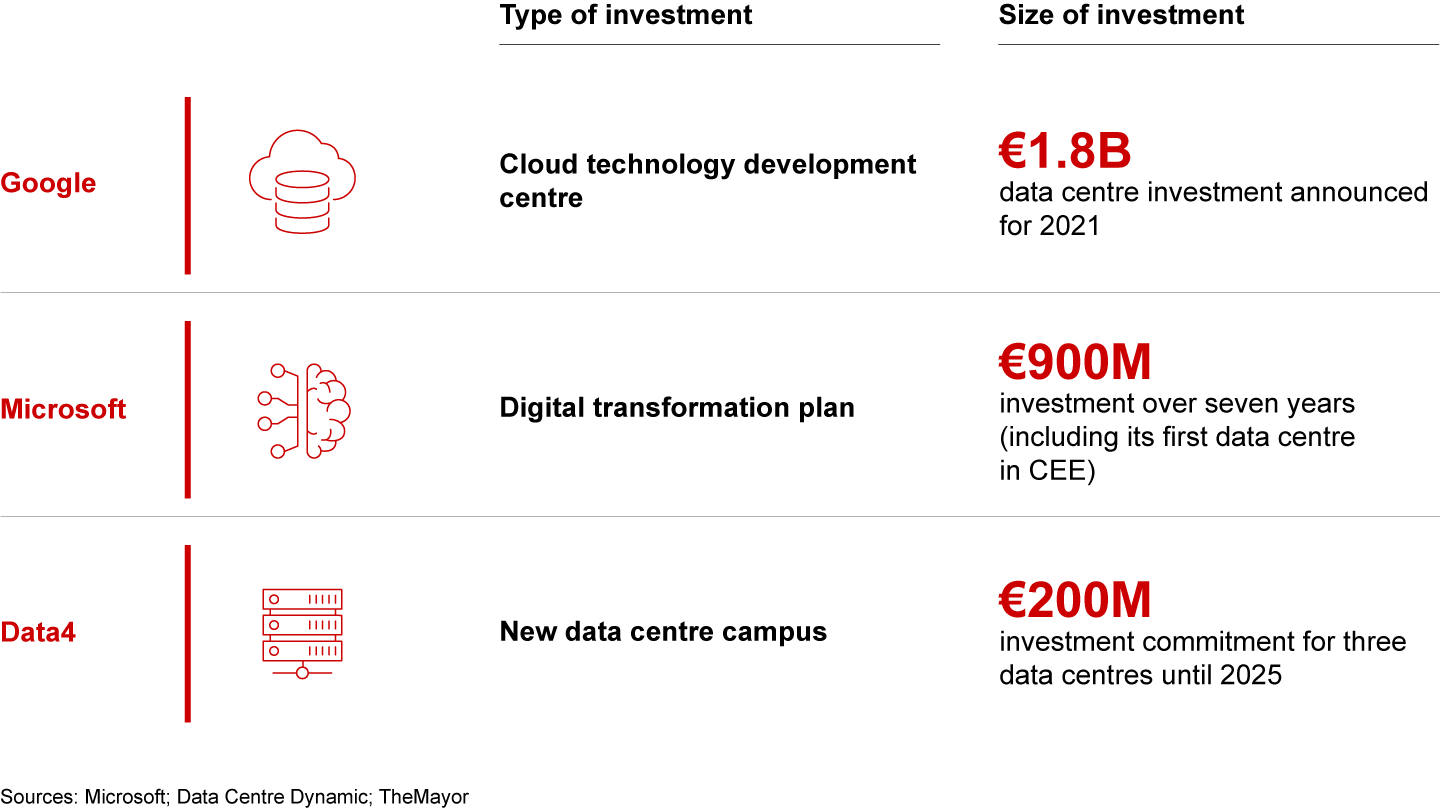
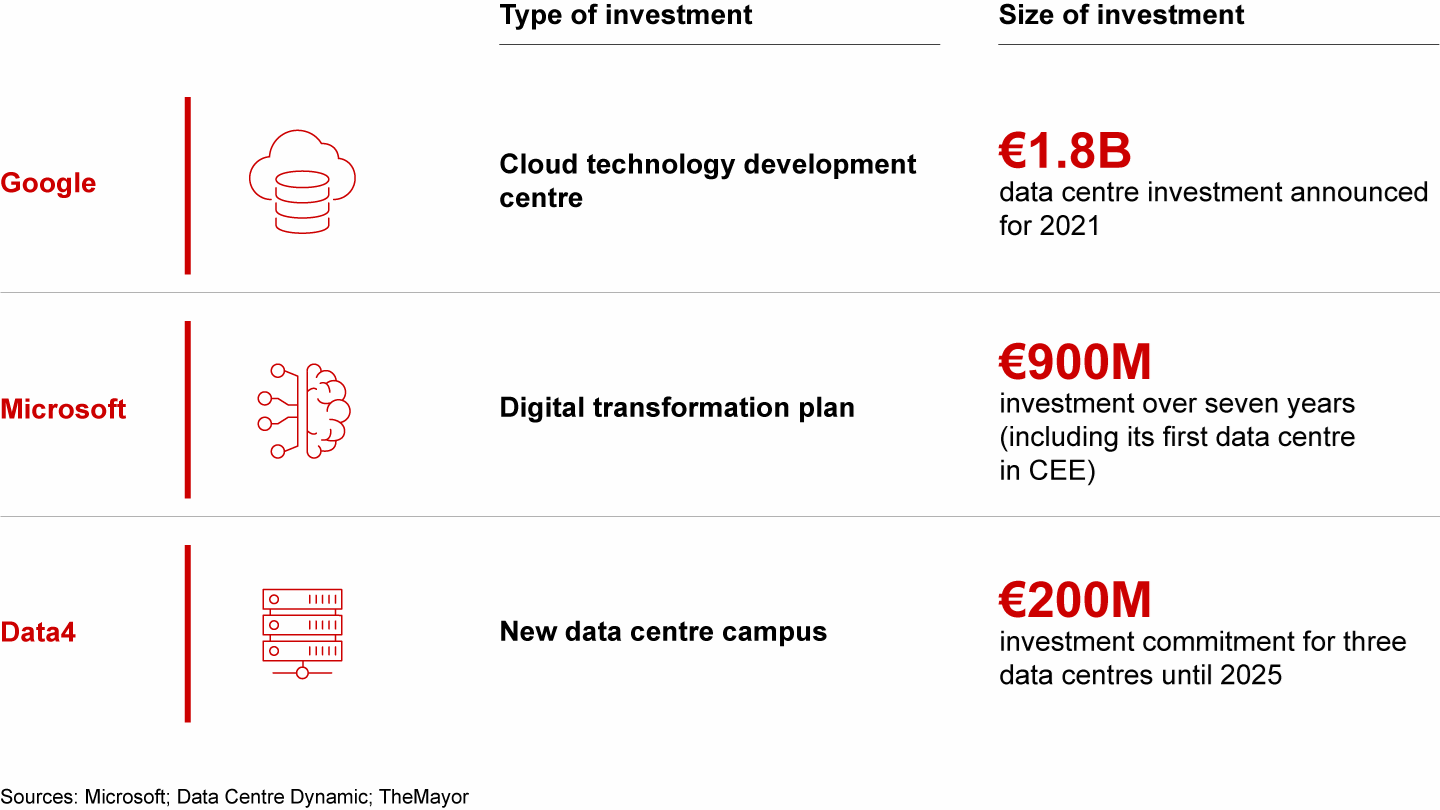
An improving regulatory climate
Companies and investors in CEE still face higher bureaucratic hurdles, including regulatory uncertainty, compared with those in more developed markets, and this concern is reflected in our conversations with the PE industry. However, the ease of doing business in the region has improved steadily over the past 10 years, approaching the EU average and well ahead of Southeast Asia, according to the World Bank’s annual ranking (see Figure 8). Statistics from the OECD also show steady improvement, with stakeholder engagement levels actually ahead of those in Western Europe (see Figure 9).
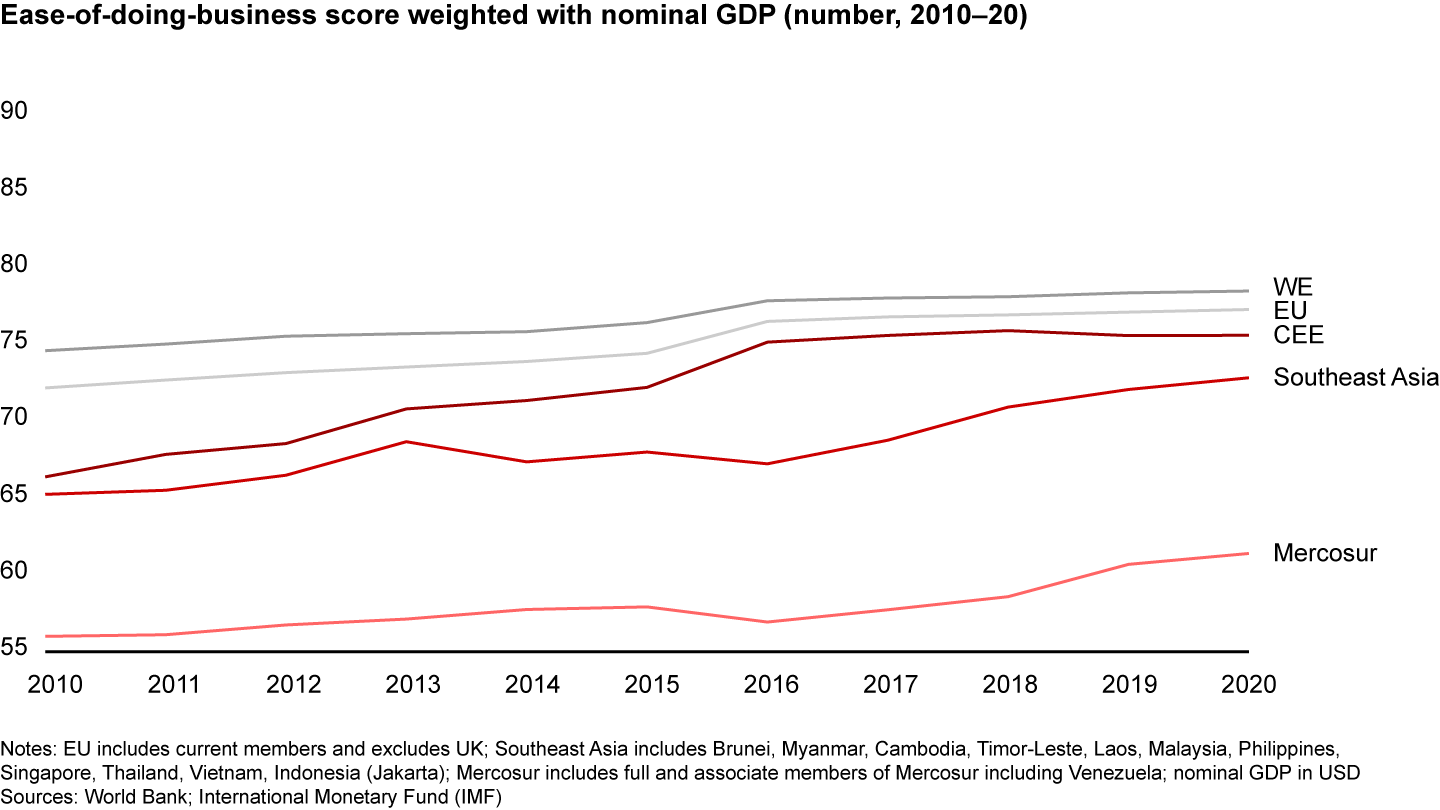
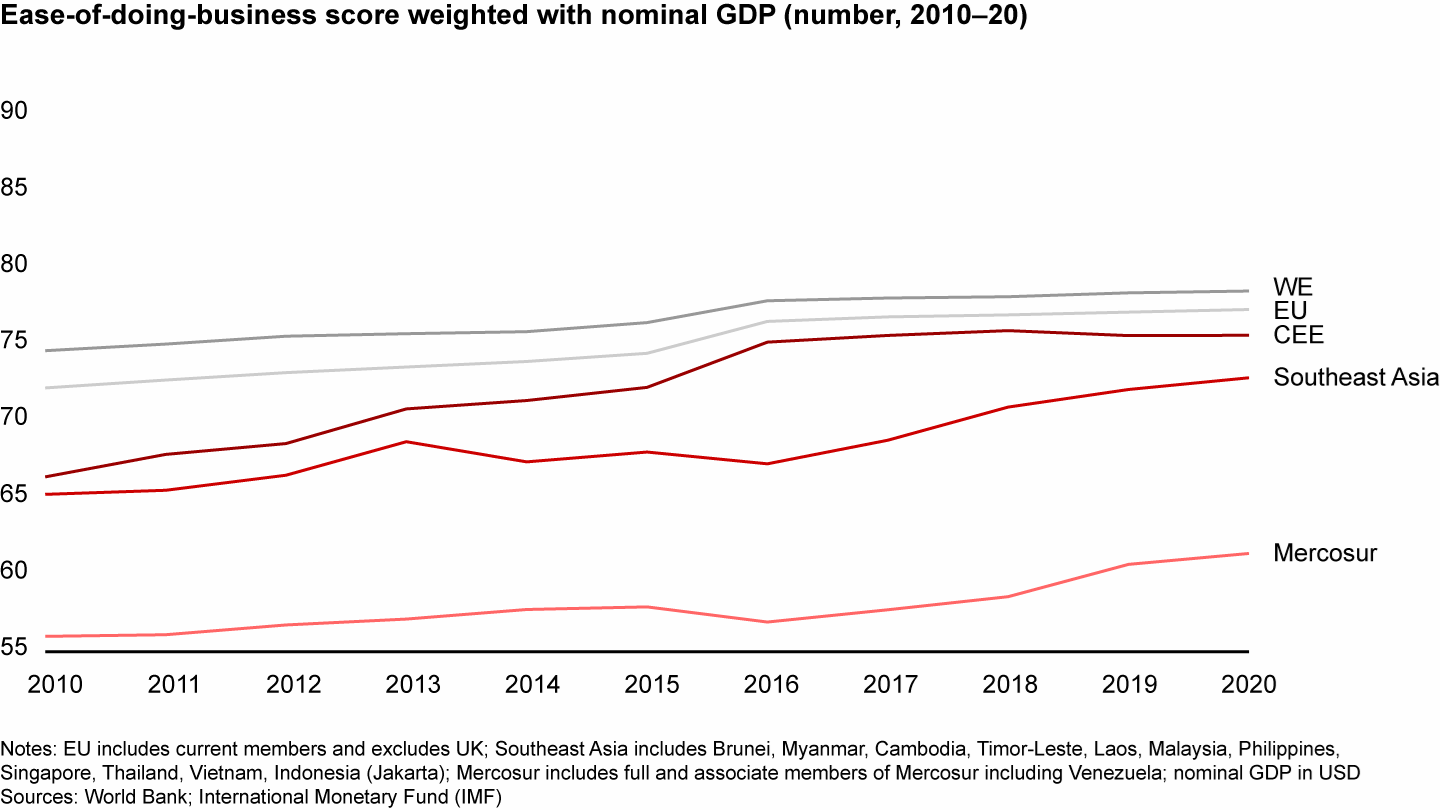
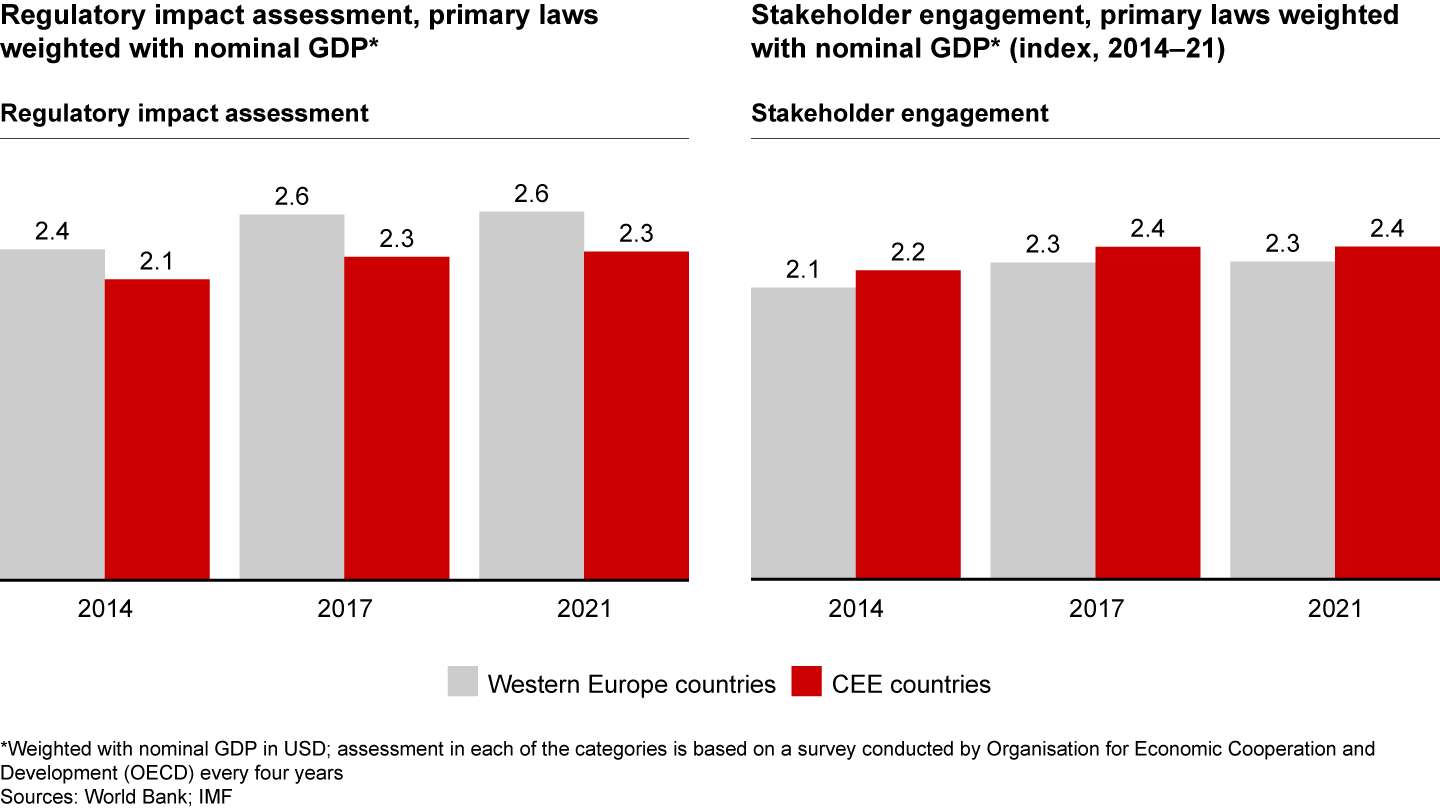
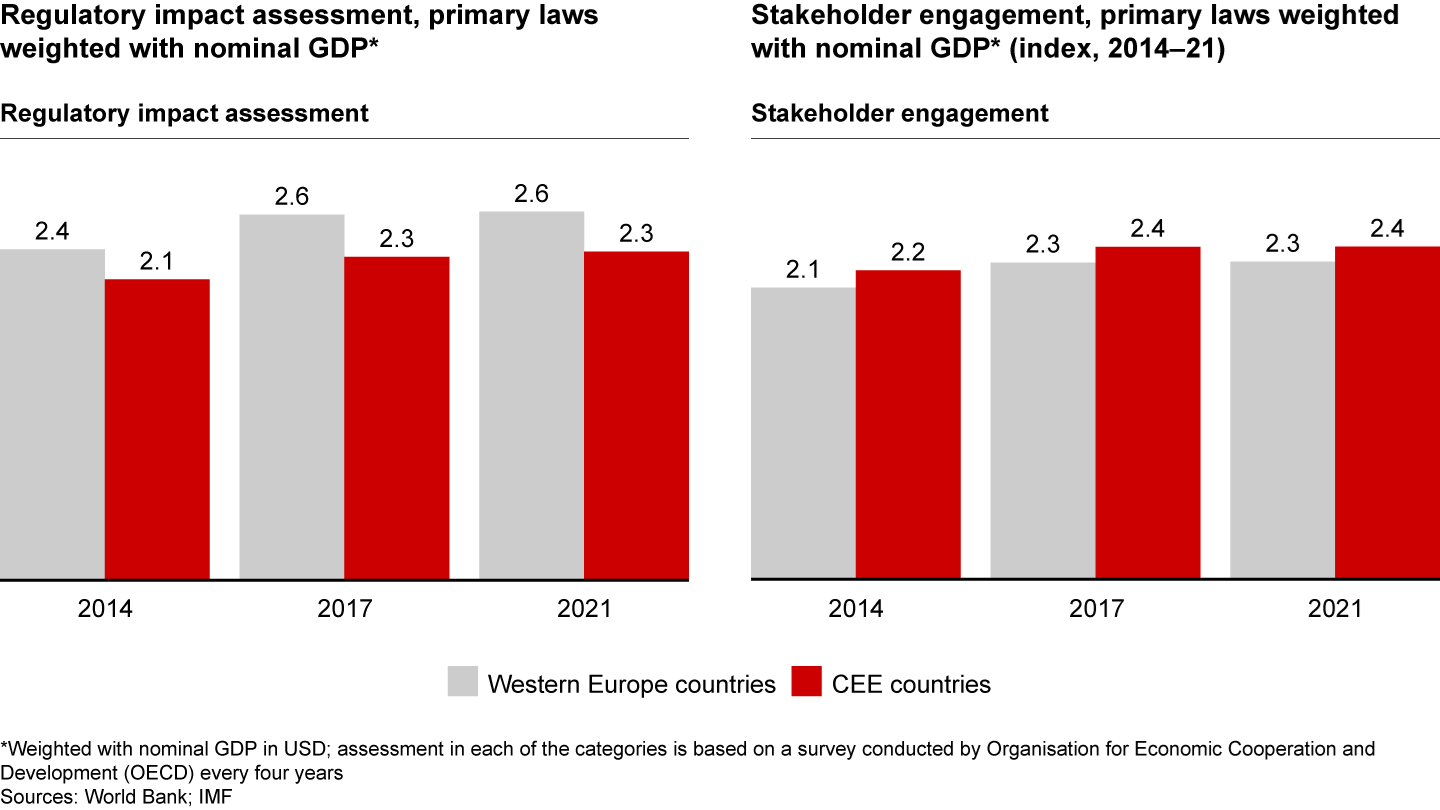
Trend: Nearshoring and reshoring
CEE is already a nearshoring hub for business services and is now in the spotlight for manufacturing as Covid causes entire industries to rethink their global supply chains (see Figures 10 and 11). About 68% of German manufacturers say they’re planning to diversify their supply chains after the pandemic, and 64% of US manufacturers expect reshoring. CEE countries took six of the top seven spots in the 2020 Nearshoring Index from Savills; major corporates with planned or completed investments to nearshore manufacturing into the region include German engineering and technology group Bosch, French sporting goods retailer Decathlon, and German carmaker BMW. PE funds are already getting in on the action. We discuss examples of nearshoring plays later in the report.
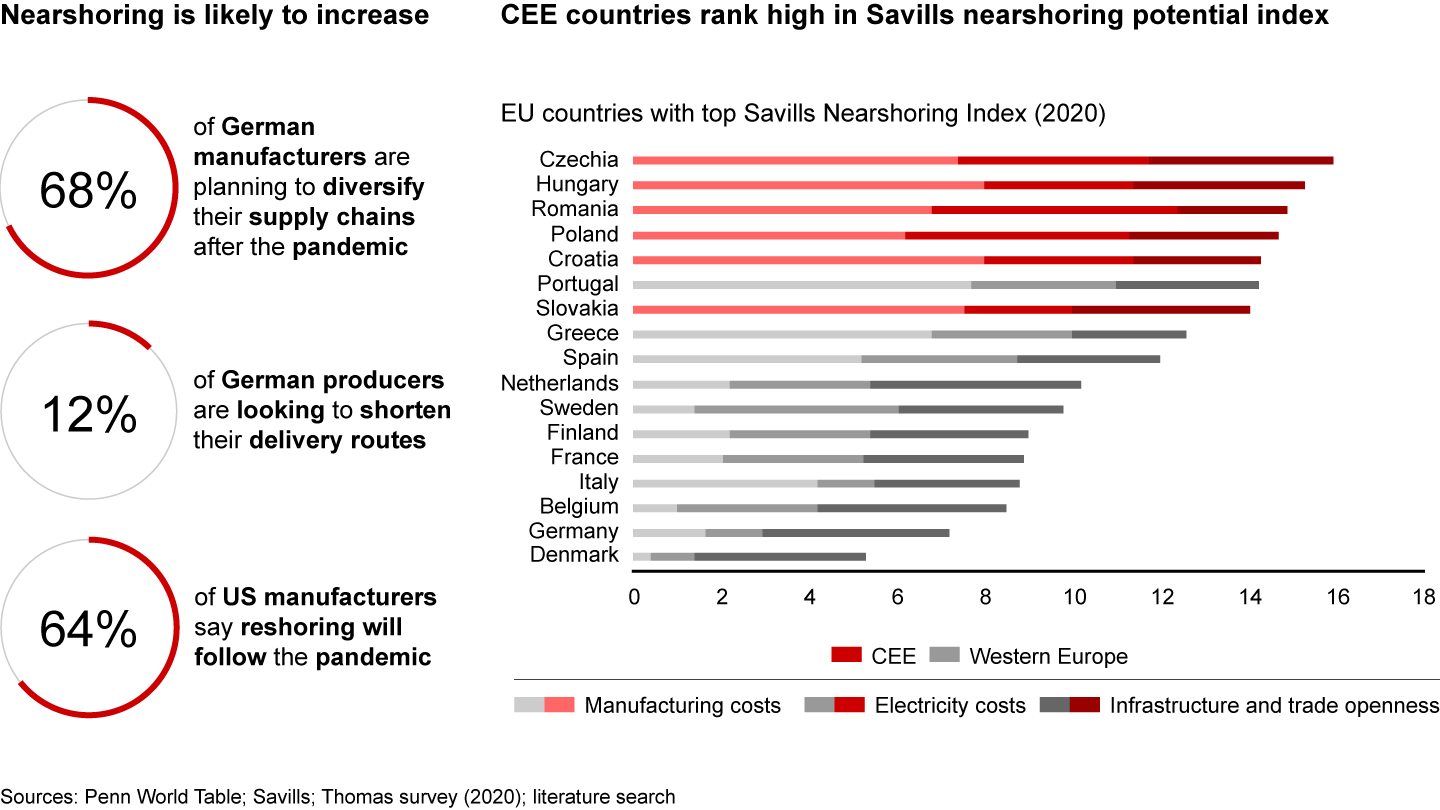
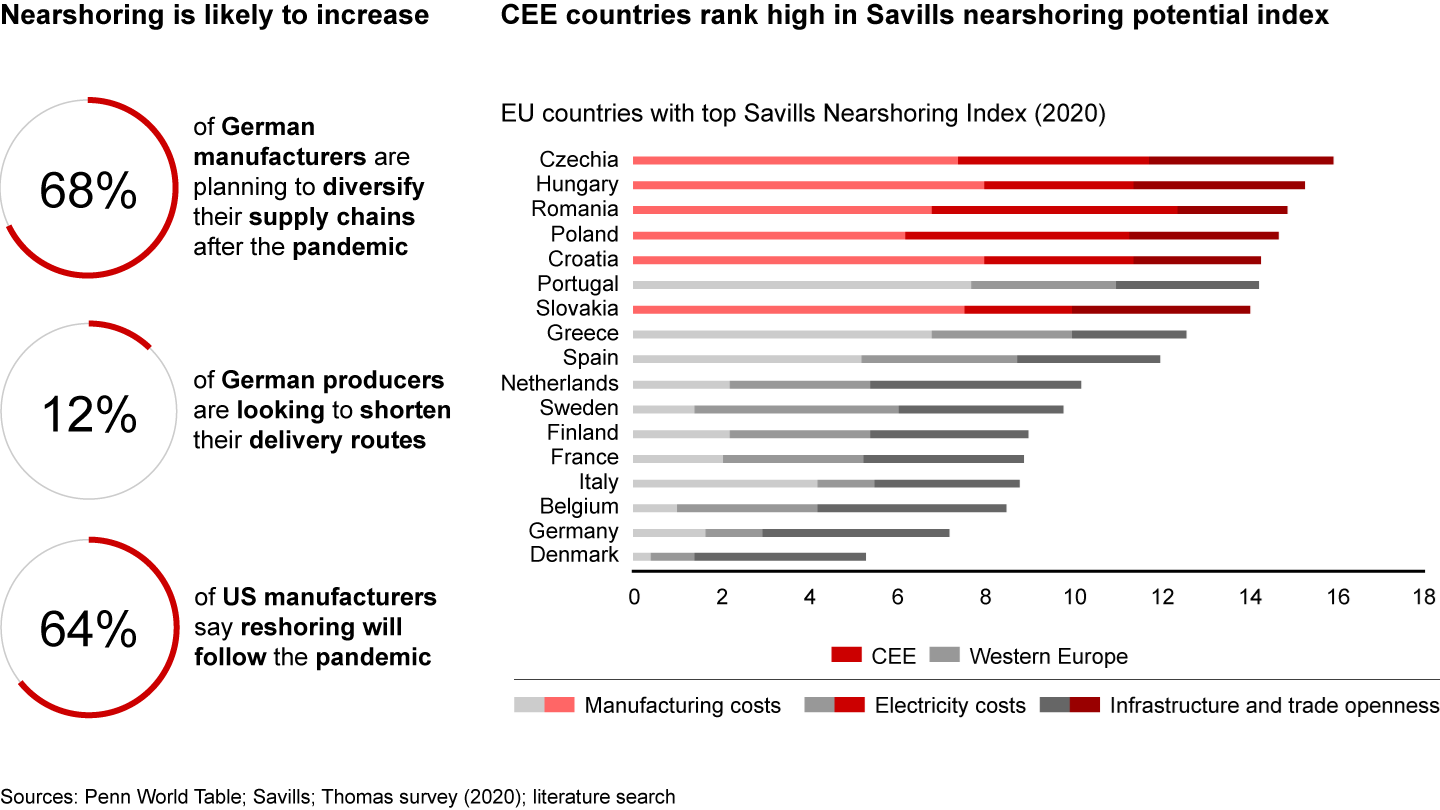
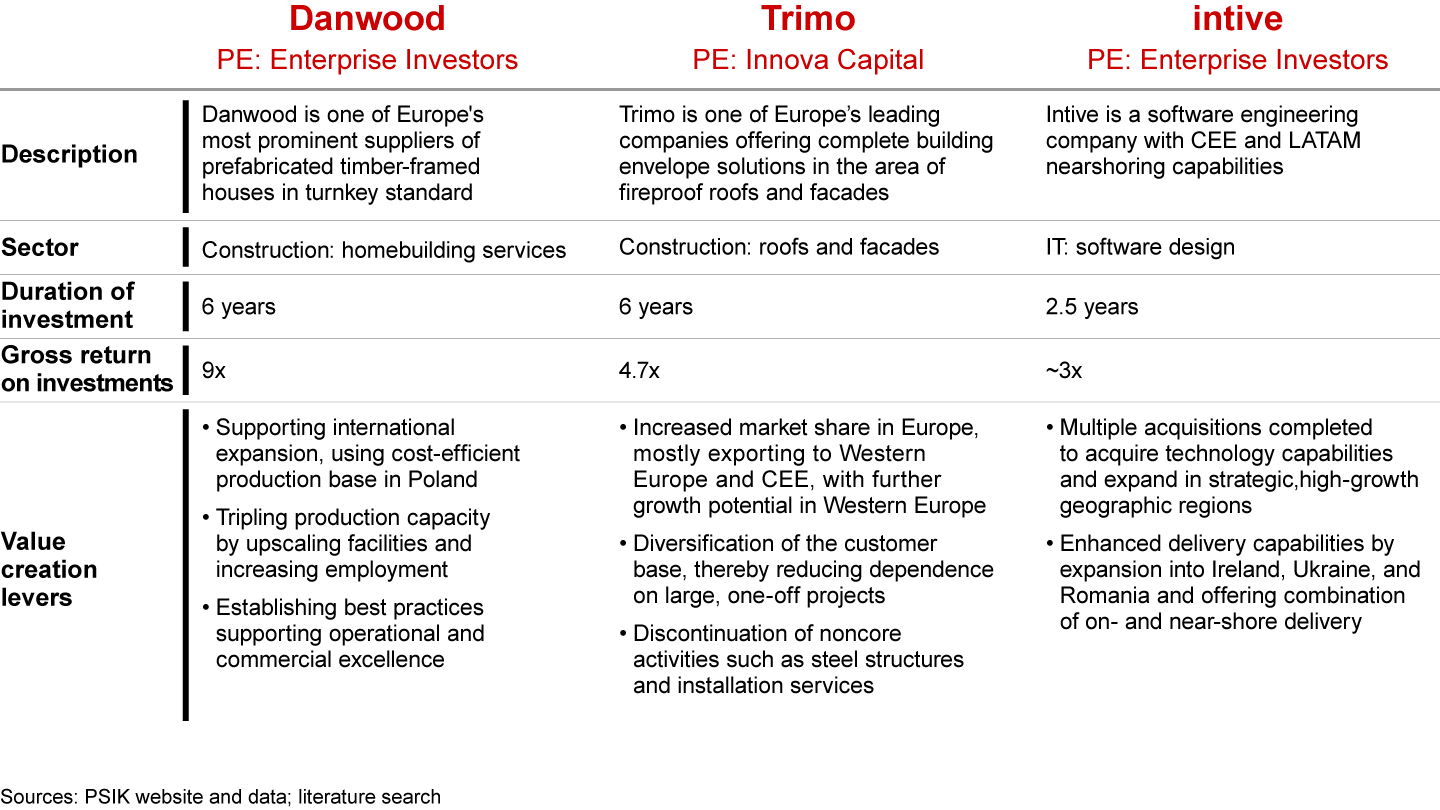
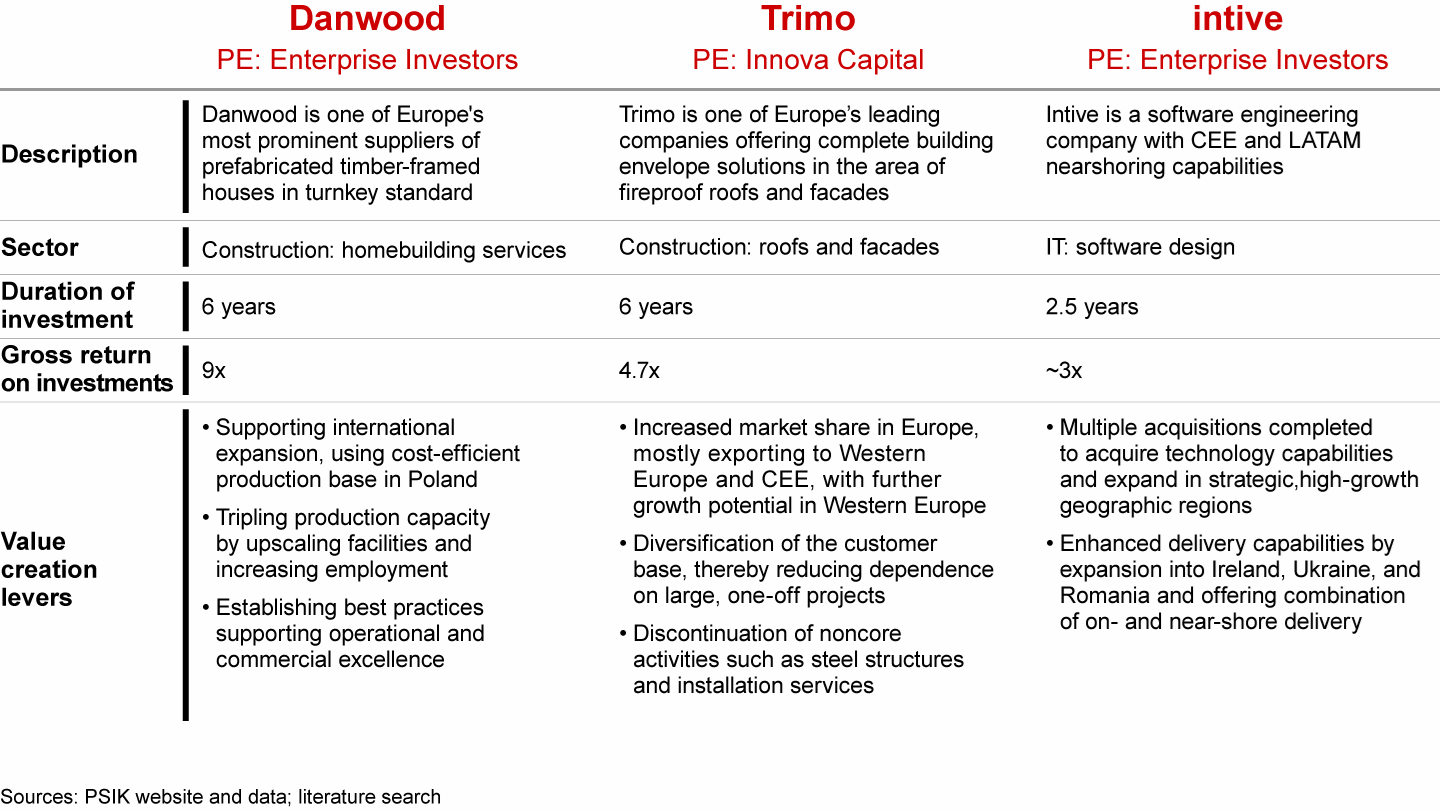
Trend: Consolidation and internationalisation
Companies in the region are on average smaller than their counterparts in Western Europe, indicating higher fragmentation within sectors and greater potential for consolidation (see Figures 12 and 13). A higher share of people in CEE work for companies with fewer than 250 people, and the average number of employees per company remains lower, compared with that of Western Europe.
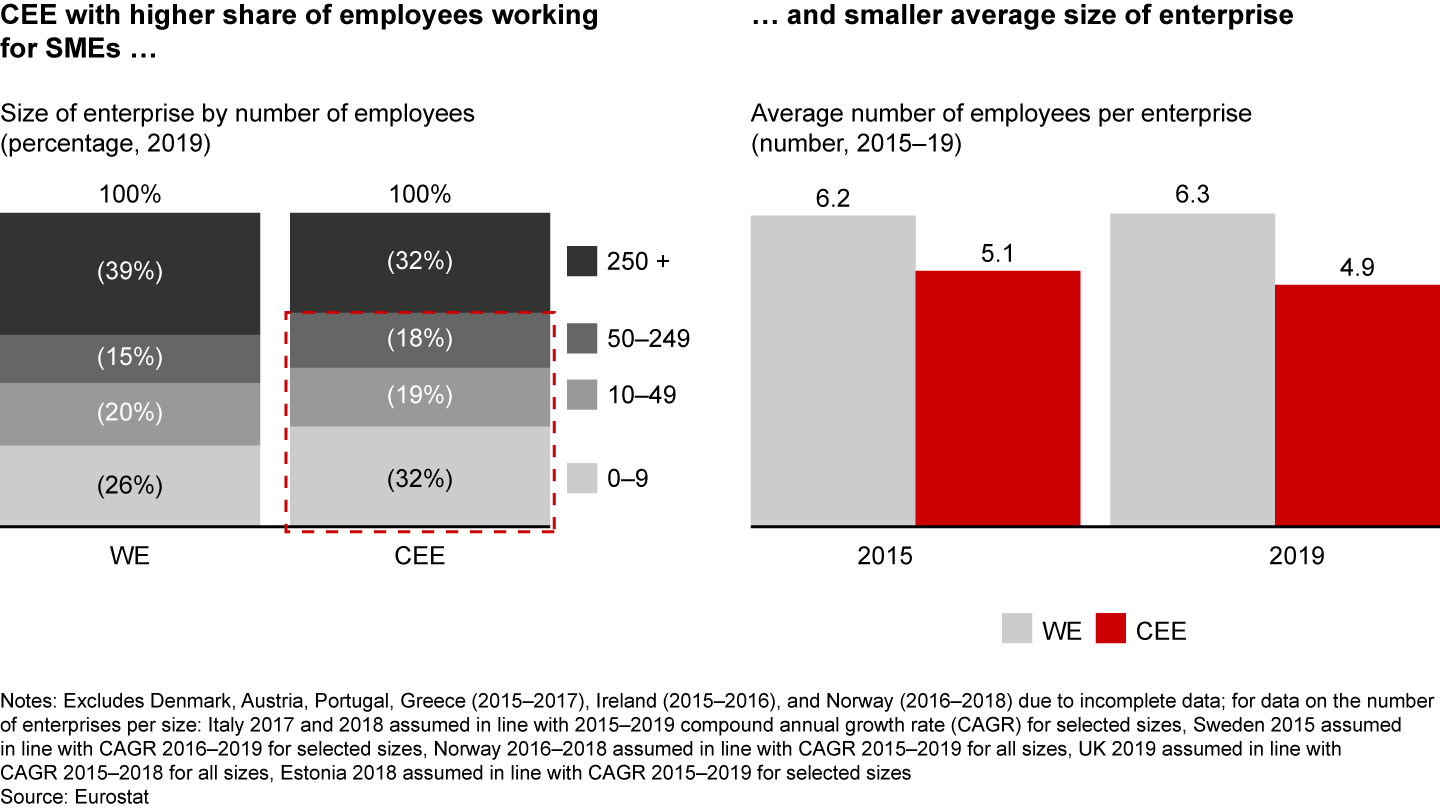
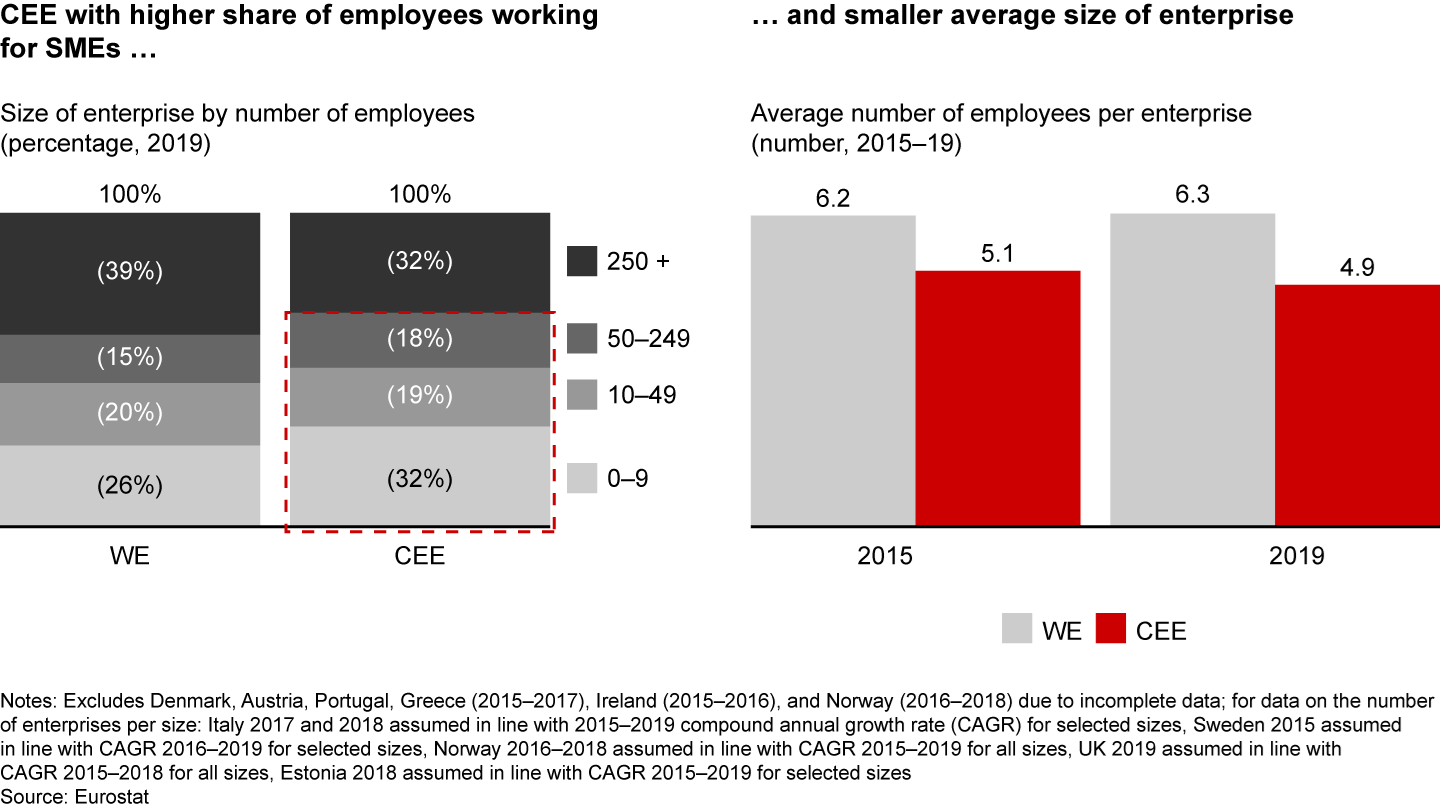
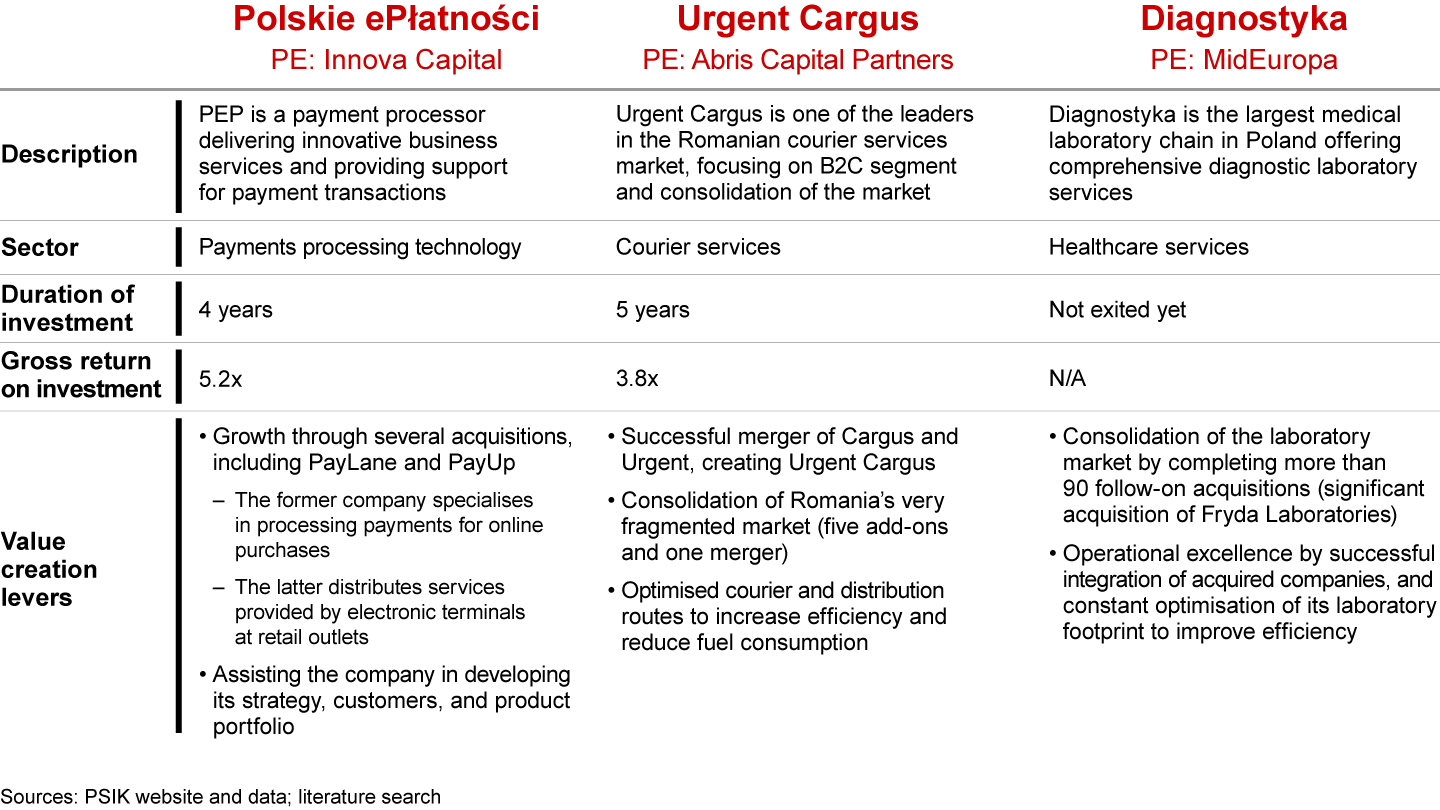
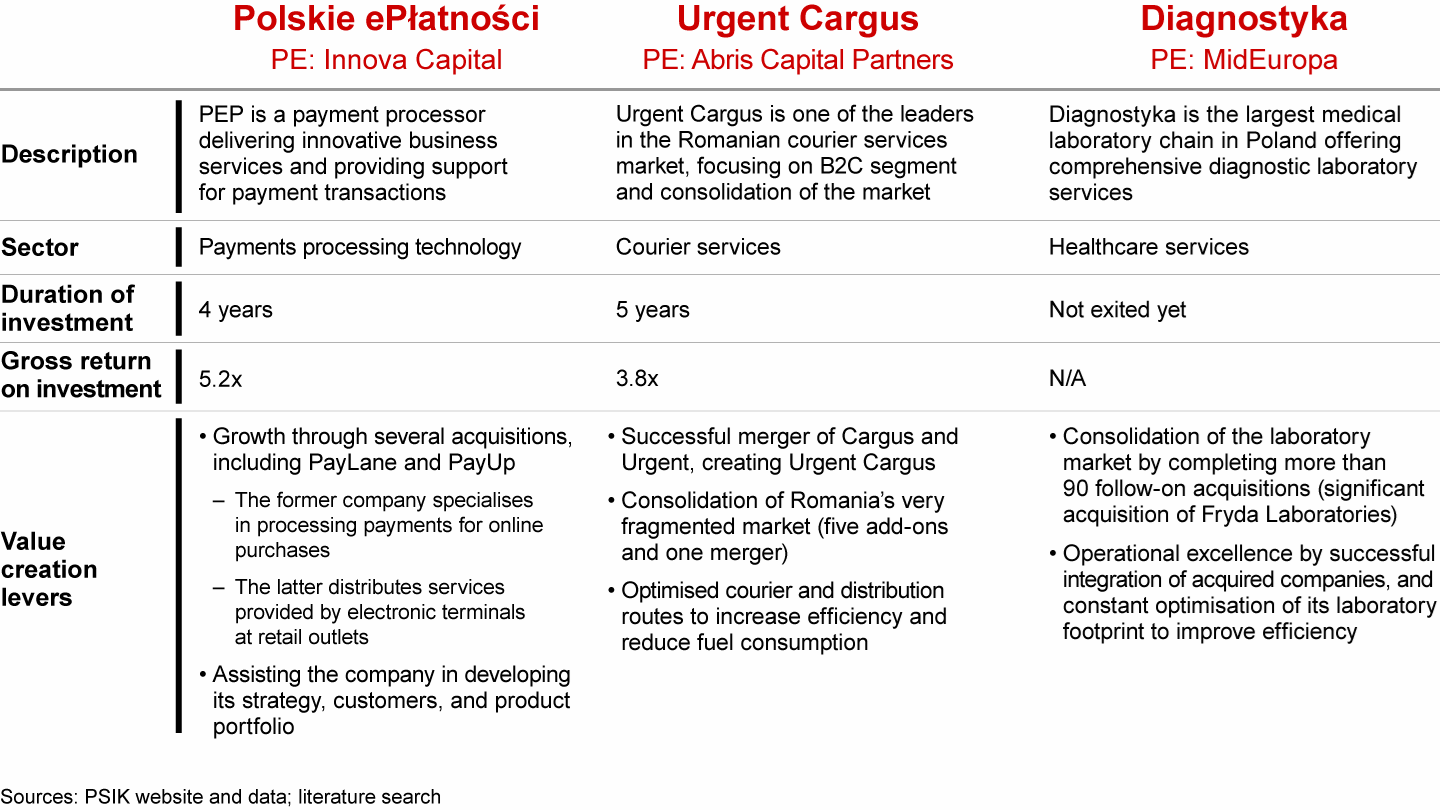
In addition to mentioning space for consolidation, 33% of respondents to a survey carried out by Bain & Company among leading private equity funds in CEE chose cross-border integration within CEE as the most important trend in the region, with the same share identifying international expansion of local companies.
“I would certainly be more willing to buy a CEE regional champion than a single-country-focused player,” a partner at an international GP told us. “The issue is that there are not many such opportunities. If the local GPs can step in and create them, they should be able to earn a premium.” And a senior partner at a CEE-based GP points out that international corporations are dissuaded from organically scaling across the region by factors including small domestic markets and language barriers, and thus are ready to pay a premium to buy a regional player that gives them access to several markets with a single transaction. Some PE funds are building regional champions (see Figure 14).
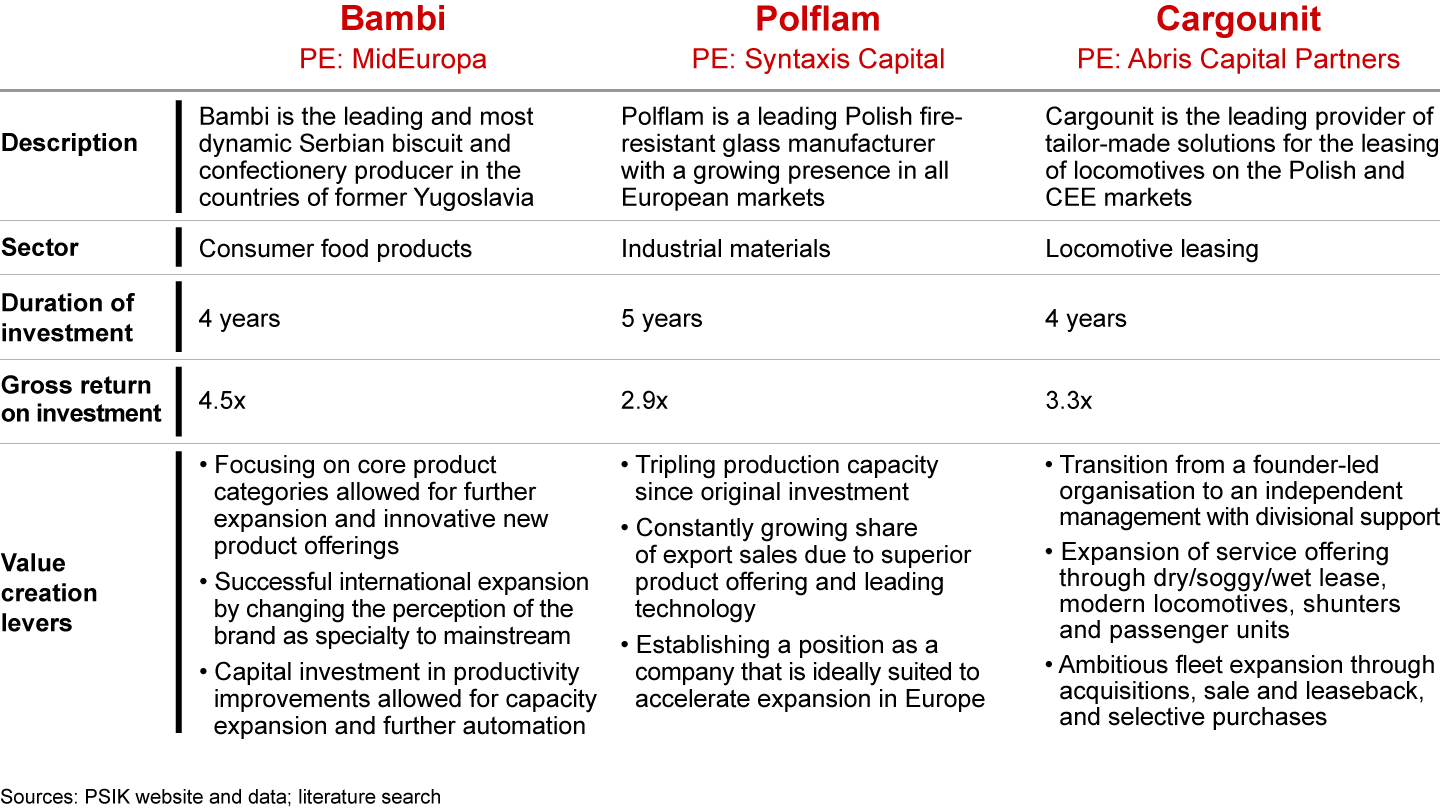
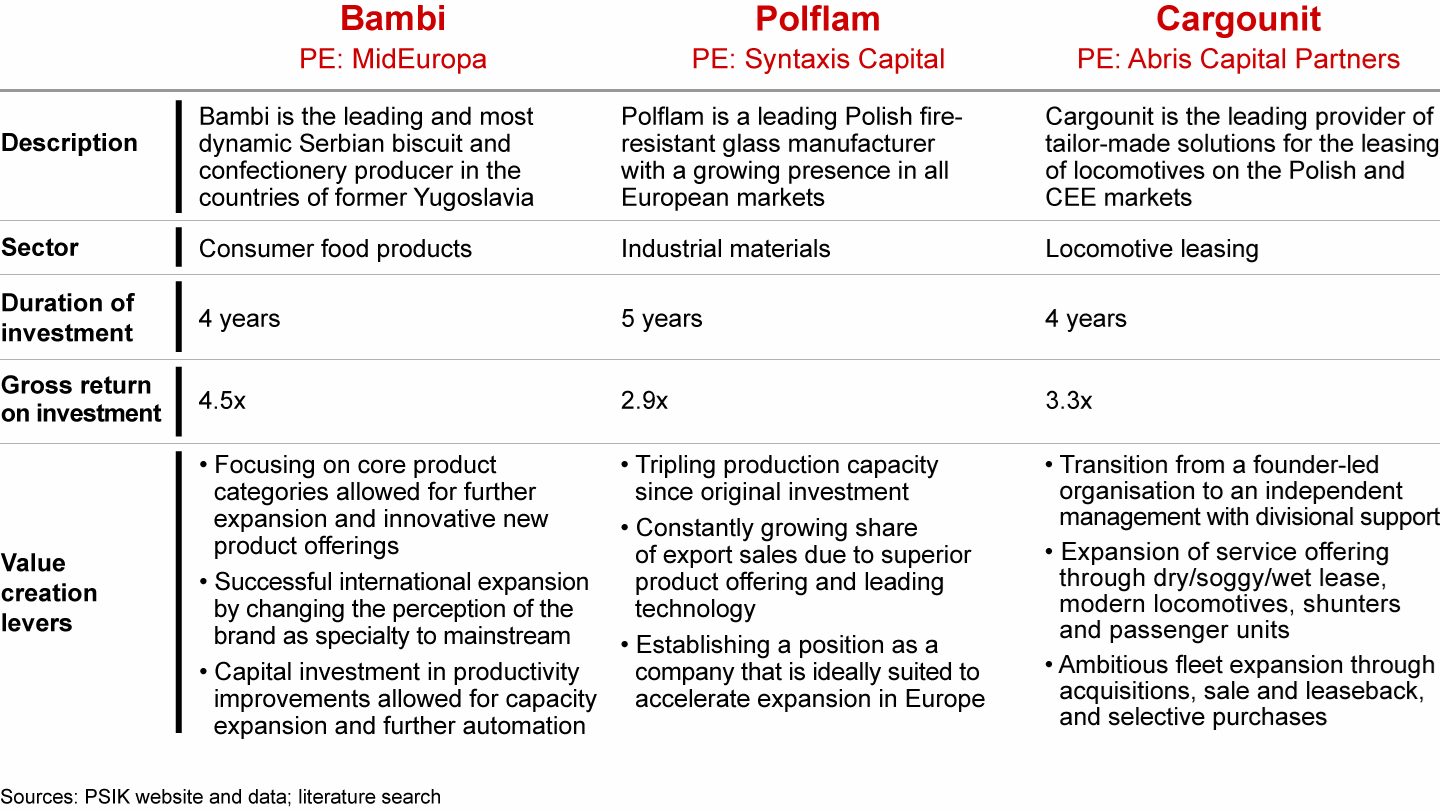
In addition to those champions, CEE also boasts global players such as mobility company Bolt, communications provider Skype, and financial services app Wise, all with roots in Estonia (the smallest of the 11 countries); Hungarian software maker Prezi; and Polish games developer, publisher, and distributor CD Projekt.
Trend: The green transition
The region’s transition to a low-carbon economy is one of the priorities for EU funding, in line with the bloc’s objectives, and CEE will receive a disproportionate share of EU funds in this area (see Figures 15 and 16). The share of renewables in the energy balance has been growing across the region, receiving a boost from the need to give up Russian fossil fuels following the country’s invasion of Ukraine in February 2022.
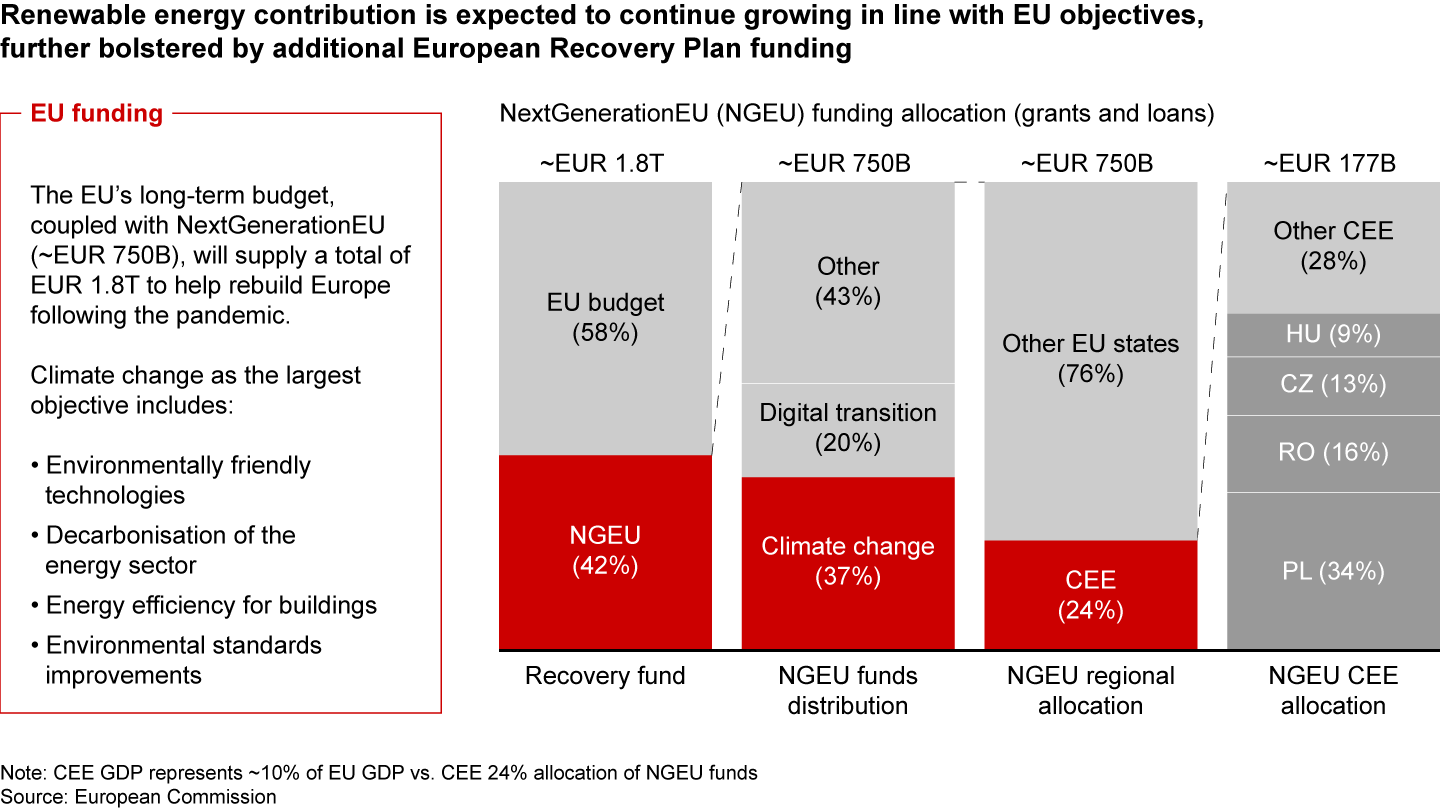
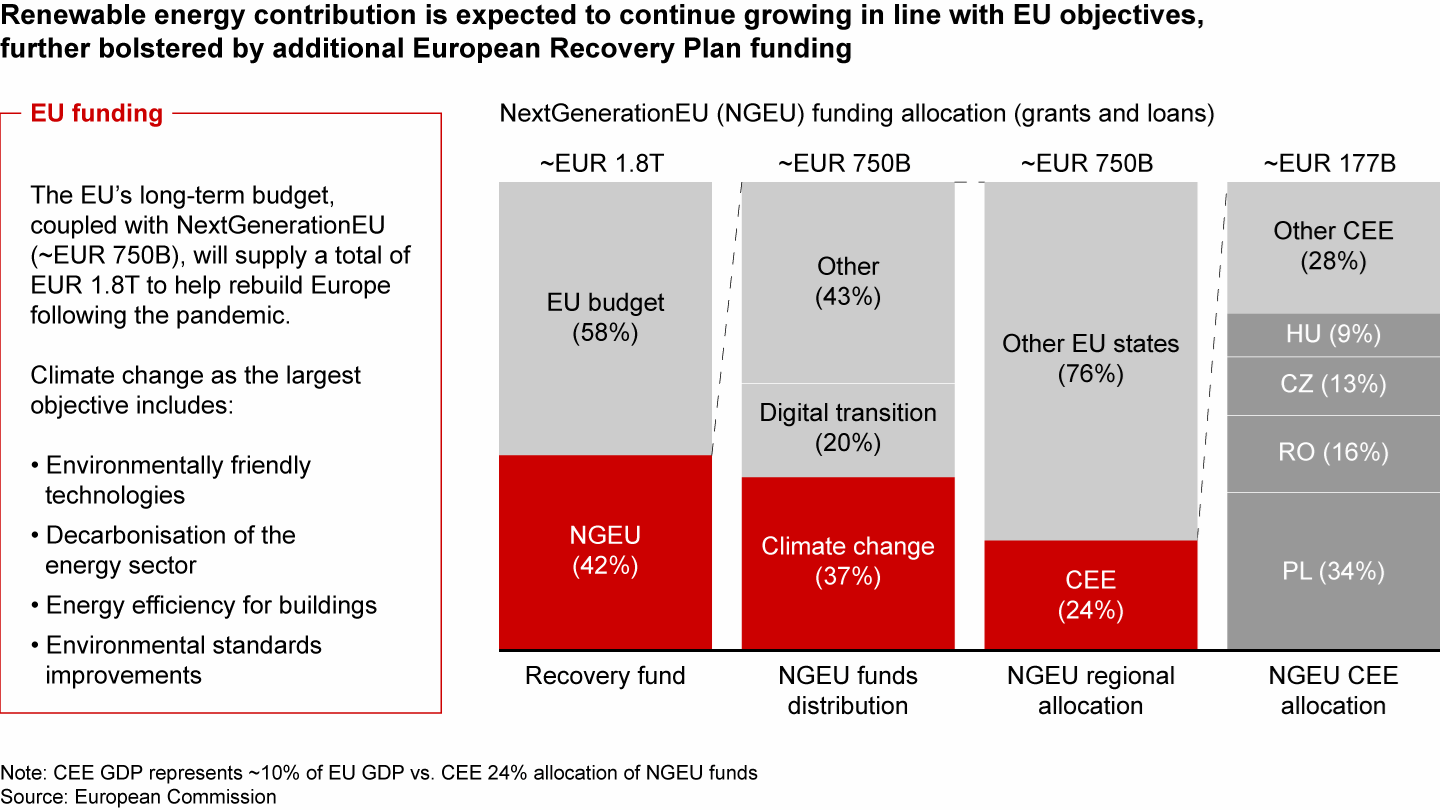
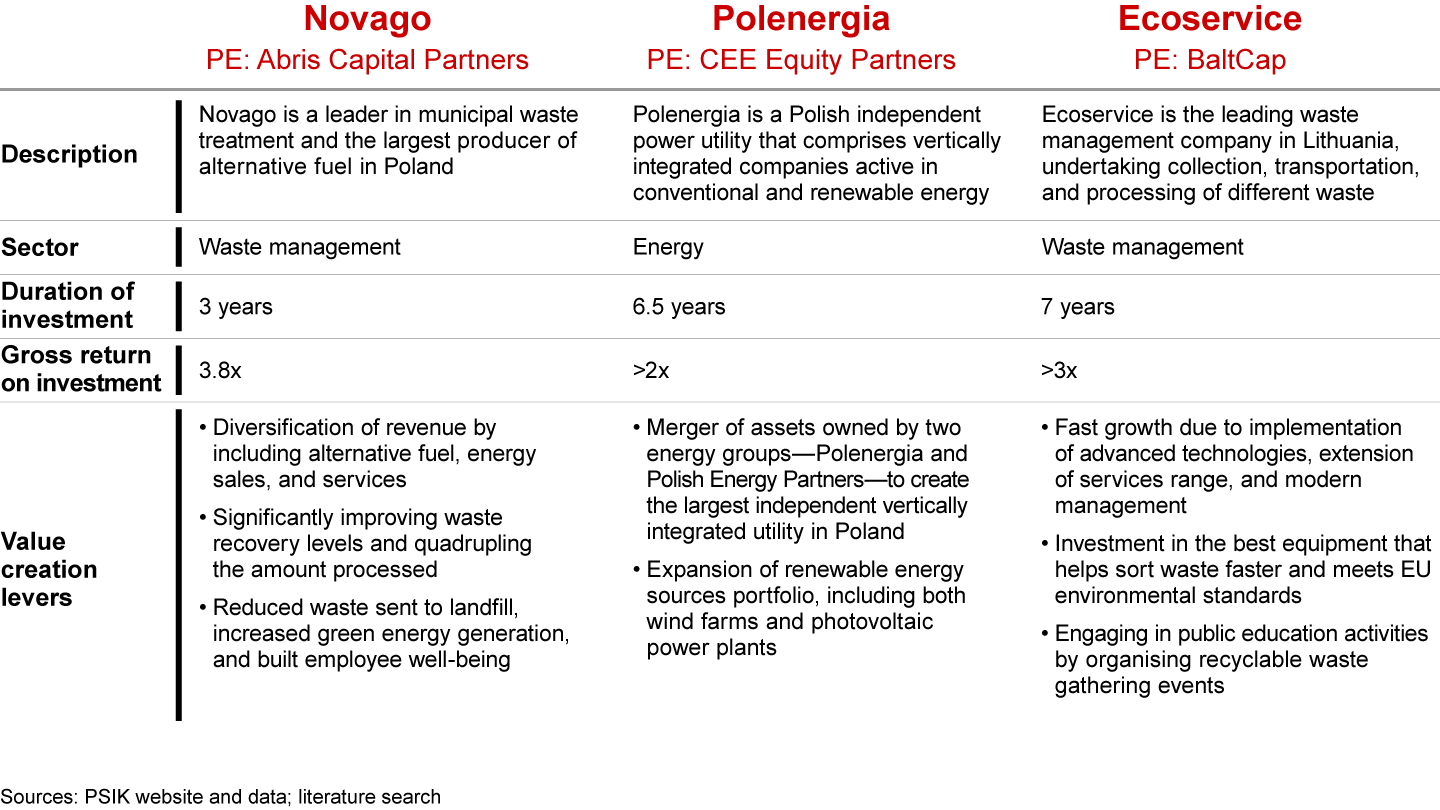
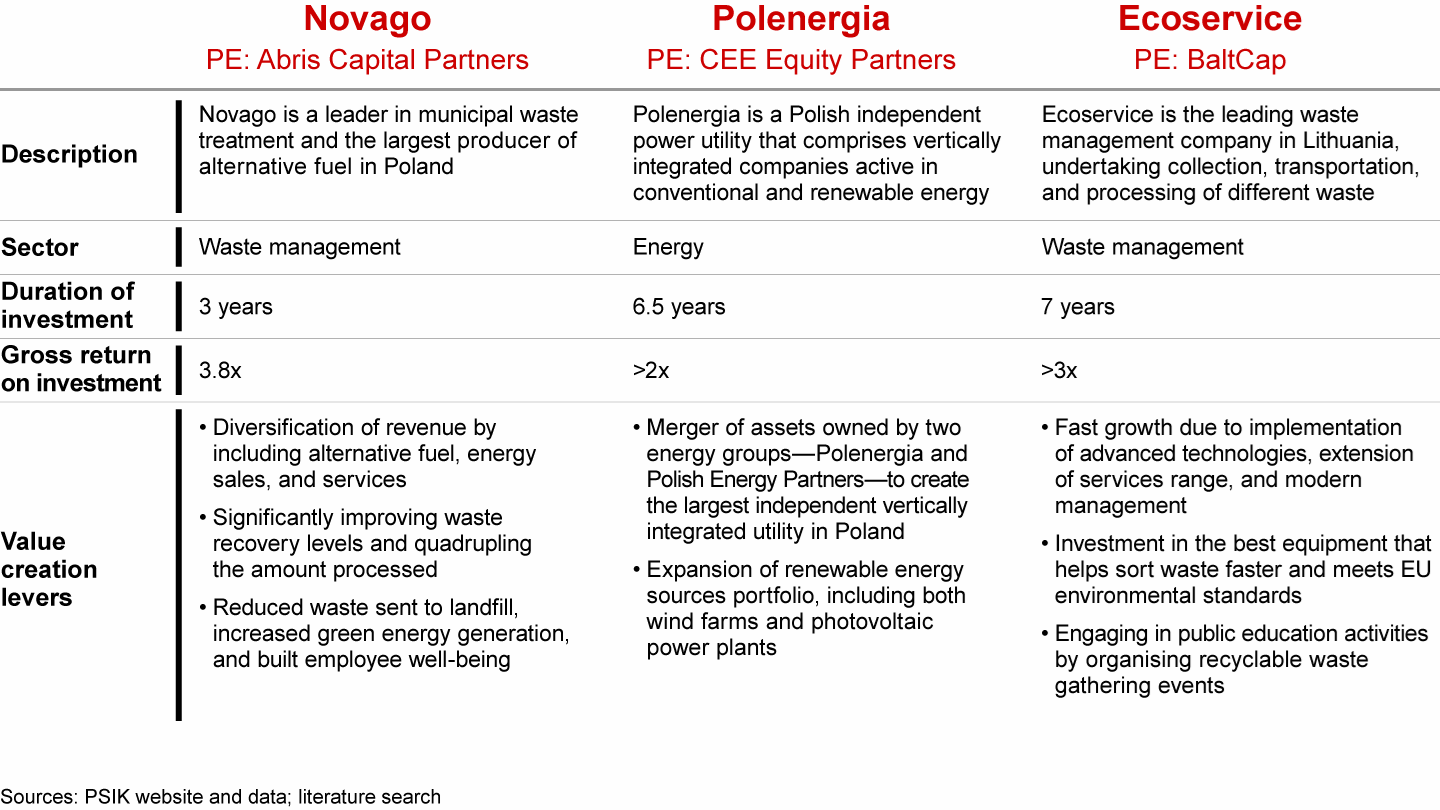
Headwinds: The coming global slowdown
Despite this generally sunny outlook, there are of course some clouds on the horizon (see Figure 17). Leading indicators foreshadow turbulence for the entire global economy. Within the eurozone, the worst performance since the global financial crisis may be in store (see Figure 18). Meanwhile, central banks’ ability to respond by cutting rates is limited by accelerating inflation.
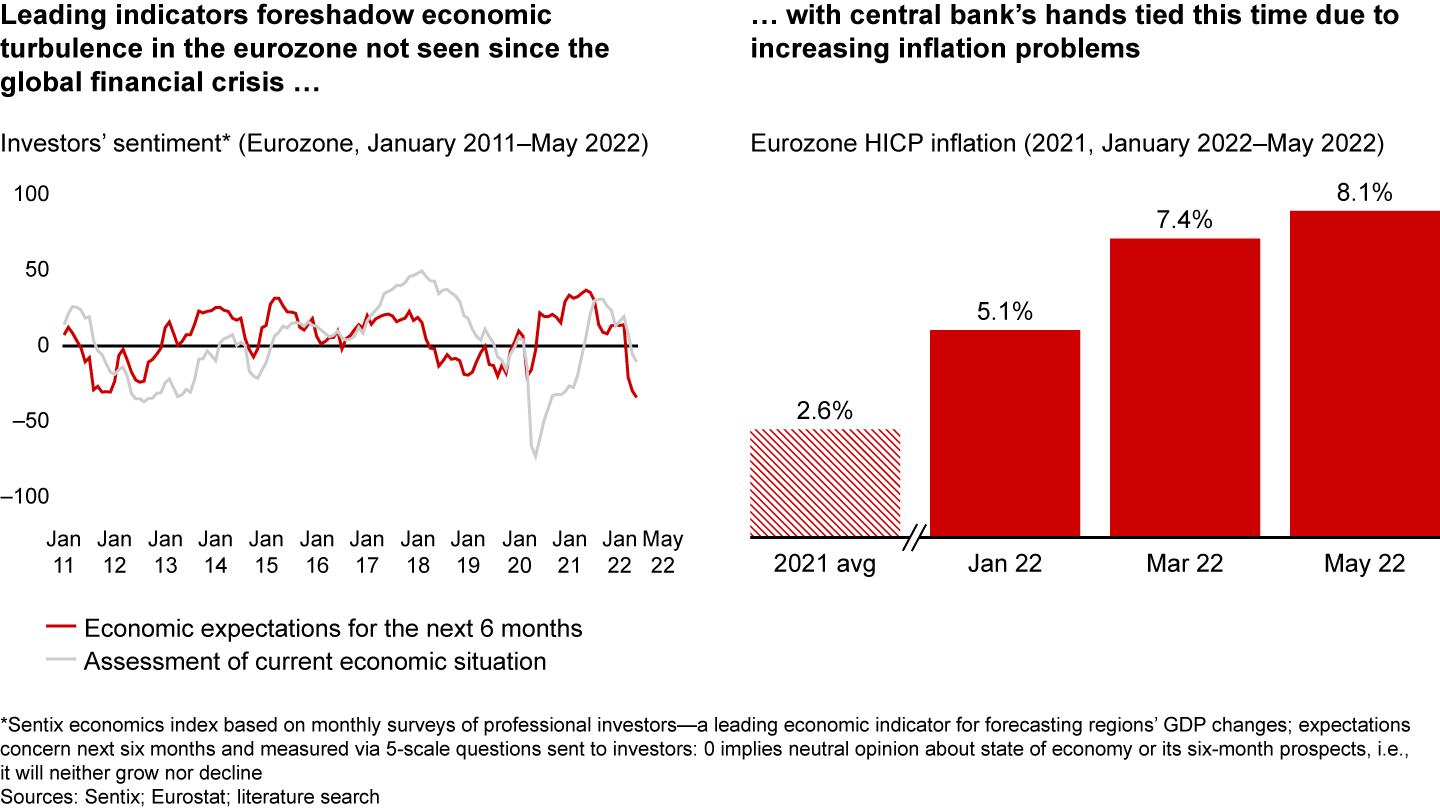
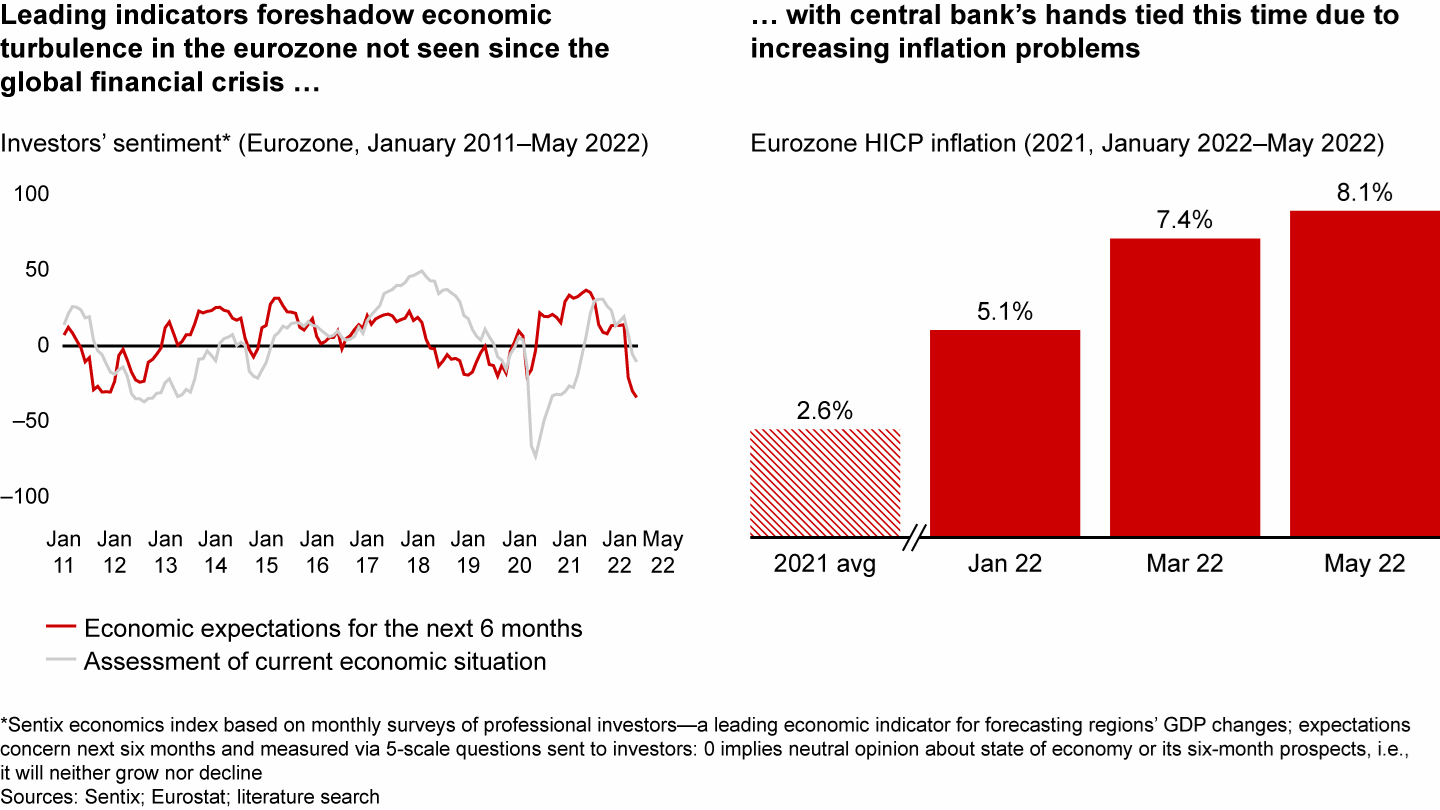
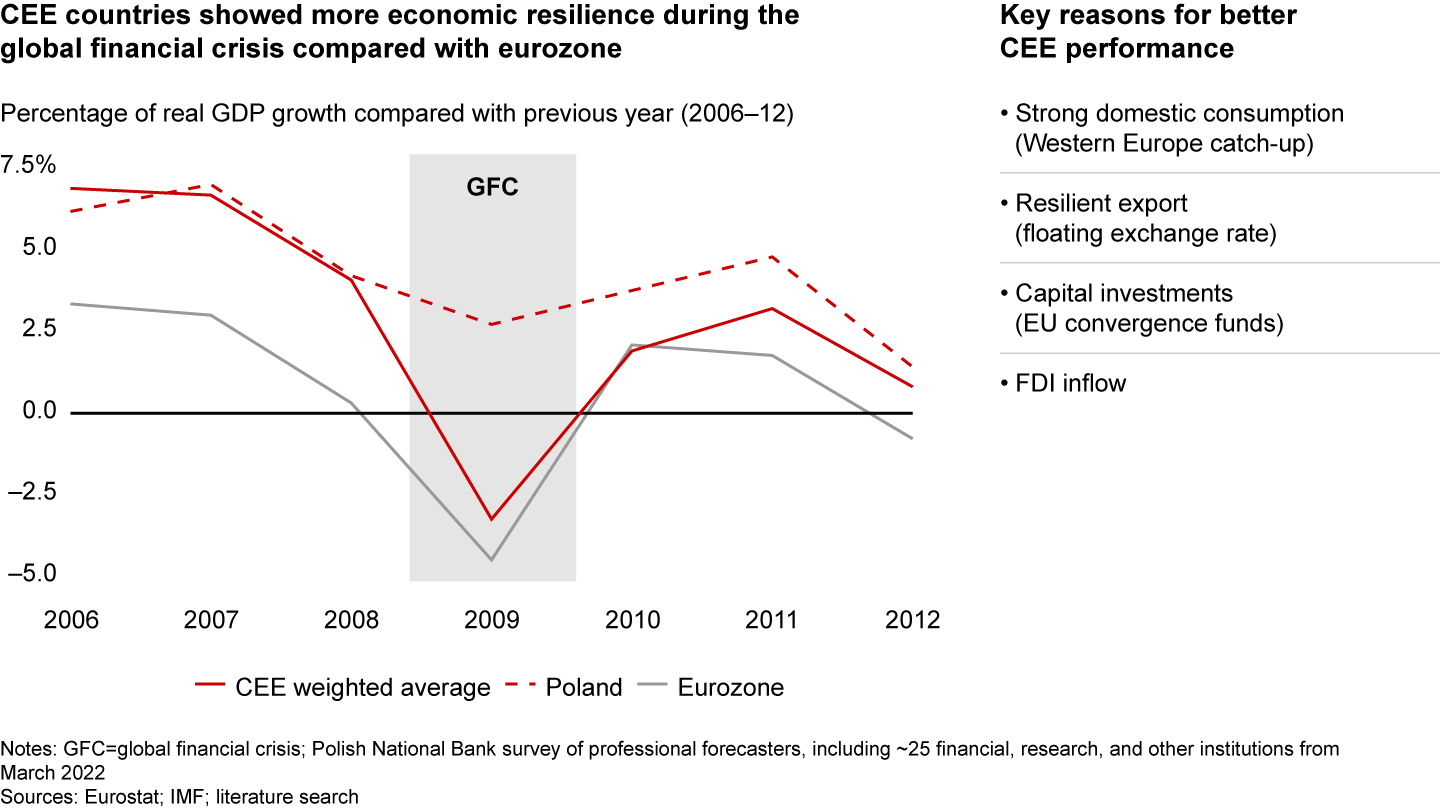
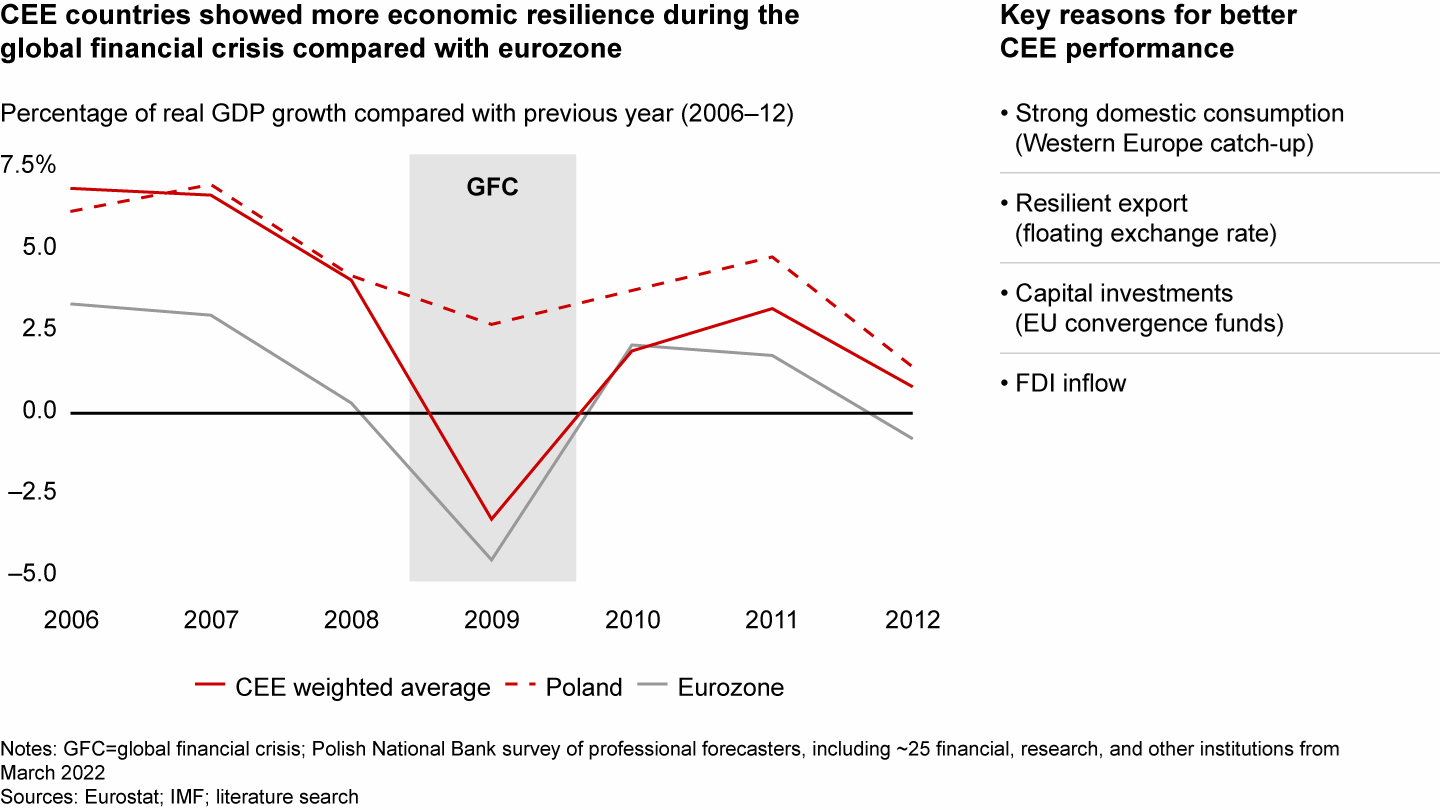
Still, during the previous downturn, CEE countries proved more resilient, with Poland coming through the crisis as the only EU state that avoided recession. Here too the story of convergence with Western Europe is the dominant narrative, as strong domestic consumption and continued inflows of both EU funding and foreign direct investment can help blunt the effects of any slowdown.
Headwinds: The War in Ukraine
Russia’s war on Ukraine also delivered a shock to all countries in CEE, including a security crisis, inflows of refugees, and the economic effects of sanctions. Of the 11 countries covered in this report, four (Poland, Slovakia, Hungary, and Romania) border Ukraine. Poland and Lithuania also border Russia’s Kaliningrad exclave, and Estonia and Latvia border Russia proper. Several countries, including Poland, Czechia, and Estonia, have been prominent in their provision of military aid.
All 11 countries are NATO members. Their Western allies, led by the US, have made strong declarations of support and backed them up by sending additional troops to the region, meaning the direct military threat is minimal (see Figure 19). Instead, the dangers are economic: higher inflation, volatile markets for energy and food, and the costs of caring for refugees.
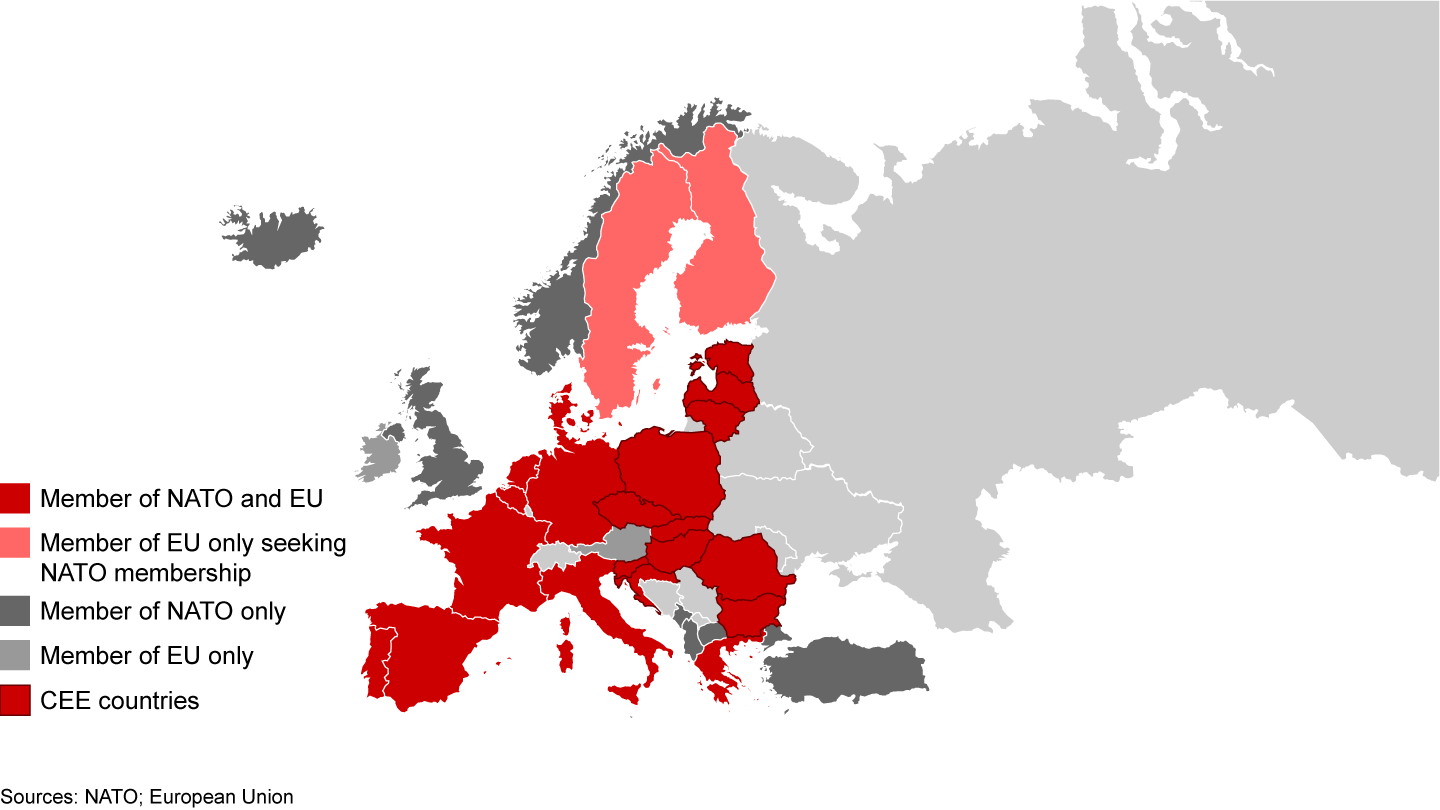
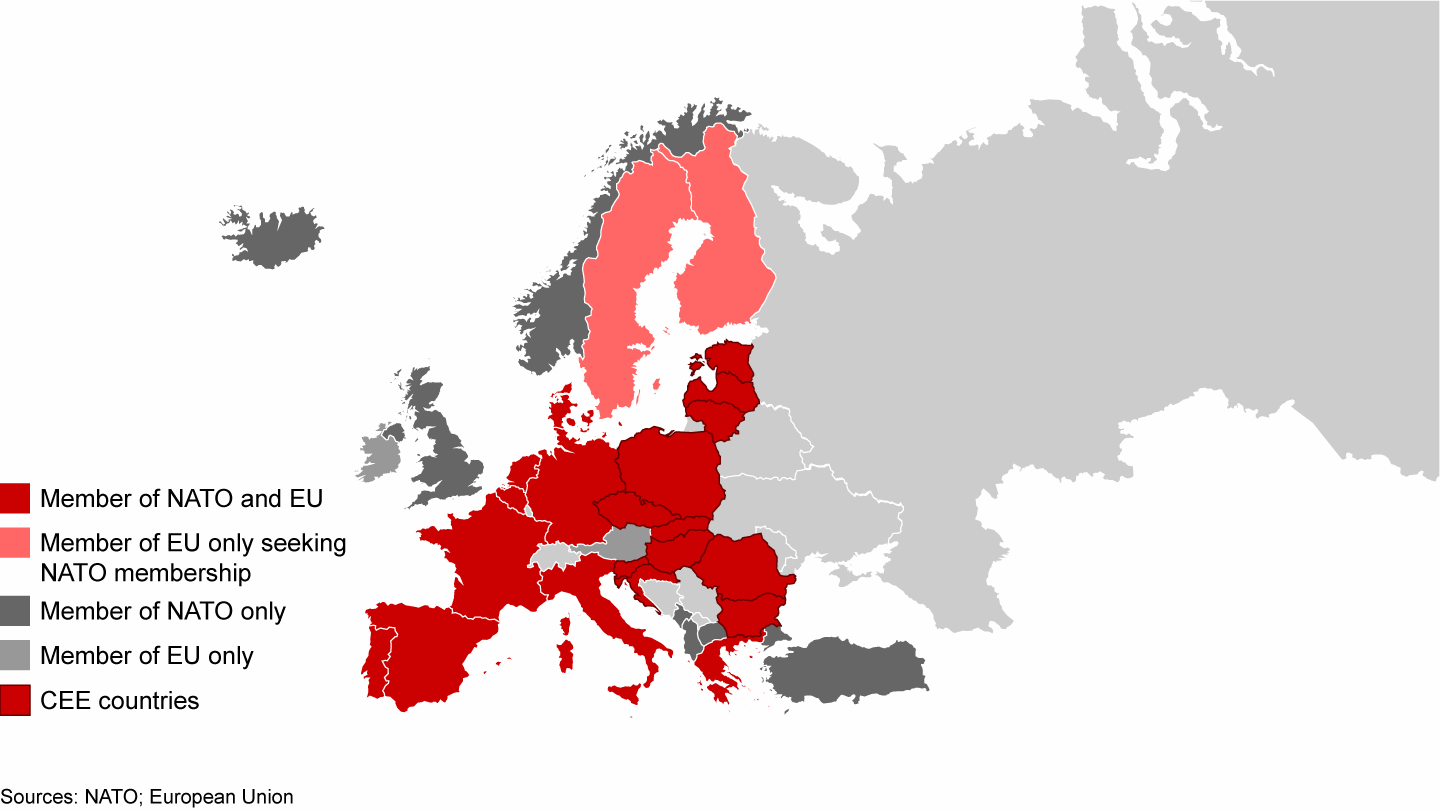
The potential benefits to the labour markets from the presence of refugees have so far been limited: most refugees are women and are unlikely to take jobs in the construction and logistics sectors that have lost workers as migrant Ukrainian men have returned home to fight. Many would also need reliable childcare, and it’s not clear how long they’ll stay. In fact, many are already returning to Ukraine, with EU border agency Frontex reporting in June that more people were travelling to Ukraine from member countries than entering them.
In the longer term, the war is likely to lead to structural changes in the region’s economies, including greater military and security spending, which will benefit sectors such as cybersecurity; an accelerated transition to green energy; and the potential for long-term involvement in the postwar reconstruction of Ukraine.
Those macroeconomic factors are reflected in the findings of our survey: industry professionals are seeing a negative impact at the moment but are confident that it will be transitory. While survey respondents see a significant negative effect on fund-raising and exit options, 88% expect them to fade away by the end of 2023 (see Figure 20). They see good prospects for doing business with Ukraine once the war ends, primarily benefitting the construction, industrials, and business services sectors (see Figure 21). Overall dependence of CEE economies on trade with Russia is not large (about 3% of the region’s exports and imports). And in areas where this dependence is stronger—such as imports of natural gas—many countries in the region are better positioned than big Western economies such as Germany and Italy.
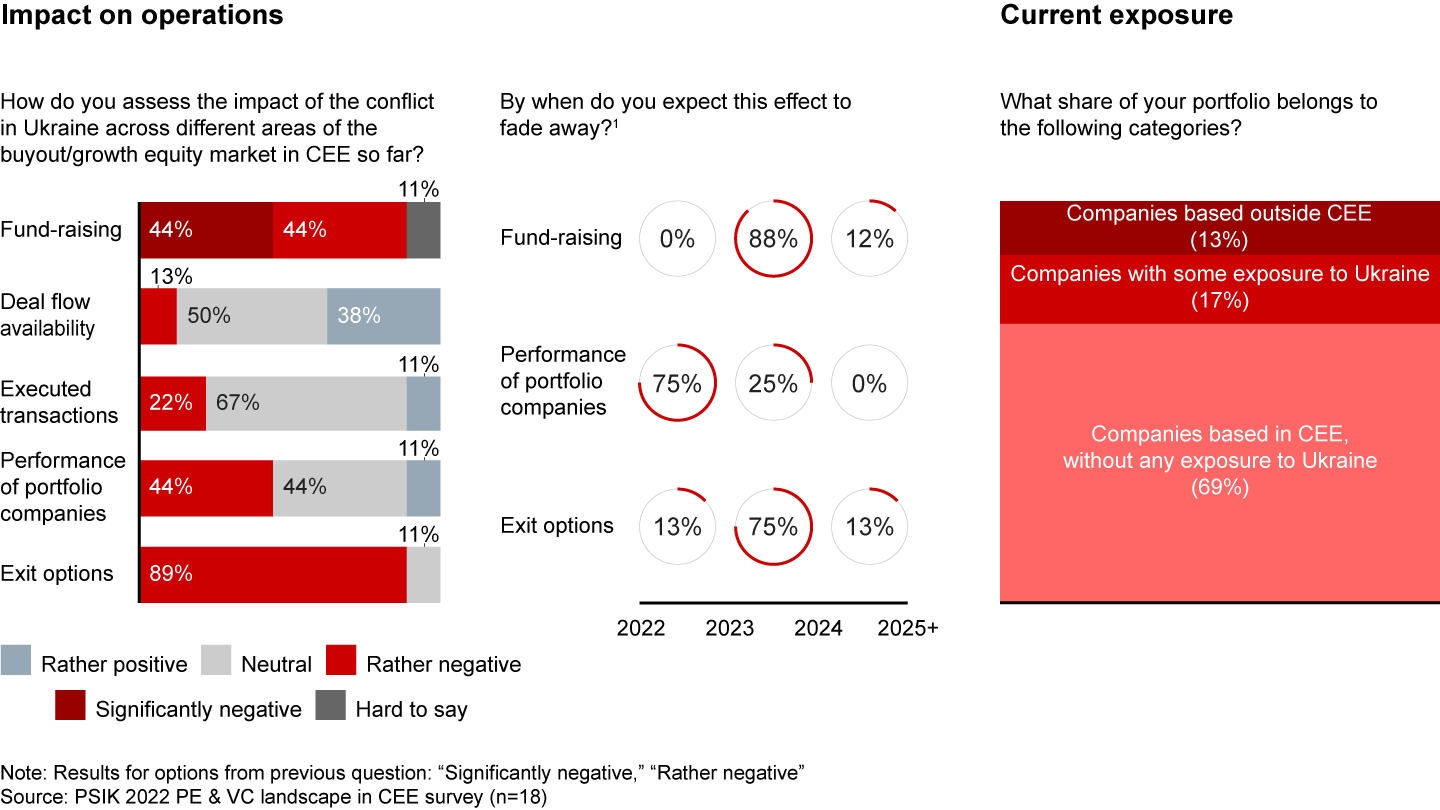
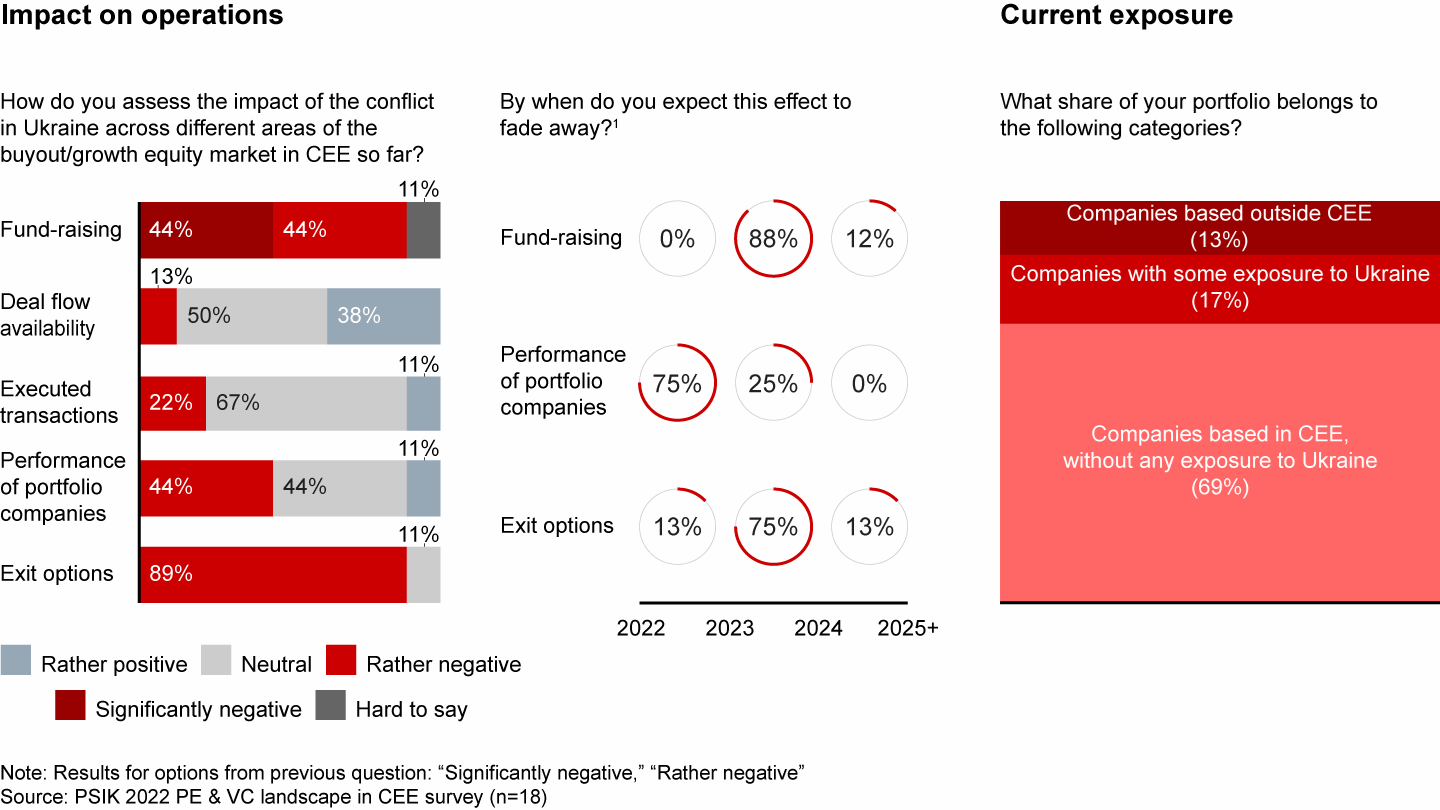
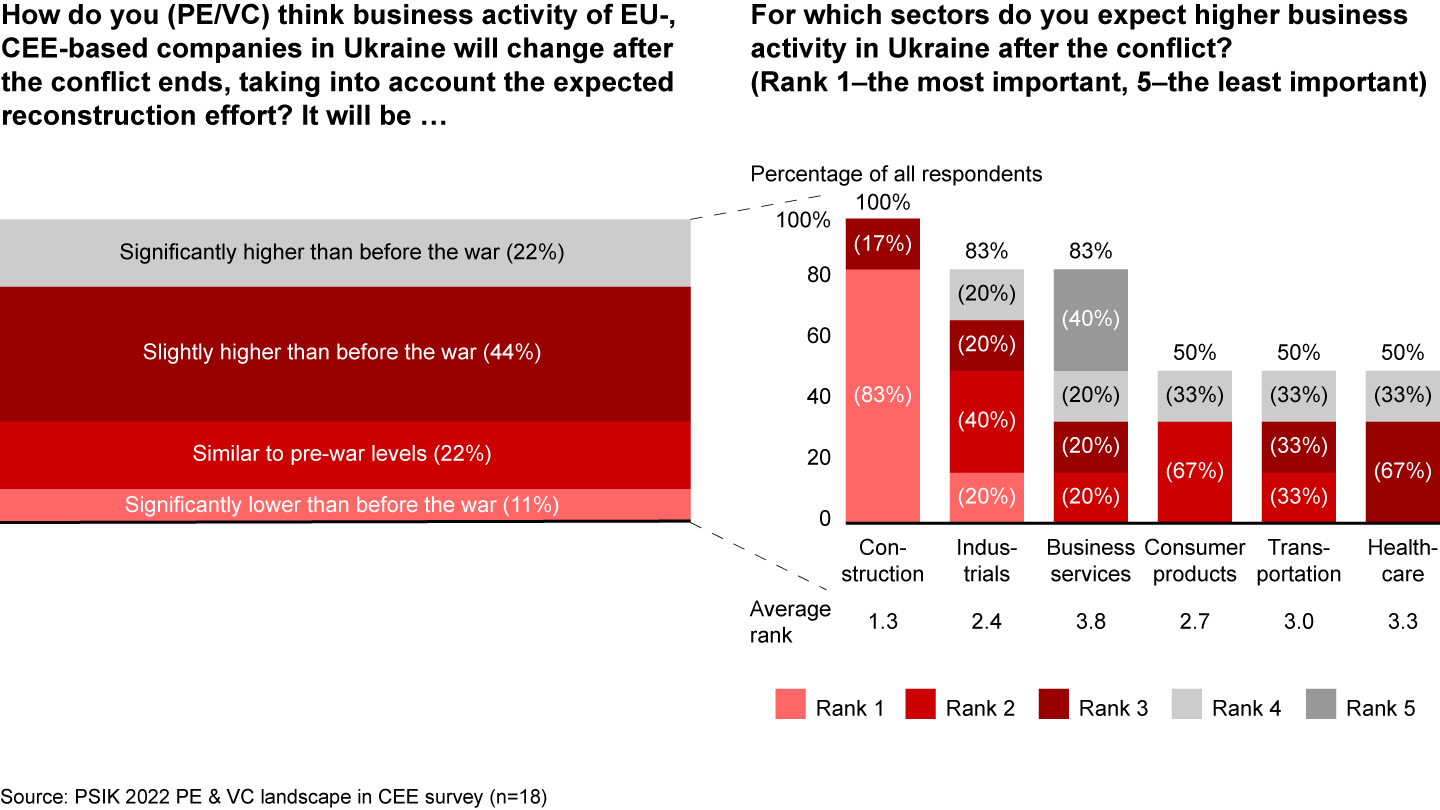
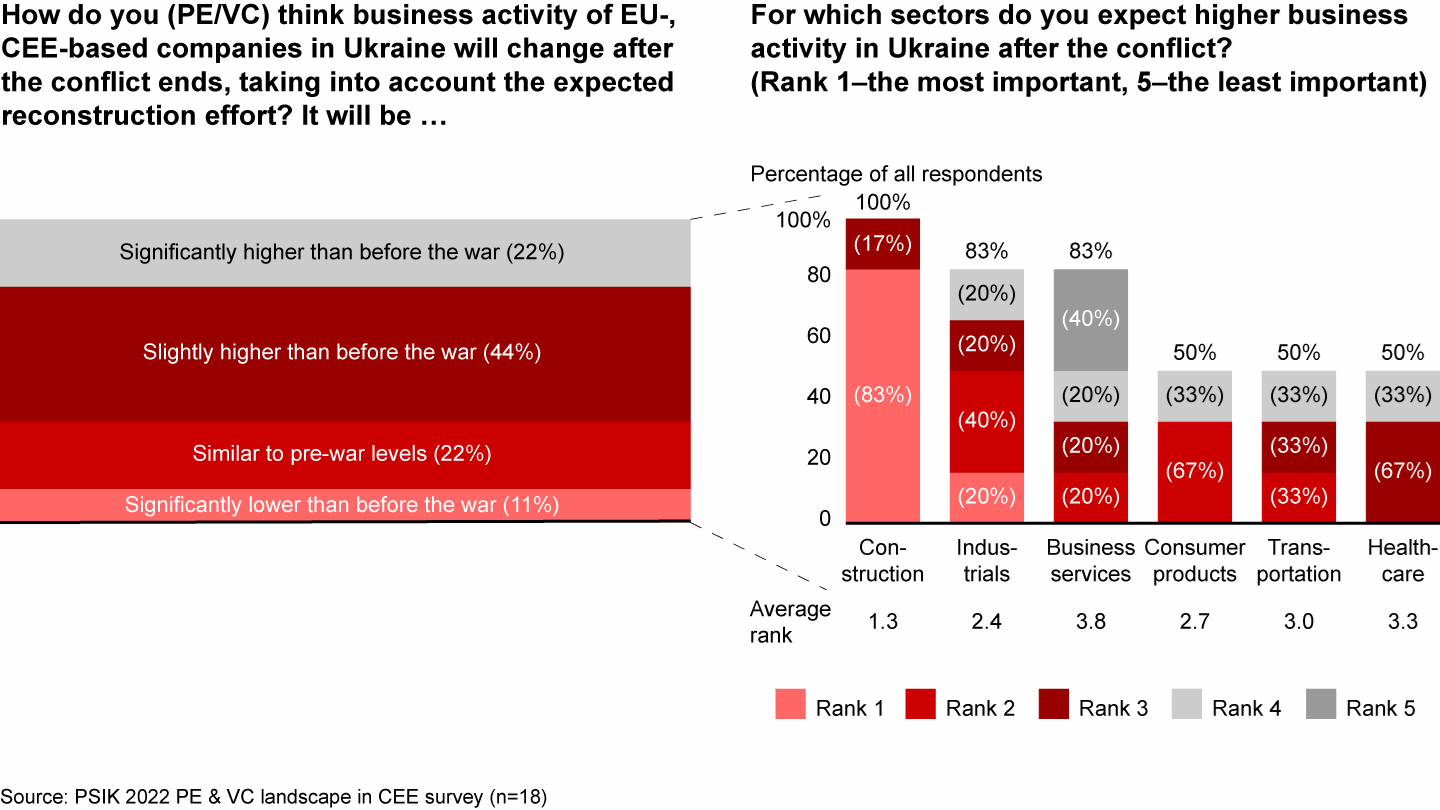
The growth story continues
Returning to our basic theme: Central and Eastern Europe is set to continue posting impressive macroeconomic growth in the long term, as factors including its deep pools of talent and physical proximity to key markets keep drawing in international investors and allowing local companies to develop. Smart investors are building regional champions that have the size and scope to make them attractive to global players looking to enter several markets with a single deal. And the European Union and NATO continue to provide credible guarantees of security and stability, and aid to develop infrastructure and fund the transition to a green economy. The difficulties investors in the region face are real—but the solutions that are emerging are just as real. The convergence story is set to continue.
Private equity: After years of waiting, it’s time to soar
Edgar Kolesnik
Vice President, Polish Private Equity and Venture Capital Association
Partner, Abris Capital Partners
As it enters its third decade as an industry, private equity in Central and Eastern Europe is well positioned for a period of sustained growth. After rebuilding from the slump caused by the global financial crisis and the euro crisis that followed, and now that the pandemic era seems to be fading, the asset class looks set to take up its rightful place in the economic landscape, growing as a percentage of GDP toward levels seen in Western European markets.
That position hasn’t come easily; everyone in the industry has worked long and hard to build the necessary ecosystem. Now that all the pieces are in place, the time has come for hard work of a different kind: capitalising on the rich opportunities offered by the economies in this part of the world. Of course, the industry still faces plenty of threats, including the need for continued investment in infrastructure, and the spillover effects of the war in Ukraine. But officials and investors are aware of those potential difficulties and are taking encouraging steps to counteract them.
I am confident that this report will provide you with a wealth of information about an industry that’s about to enter an exciting phase of growth.
Paweł Szreder
Associate Partner, Bain & Company
One unquestionable conclusion of our report is that there is huge potential for private equity in Central Eastern Europe that has not been fully realised yet. Invariably strong macroeconomic performance of the local economies and several secular trends—both global and regional—create a multitude of investment opportunities for investors with a long-term perspective and the ability to support ambitious companies along their journeys.
And we see—and support—ever more of them in the region. At Bain we’re proud of the role we’ve played in the development of the local PE ecosystem over the past two decades. As the GPs put their two decades of experience in investing across the region to work, local LPs begin to emerge, and a new generation of entrepreneurs take a fresh look at the prospects for working with the industry, we’re looking forward to partnering with our clients to help them capitalise on the next exciting phase that the industry is embarking on.
Private equity in CEE
Over the past two decades, the private equity industry in Central and Eastern Europe has gone through three distinct phases. The sector boomed after eight countries joined the EU in 2004 (all but Bulgaria, Croatia, and Romania from the 11 included in this report). But just four years later, the arrival of the global financial crisis prompted investors to pare back their activity. Since then, the past decade has brought stabilisation and a return to a growth trajectory (see Figure 22). After a Covid-driven drop in 2020, buyout value reached a record high in 2021.
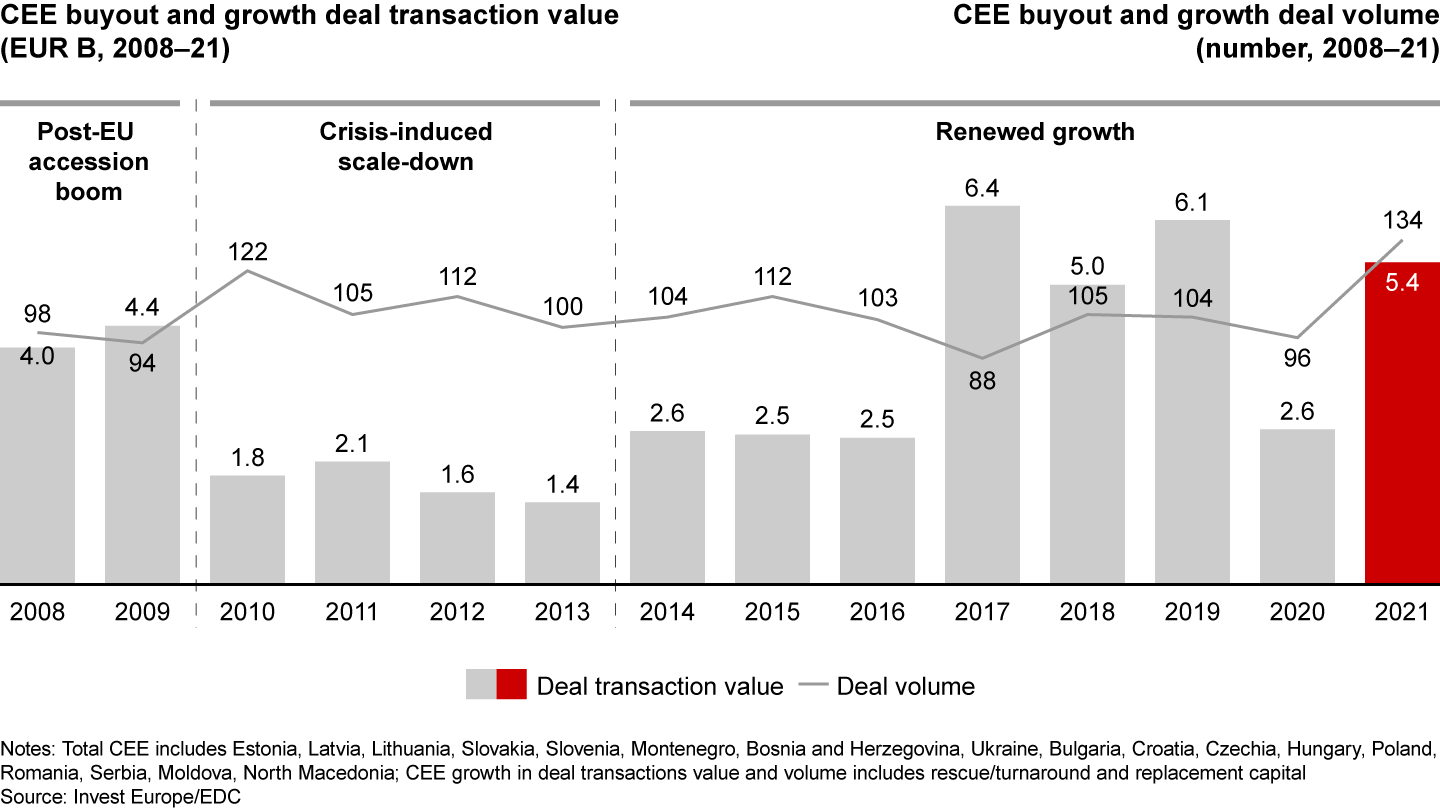
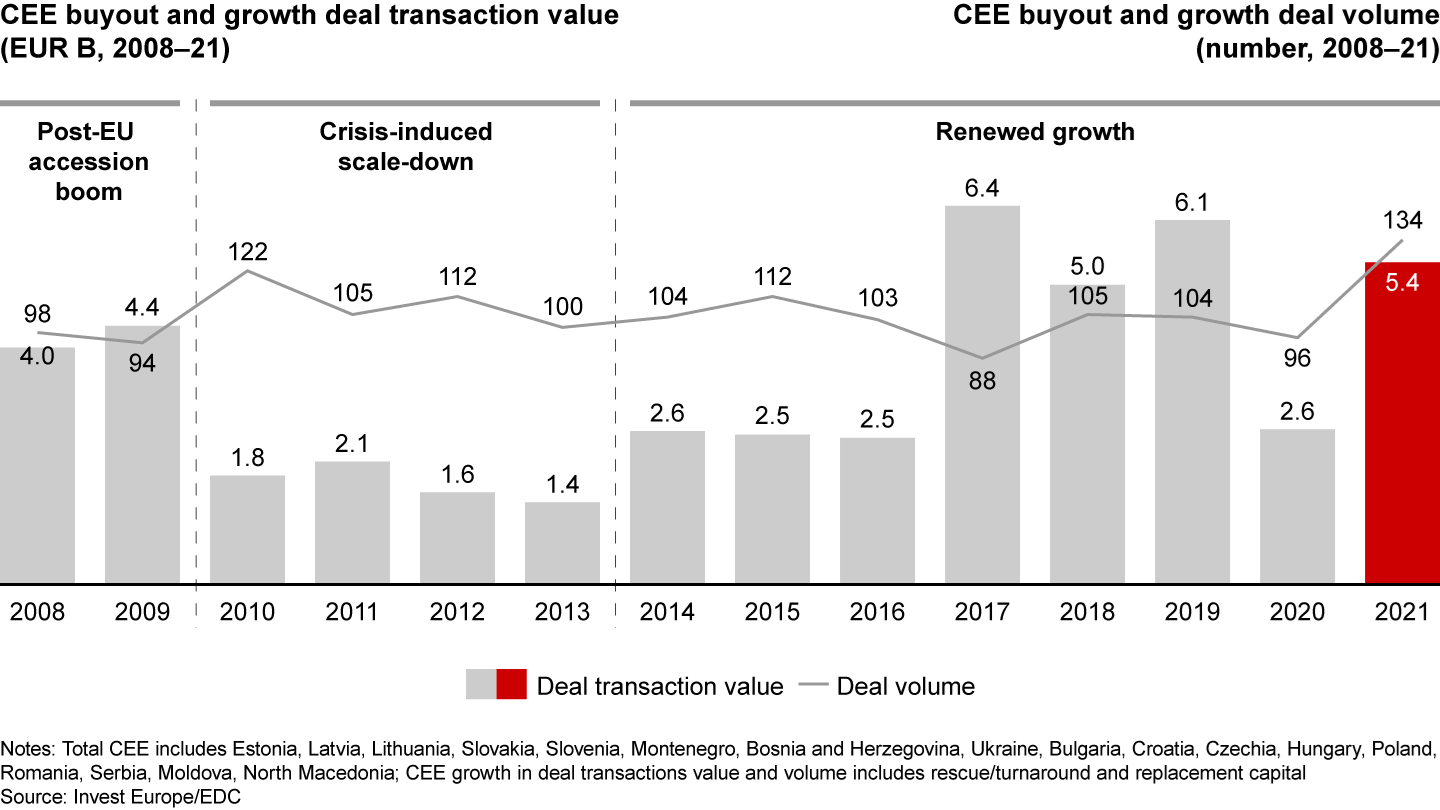
Still, despite that decade of growth, PE in Central and Eastern Europe hasn’t kept up with the global boom (see Figure 23). Investments as a percentage of GDP trail behind international benchmarks, implying substantial room for growth. Investors are increasingly optimistic about the region’s prospects (see Figure 24).
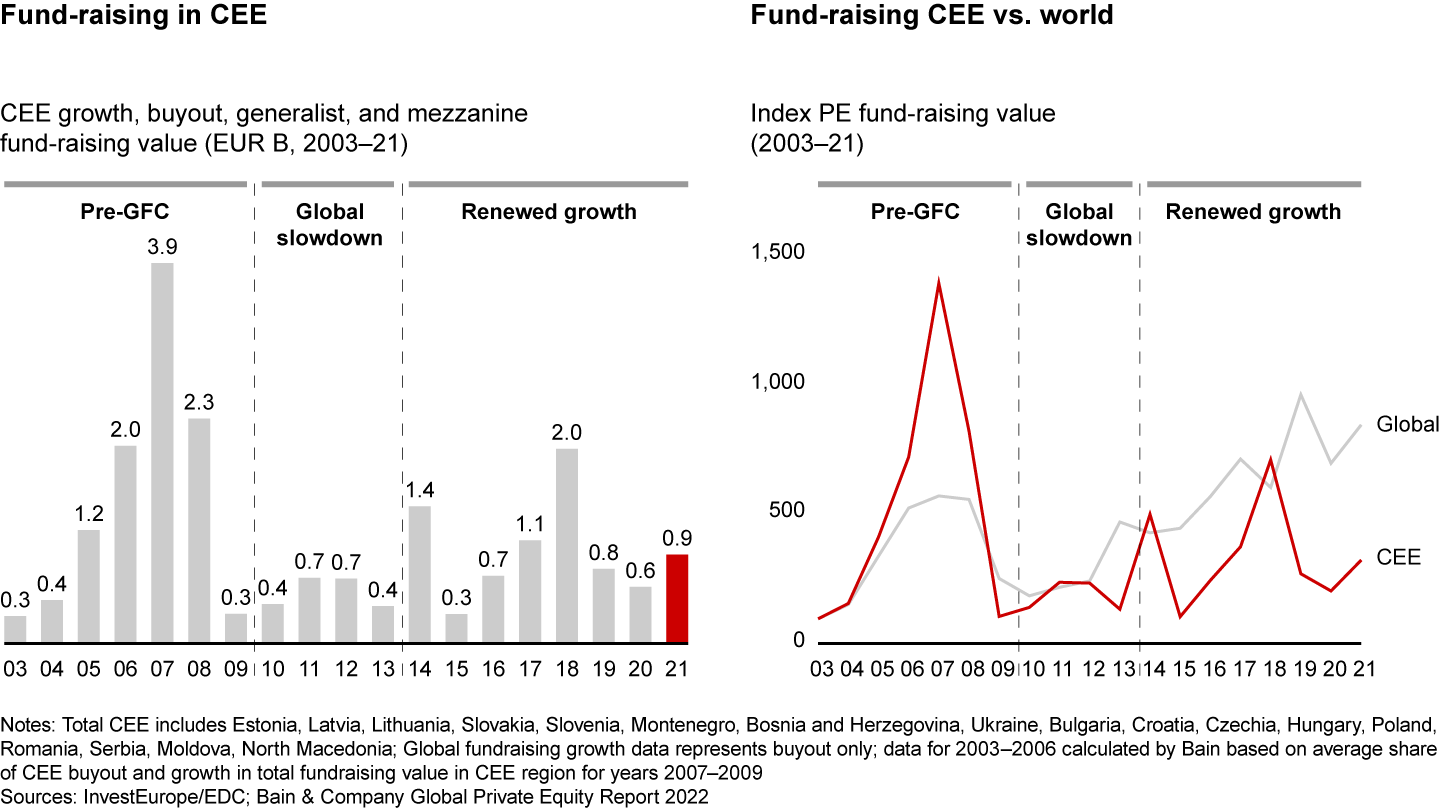
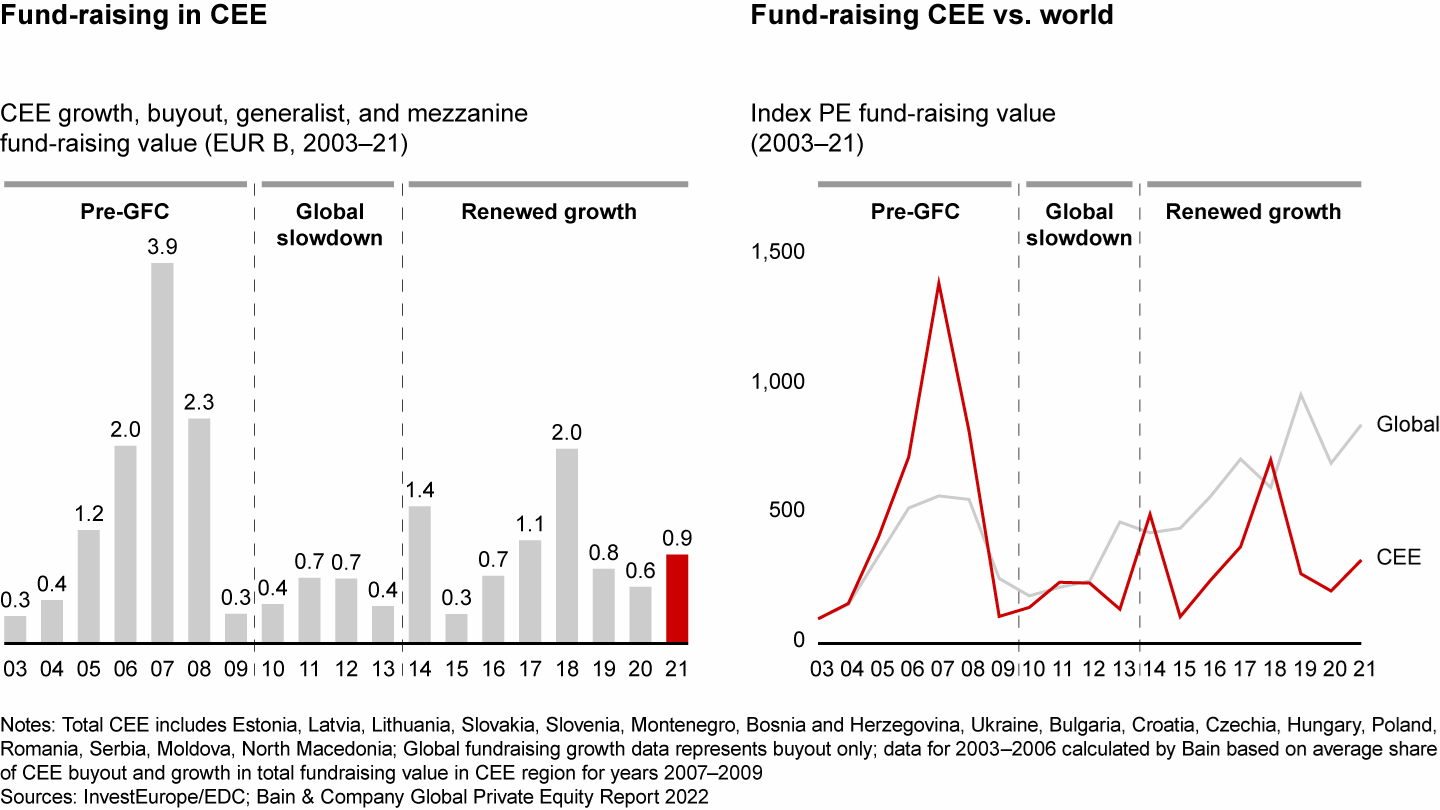
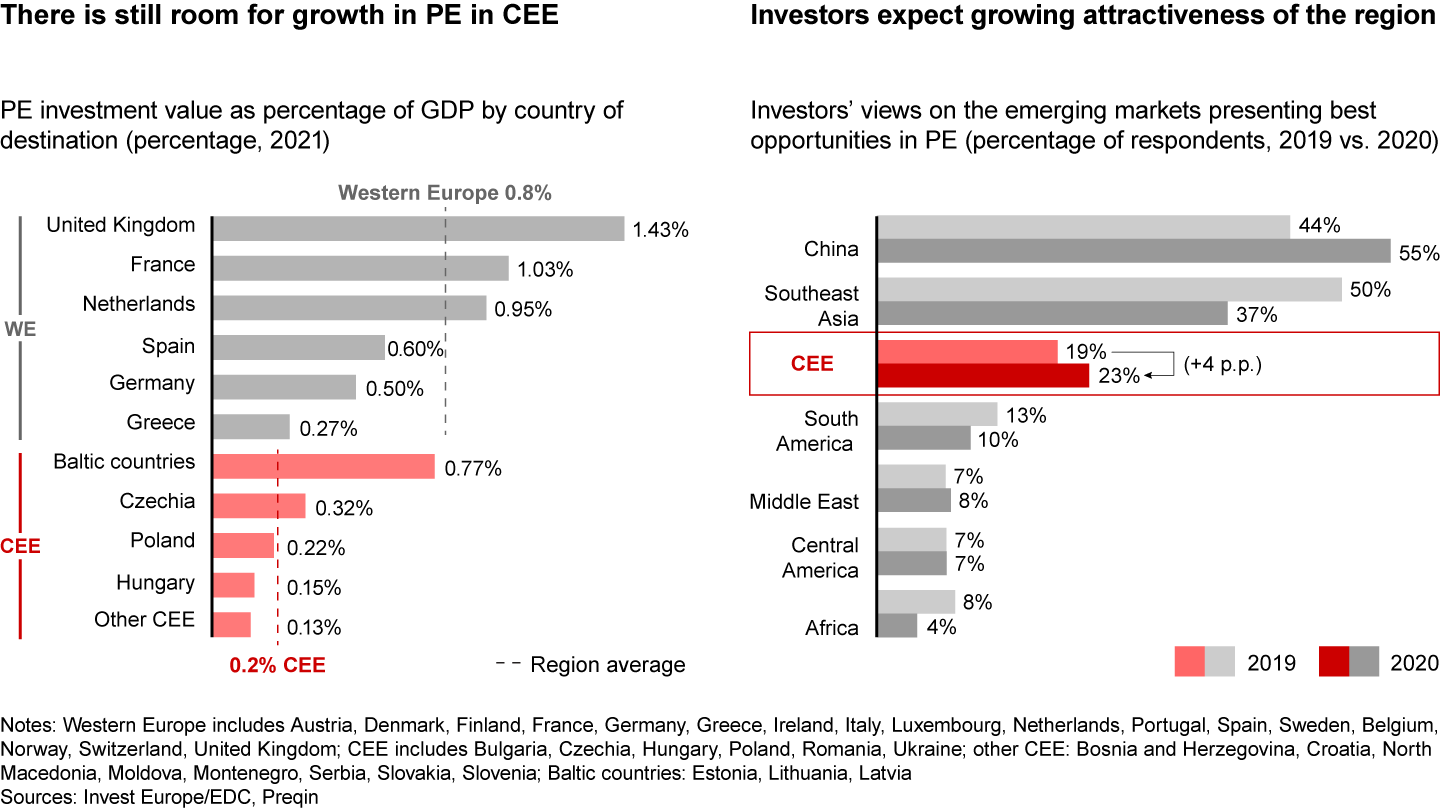
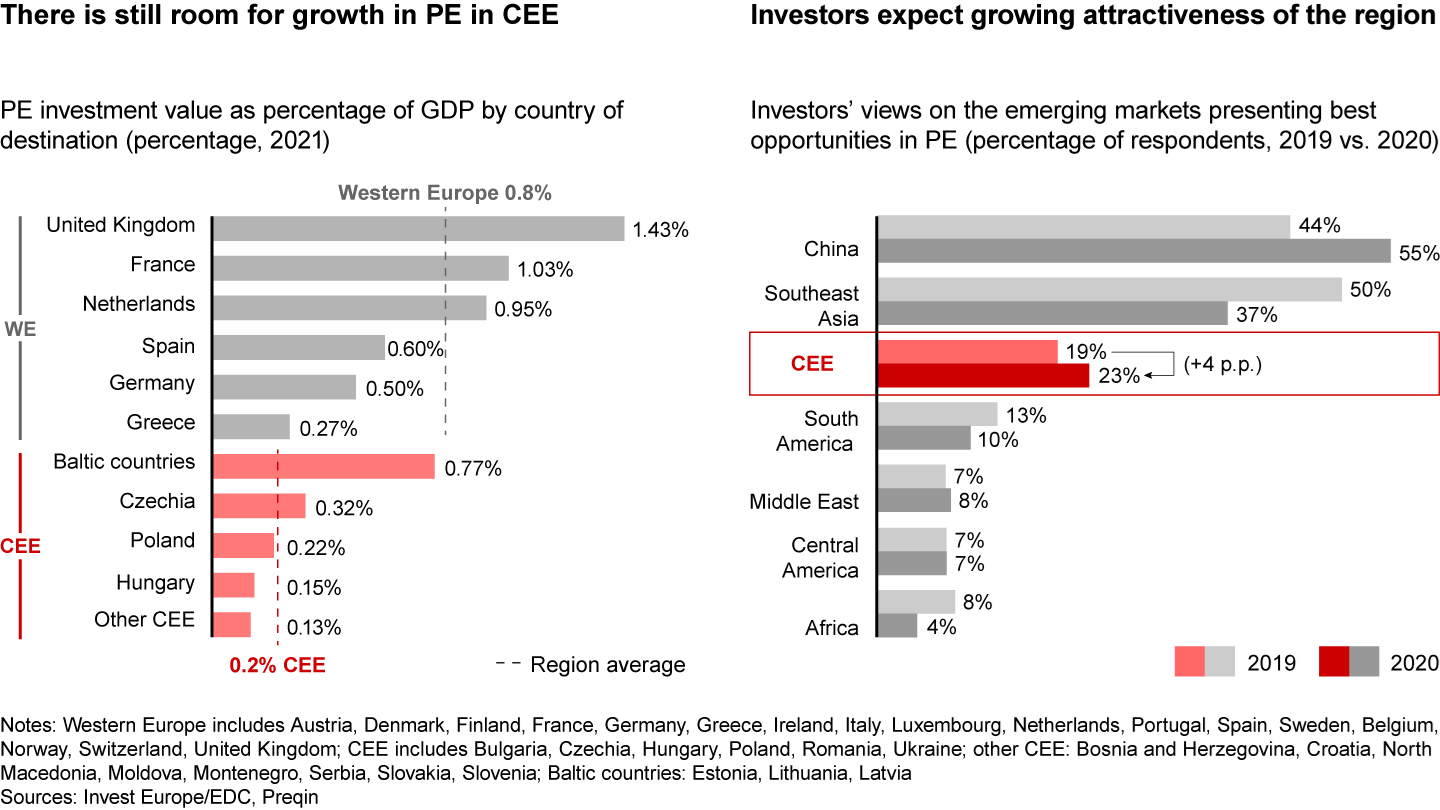
Another argument for the growth potential of private equity in CEE is seen when we compare it with other regions. Again, CEE countries’ membership in the European Union provides guarantees of economic, political, and legal stability that other emerging markets lack. And yet when we compare PE activity in the region to PE activity in Southeast Asia, we find that countries with significantly worse risk profiles, as measured by the World Bank’s Ease of Doing Business Index and the Corruption Perceptions ranking from Transparency International, are outpacing CEE states (see Figure 25). We expect this gap to narrow as investors come to realise the attractiveness of markets that are firmly anchored in the European Union and what that means for regulation and corruption over the long term.
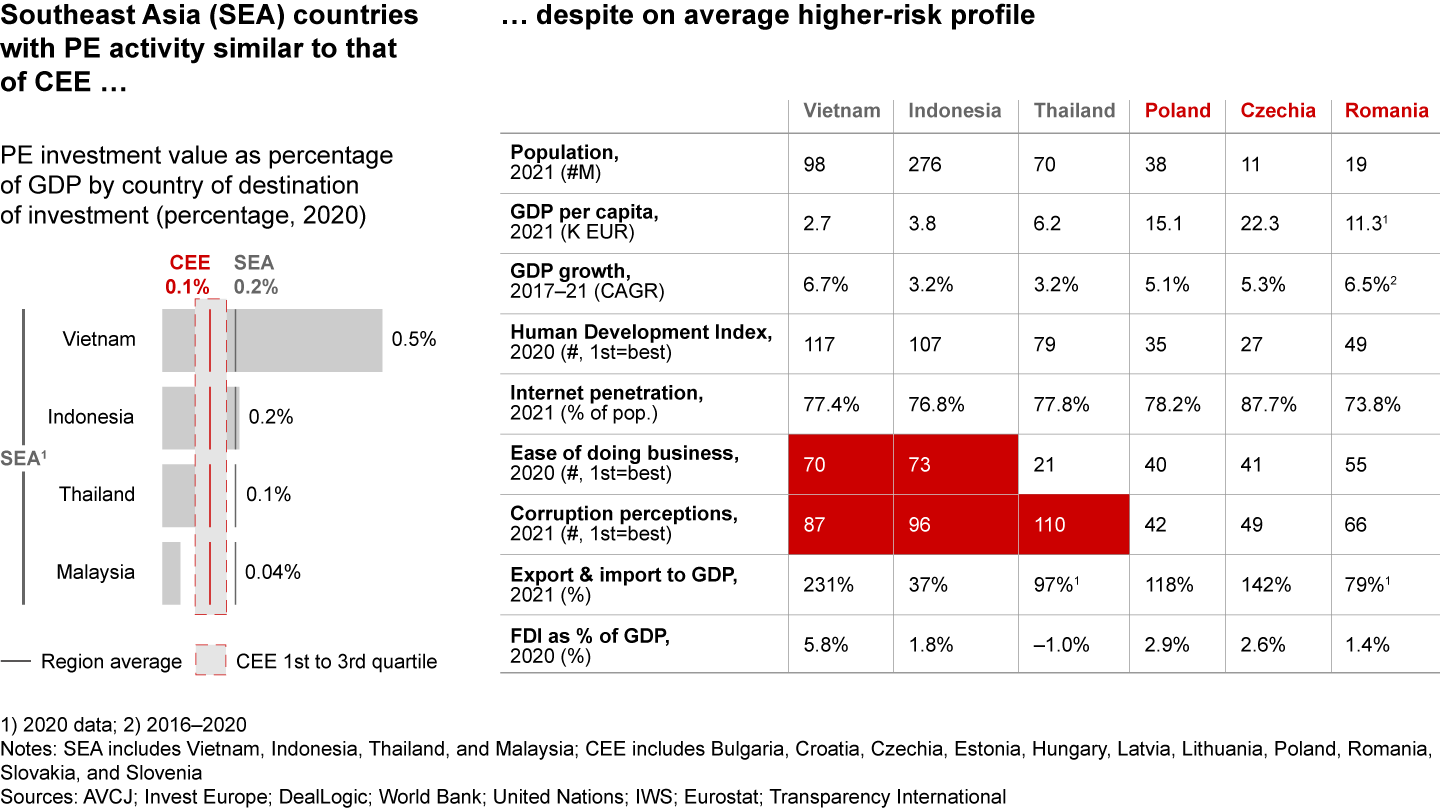
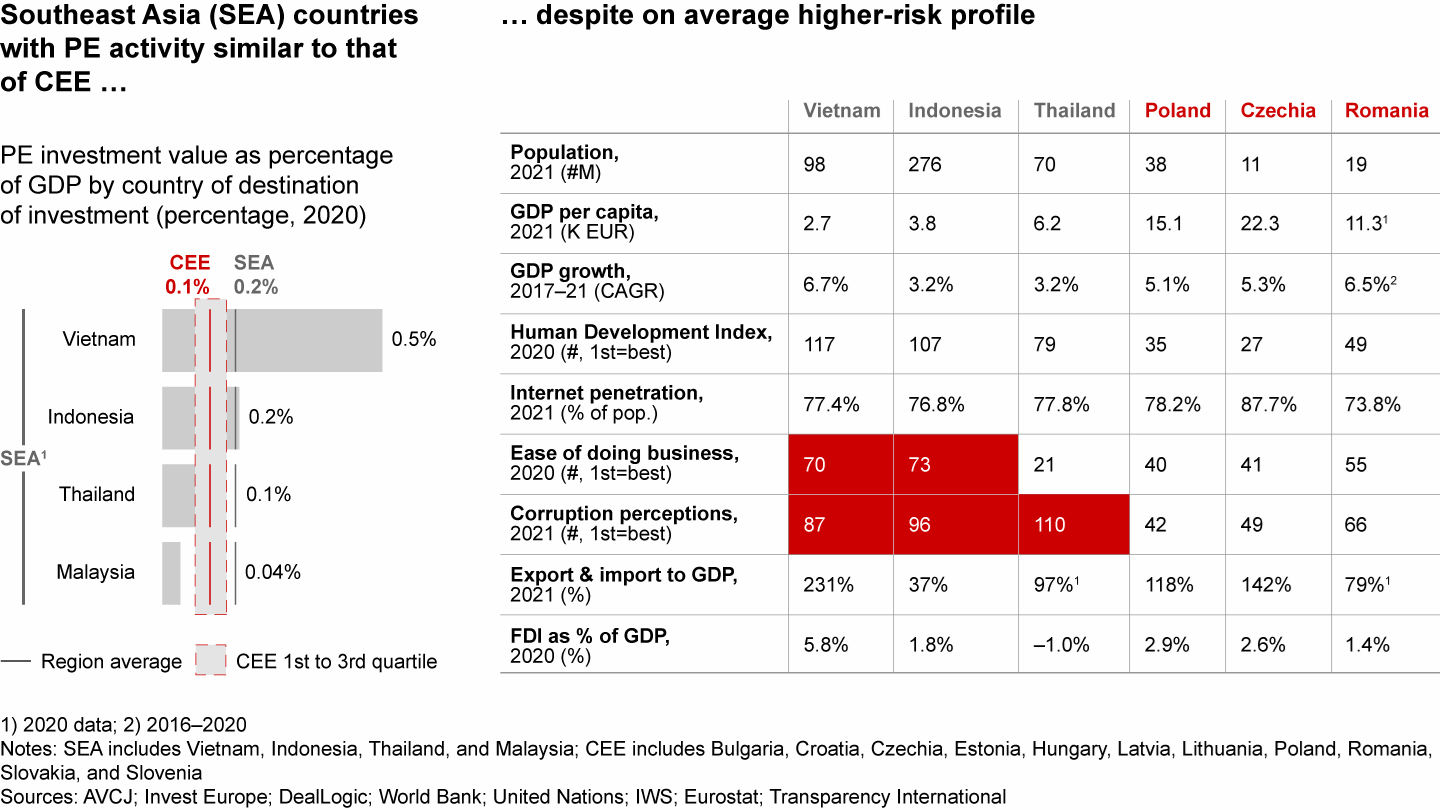
GPs in the region expect the fund-raising outlook to improve, as a result of better current and future returns on investments. While all respondents say the fund-raising outlook for CEE-based funds is either “slightly worse” or “significantly worse,” which cannot surprise given recent geopolitical and macroeconomic disruptions, as many as 56% expect an improvement over the next three to five years. Compared with three to five years ago, 66% say returns of their funds are “slightly” or “significantly” better. For the next three to five years, 67% expect similar returns, with 33% forecasting an improvement.
Meanwhile, the region’s PE ecosystem has matured over the past two decades, allowing investors to capture opportunities more effectively (see Figure 26). GPs in the region have increased their level of specialisation and their focus on value creation and have standardised investment processes.

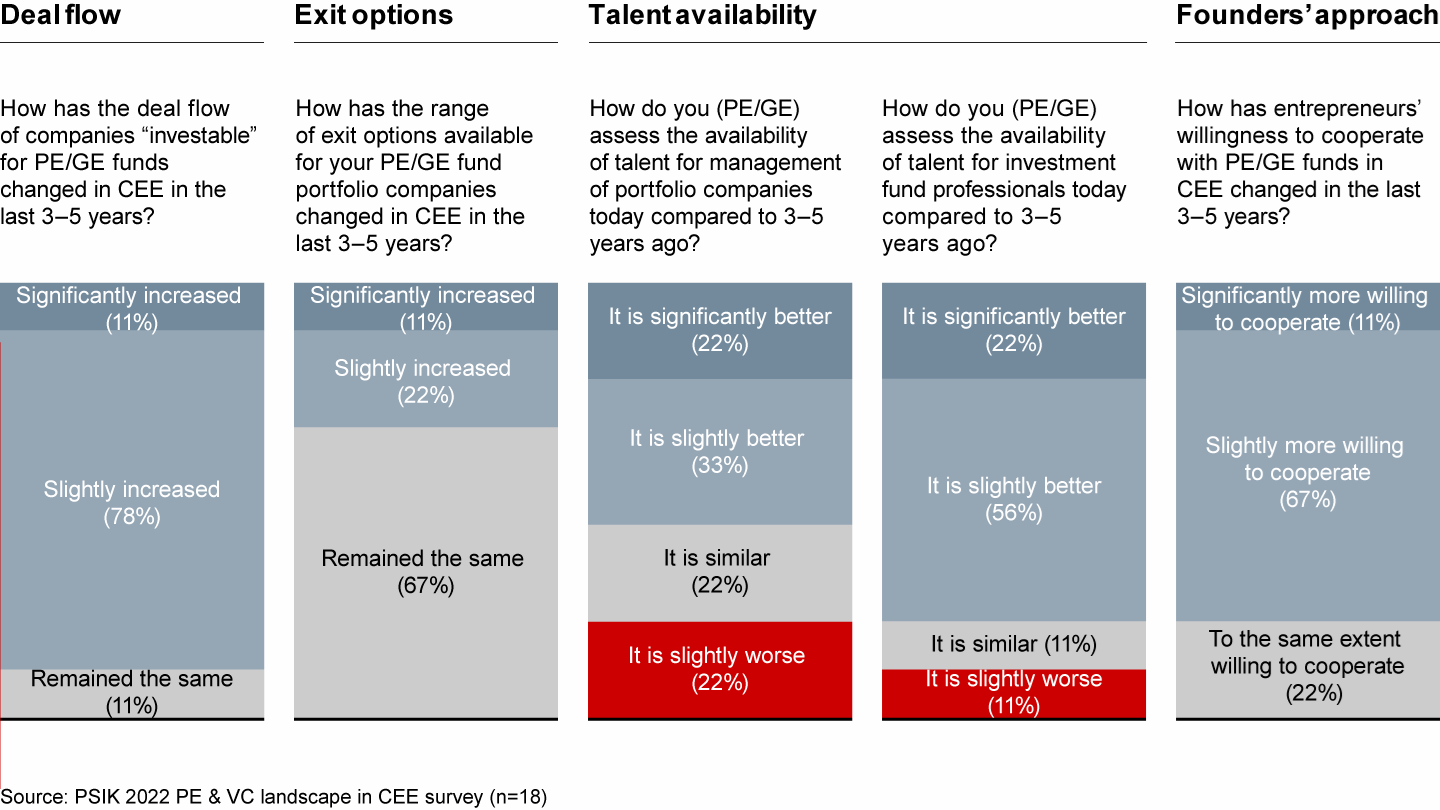
The quality of the deal flow has also been increasing, as a new generation of founders comes to the fore. Today’s founders are more professional and open to working with PE, in contrast to the bold entrepreneurs who kick-started the region’s free market boom in the 1990s (and, to be sure, were heroes for their role in transforming the economy). In our survey, 78% of respondents said entrepreneurs are now more willing to work with PE funds. Talent for investment fund professionals is also more available than it was three to five years ago, according to the same proportion of respondents.
ESG becoming a priority
GPs based in CEE are ambitious in setting their ESG agendas, with 89% having already set or planning to set specific commitments or targets. And investing in companies from the region can be positive for measures of gender diversity. Of the 11 countries we examine, all but one are above the EU average for the percentage of women in management; CEE countries hold the top five spots in the bloc (see Figure 27). The percentage of female senior investment professionals in PE and VC is already comparable to the level in developed markets.
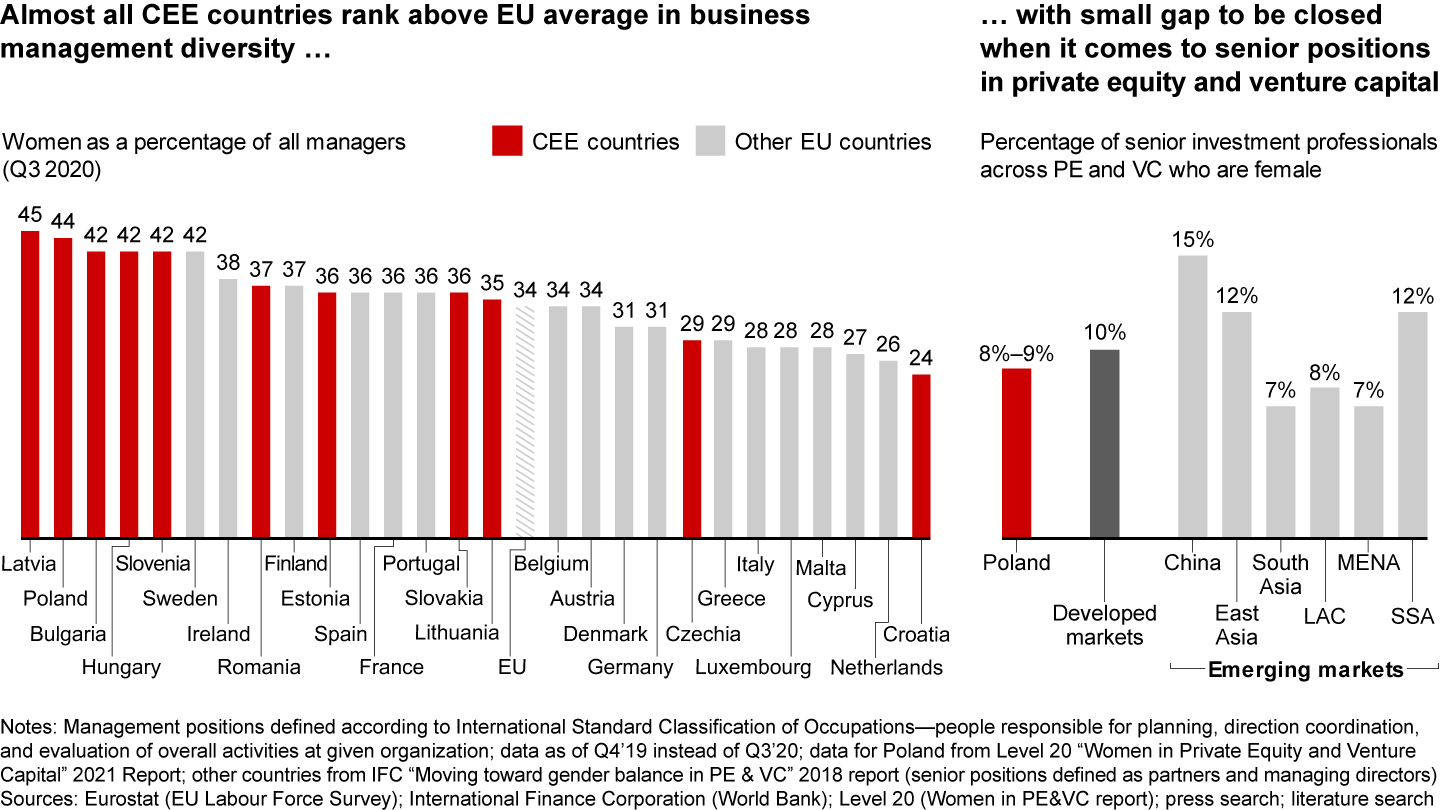
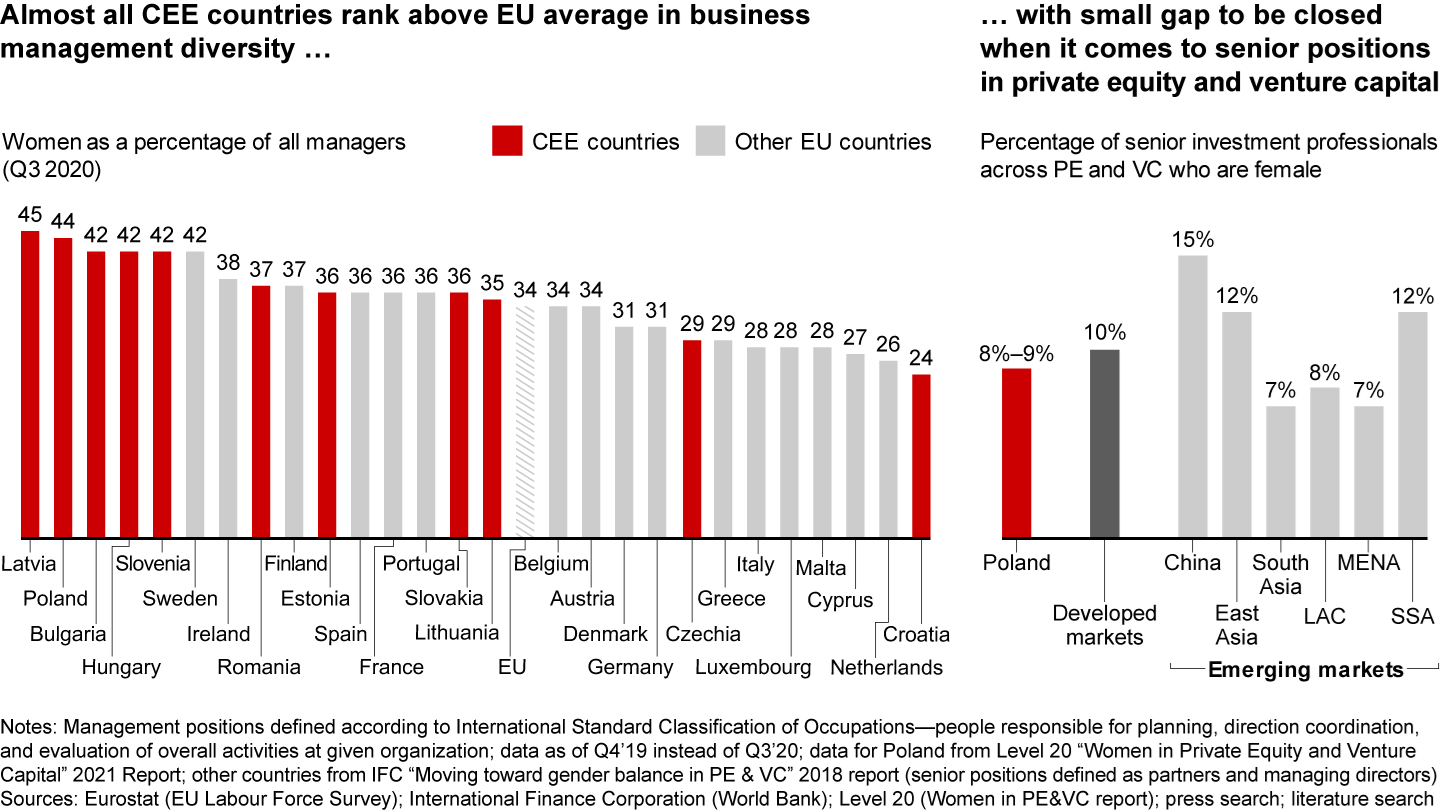
Local LPs take the stage
Although they are still more rare than in developed markets, local LPs—both public and private—are beginning to emerge, a trend that may further accelerate the scaling of the region’s PE landscape (see Figure 28). One local LP is the state-owned Polish Development Fund (PFR), which has allocated PLN 1.1 billion to buyout, mezzanine, and private debt funds (see Figure 29). The fund not only invests in PE and VC projects but also is actively working toward necessary regulatory changes allowing pension funds in Poland to invest in PE and VC.
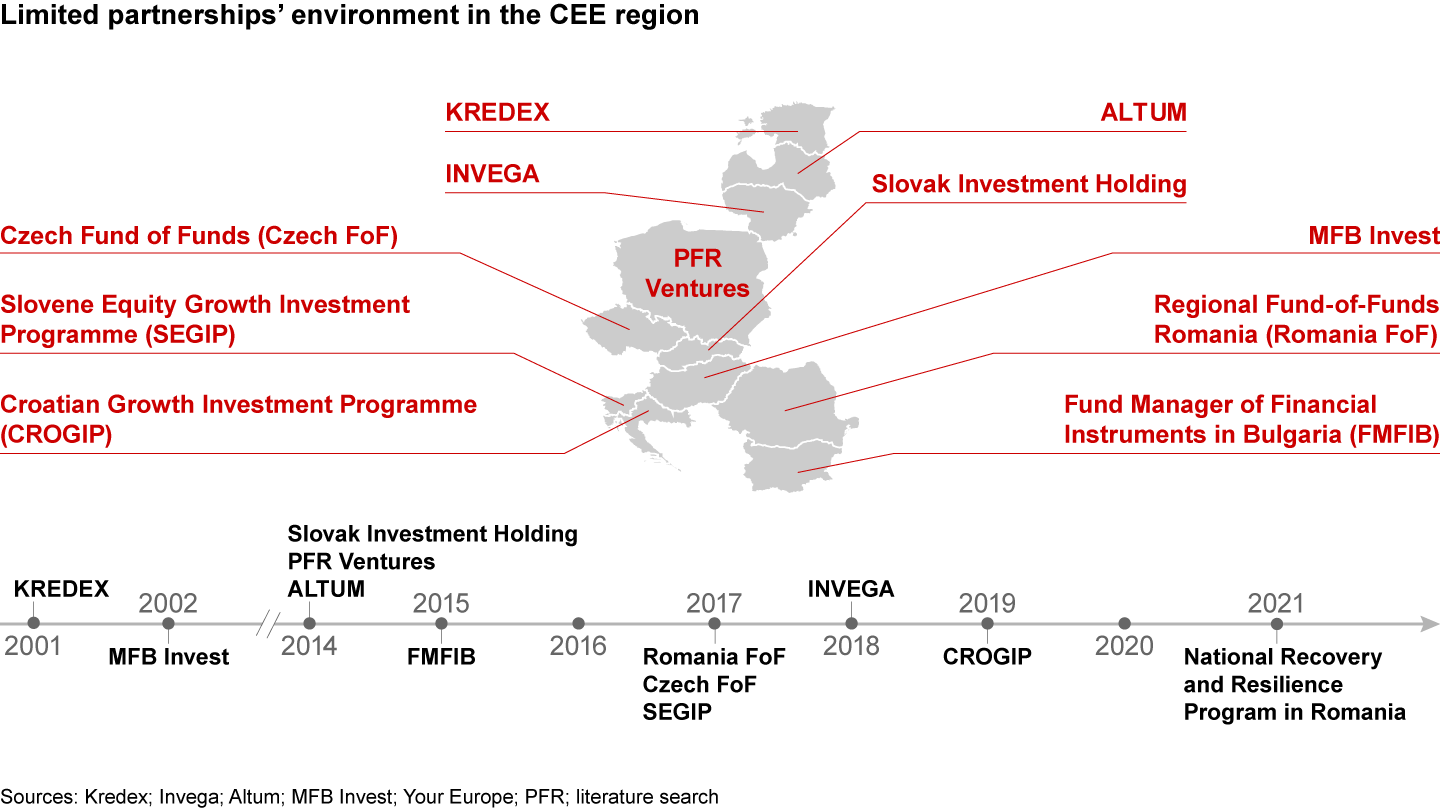
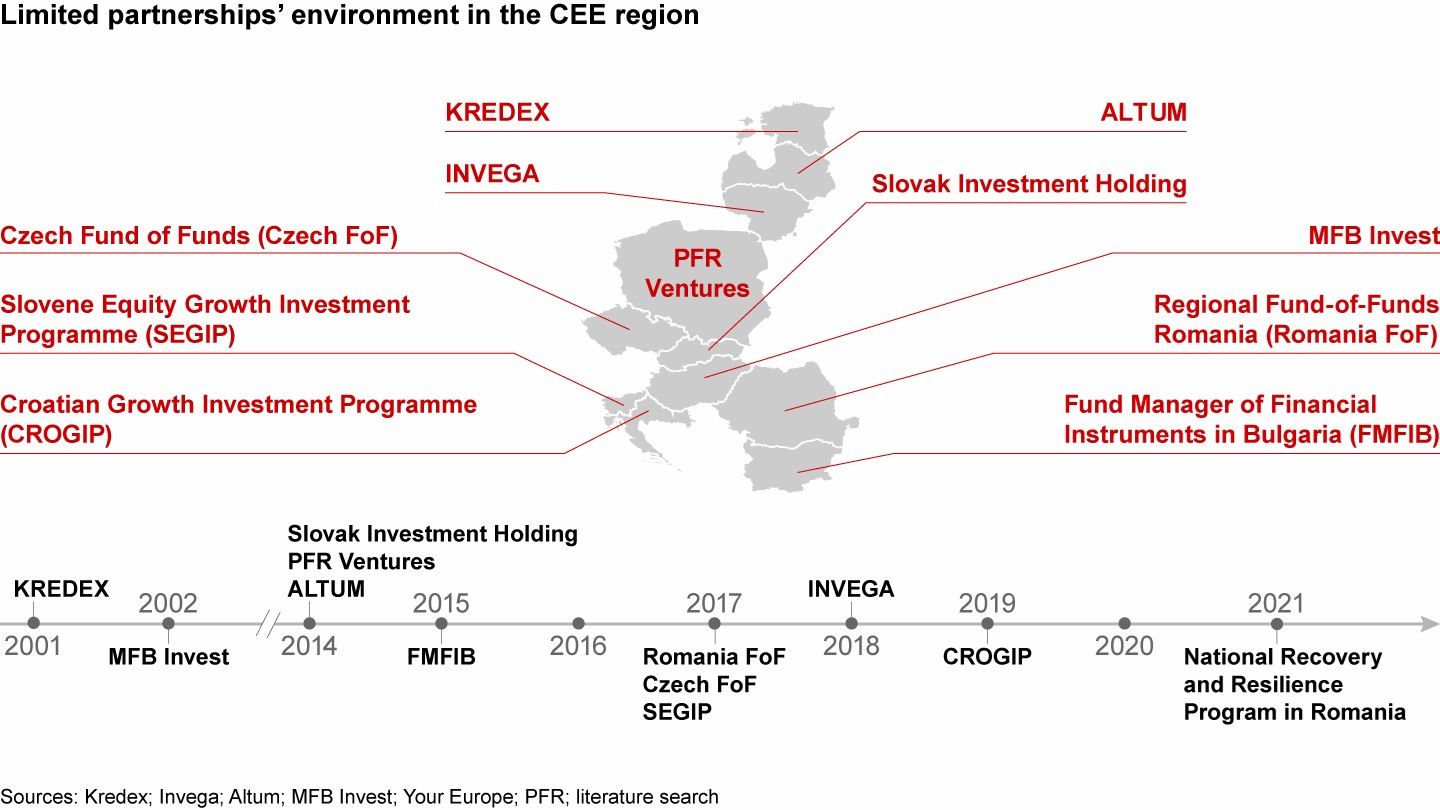
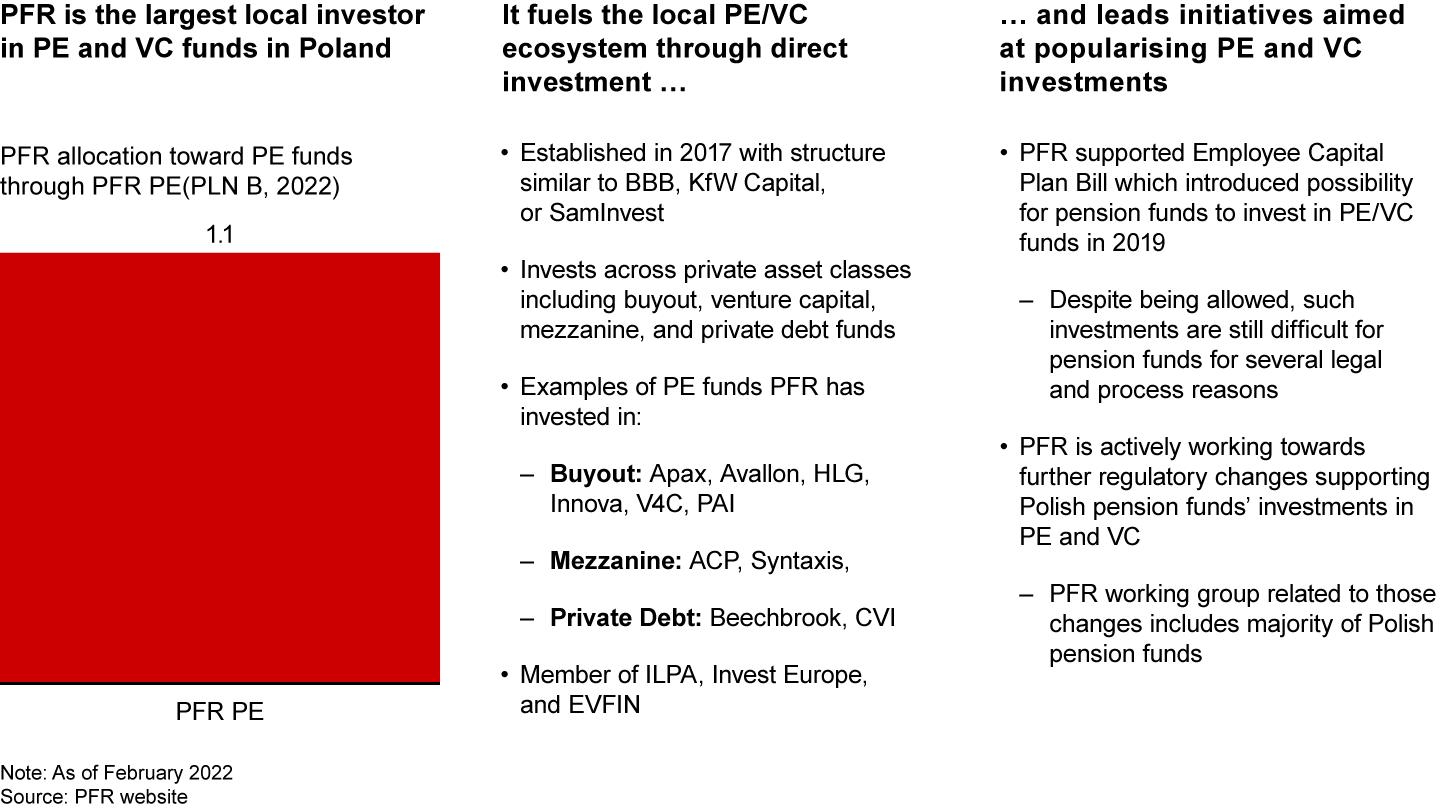
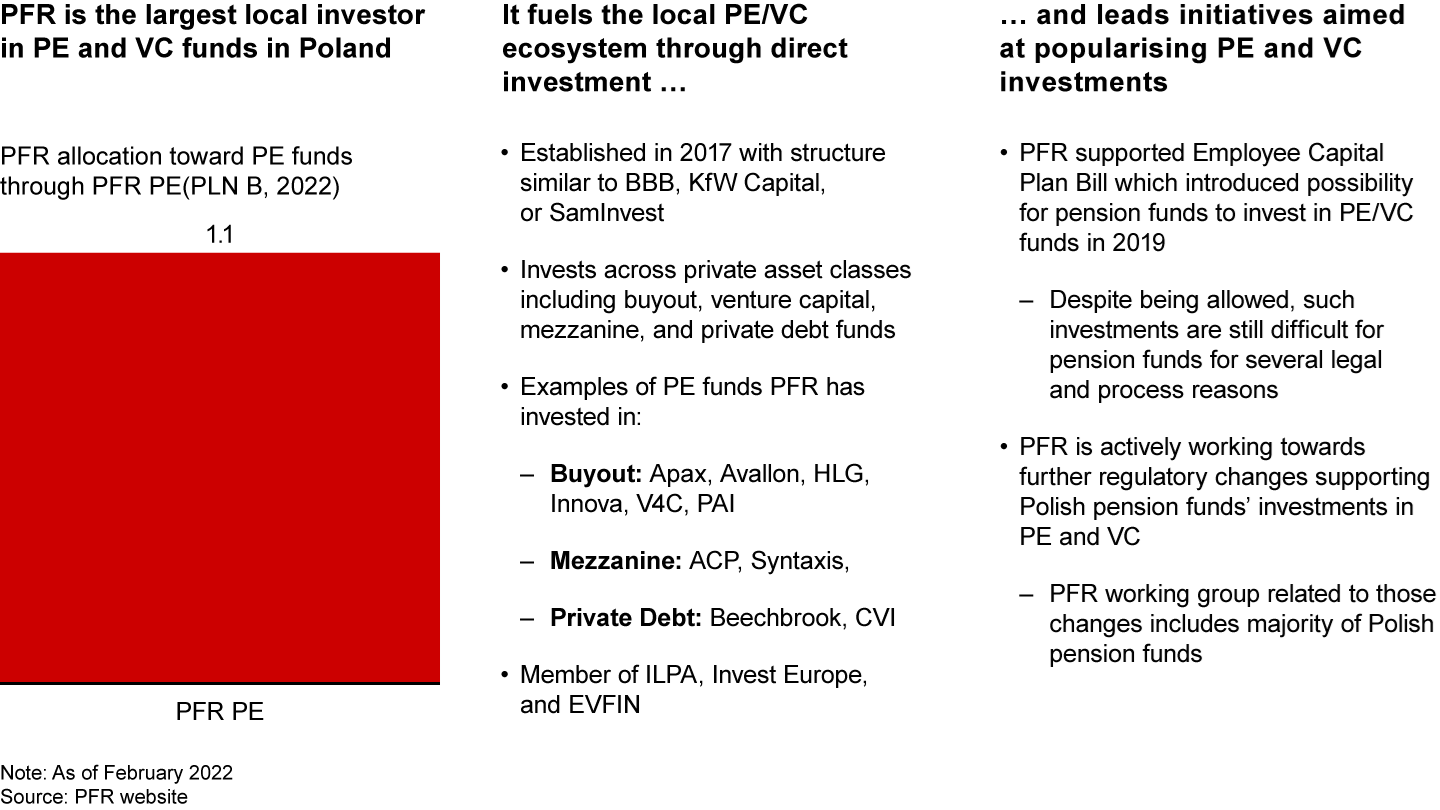
Local GPs in Central and Eastern Europe tend to target small- and mid-cap deals, with their international peers conducting the largest transactions (see Figure 30). This division of the market is likely to remain stable in the medium term, reflecting the trends in more developed markets (see Figure 31). Advantages in deal sourcing will continue to favor local GPs in small- and mid-cap transactions: 67% of respondents say they typically don’t have any competitors in final bidding, and 77% say a majority of their transactions are proprietary.
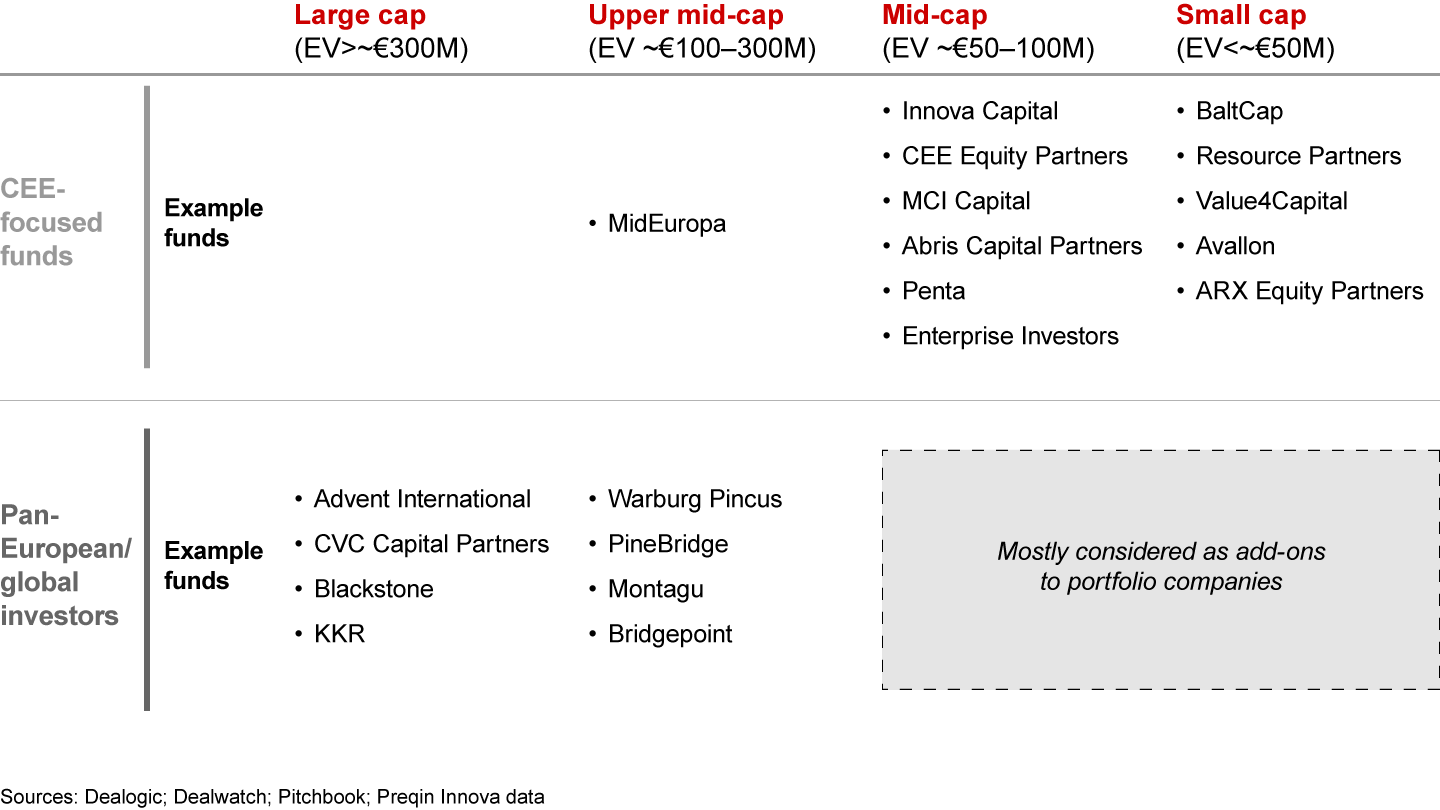
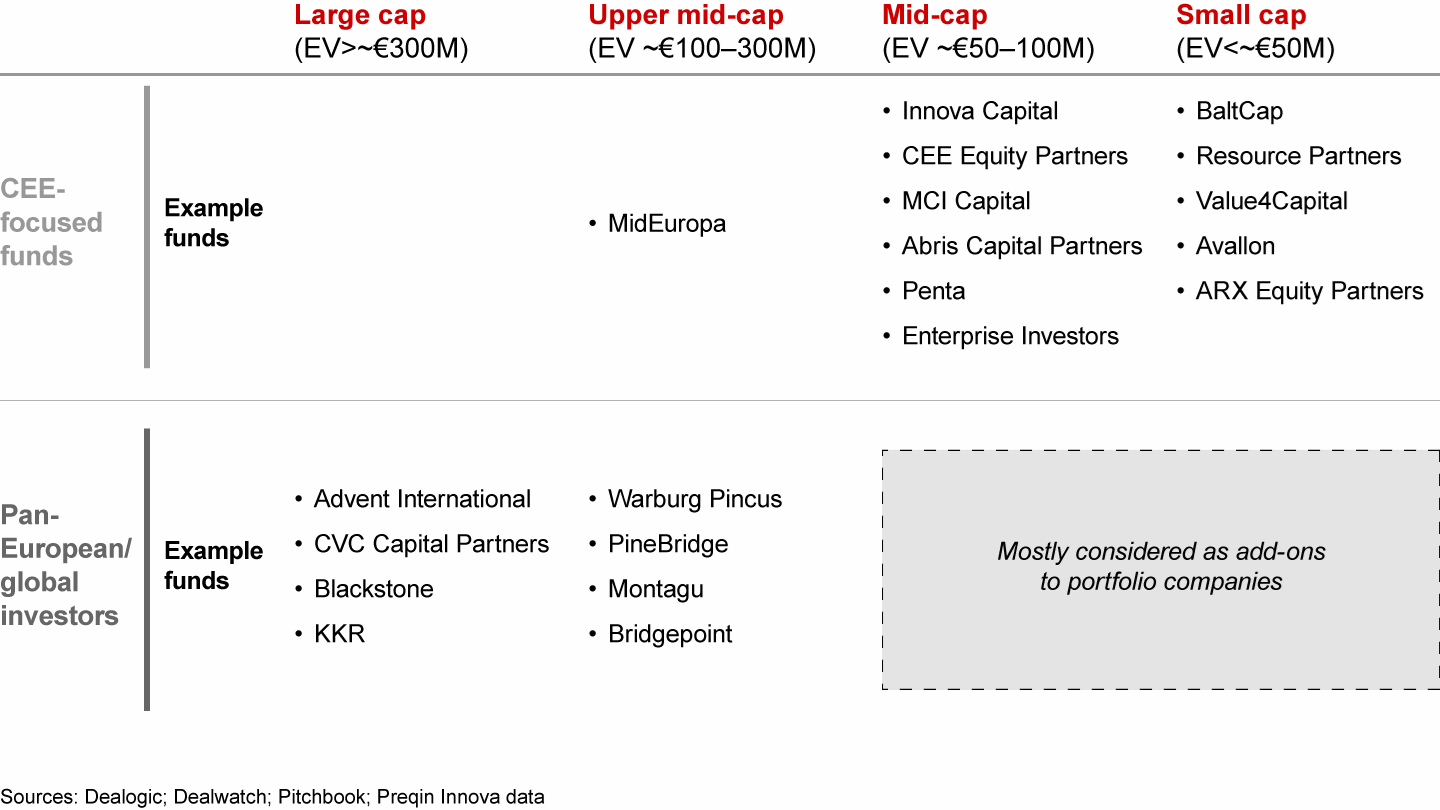
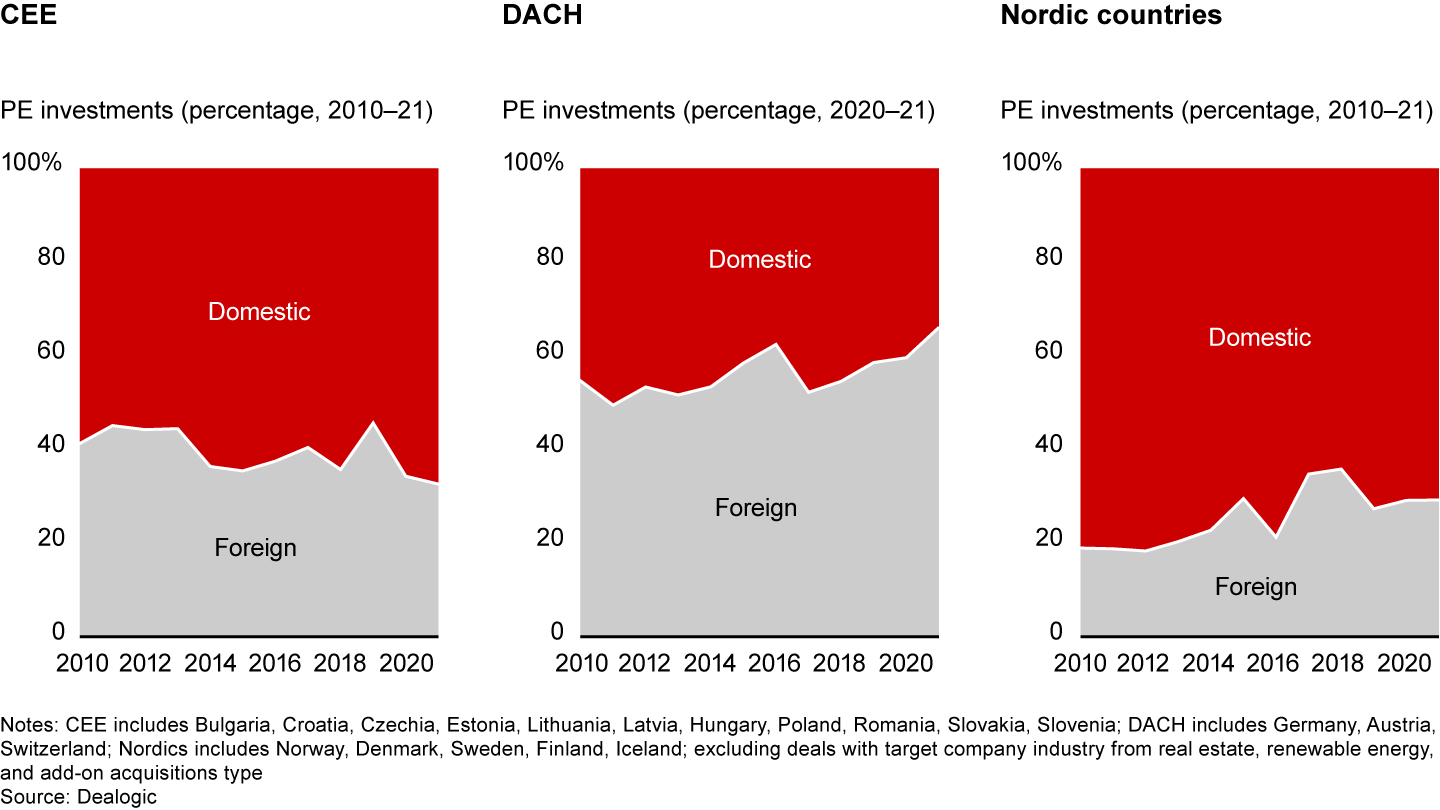
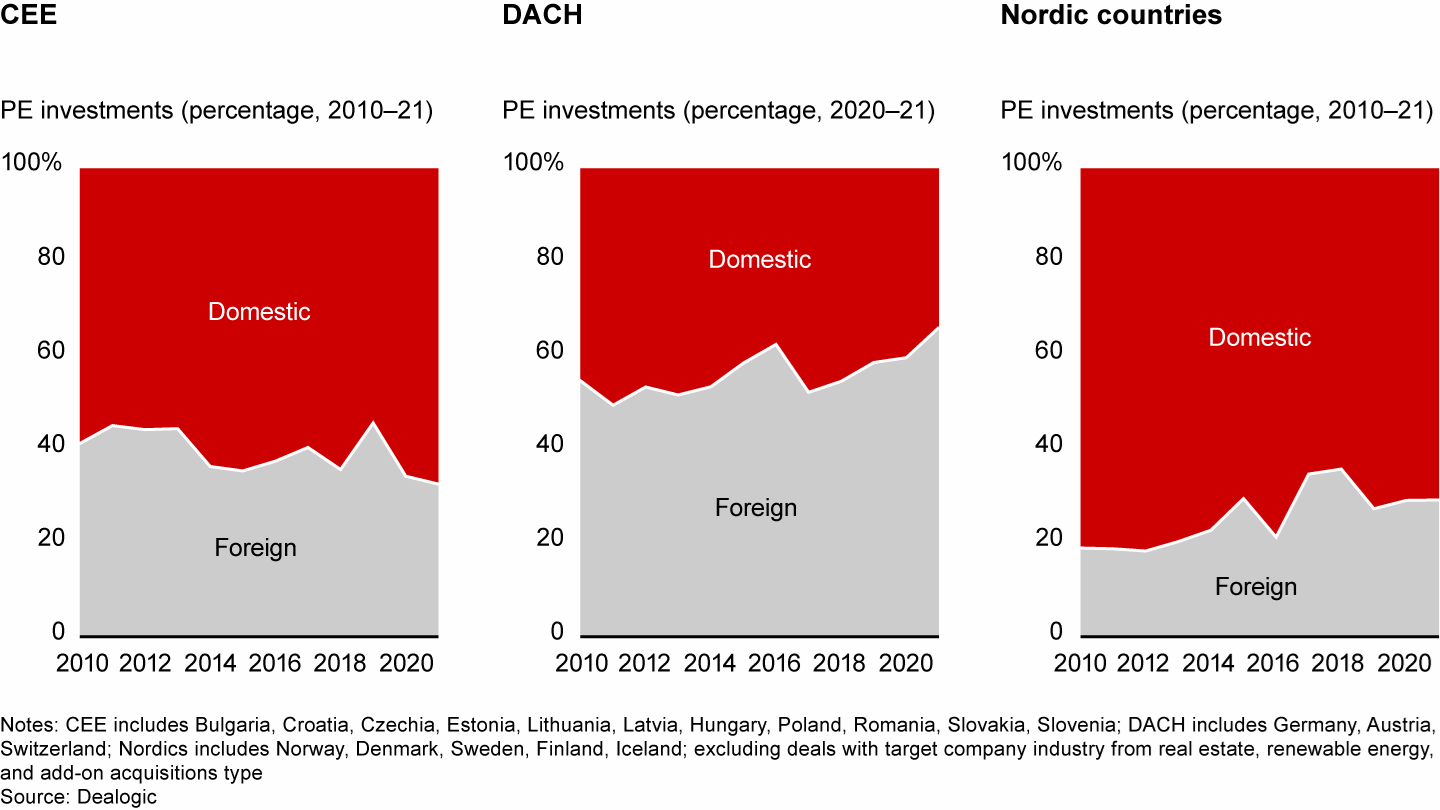
Venture capital: The boom continues
Tomasz Swieboda
Vice President, Polish Private Equity and Venture Capital Association
Partner, Inovo Venture Partners
Venture capital in Central and Eastern Europe is growing at the fastest pace of any region on the continent, as investors are coming to recognise the unique advantages offered by countries covered in this report. Those include deep local pools of tech talent, fed by robust educational systems in the hard sciences. Most encouragingly for the industry, we’re starting to see the first signs of a flywheel effect, where alumni of successful companies invest in the next generation of start-ups.
Every indication is that the growth will continue, which makes it an exhilarating time to be involved in the industry. I’m grateful to my colleagues at PSIK and Bain for putting together this valuable snapshot of CEE venture capital at a crucial moment, and I hope this chapter will persuade you to take a closer look at the strong prospects for the industry.
Paweł Kozub
Associate Partner, Bain & Company
The past few years have been an exciting time to be involved in Central and Eastern Europe’s venture capital industry, and all signs indicate that the boom is only just beginning. The region is starting to produce unicorns at an impressive rate, and there’s still room for the countries here to catch up with their Western European peers.
I’m sure that this comprehensive report will spur a number of conversations about the future of venture capital, and I look forward to exploring the ways that the Bain team can continue contributing to our clients’ success as they pursue the rich opportunities in this field.
Venture capital in CEE
While the private equity industry in Central and Eastern Europe is waiting to match its pre-GFC records, venture capital’s current boom in CEE is unprecedented—and it’s just getting started. VC investment in the region has skyrocketed in recent years, with the 2021 value just over nine times the level in 2015. That’s the fastest growth rate for any region in Europe (see Figure 32). The value of funds raised by local GPs grew five times in 2016 to 2017 and has continued to scale ever since with strong support from local LPs (see Figure 33). And these investments are bearing fruit: the number of current and rising unicorns is steadily increasing. CEE has arrived on the map of European venture capital, and the growth streak is set to continue.
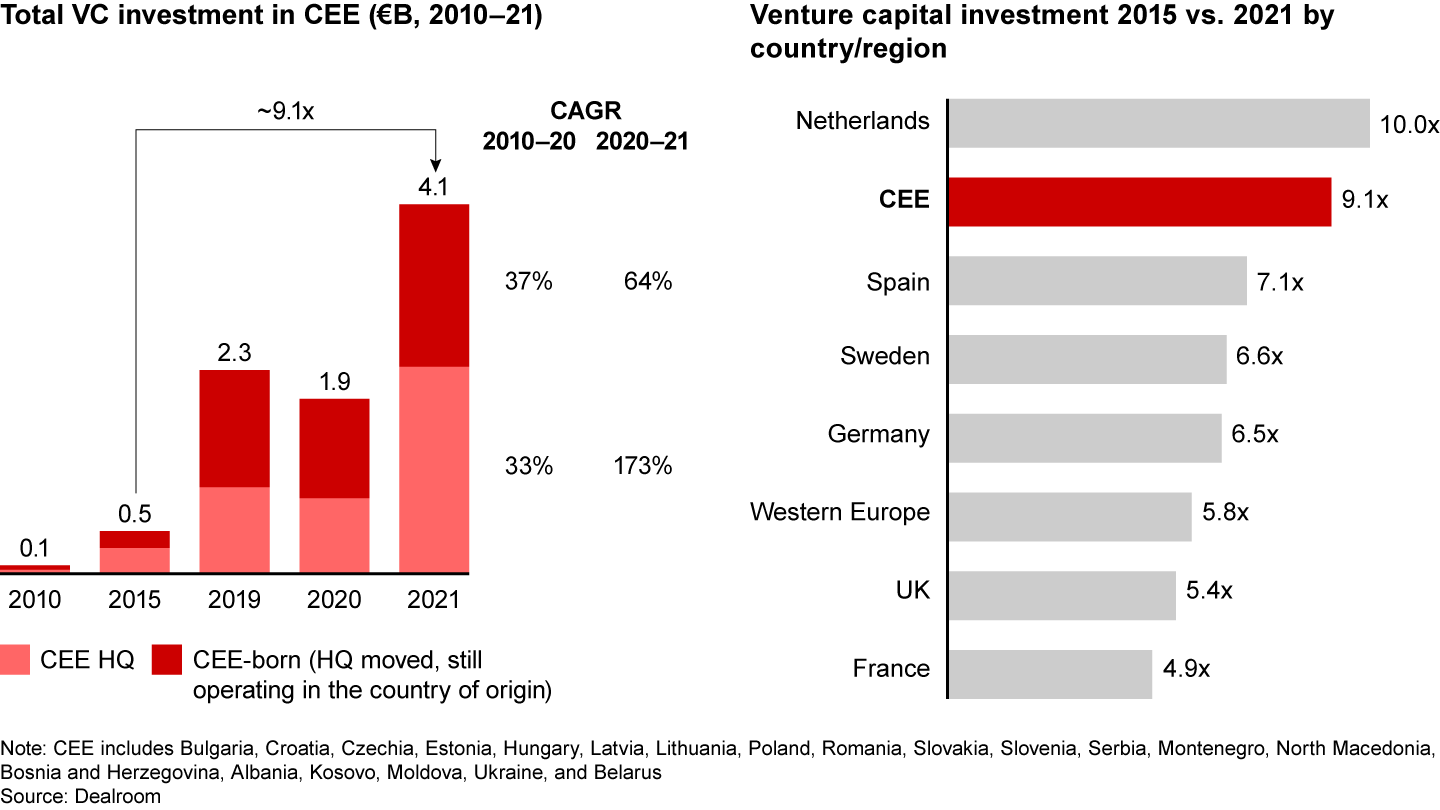
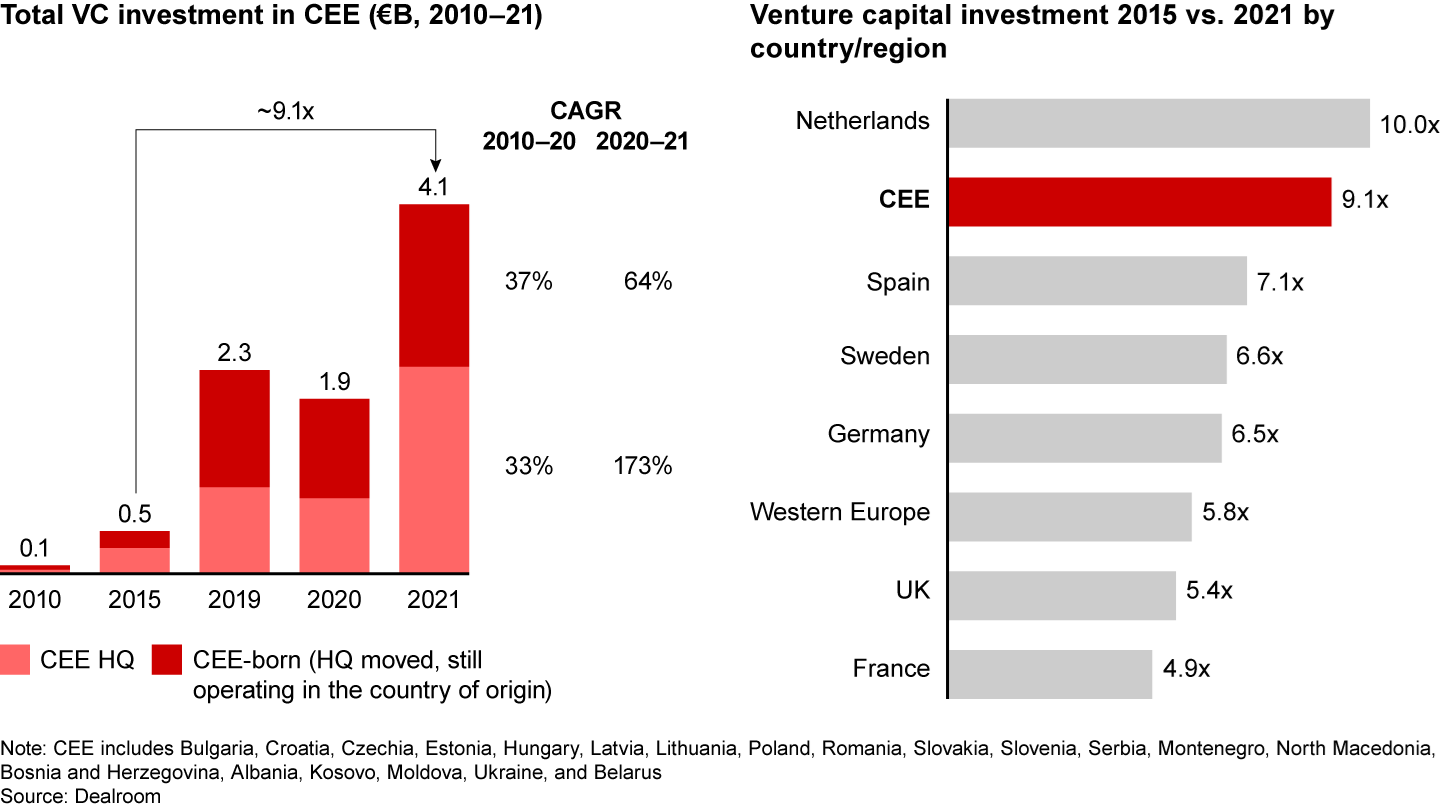

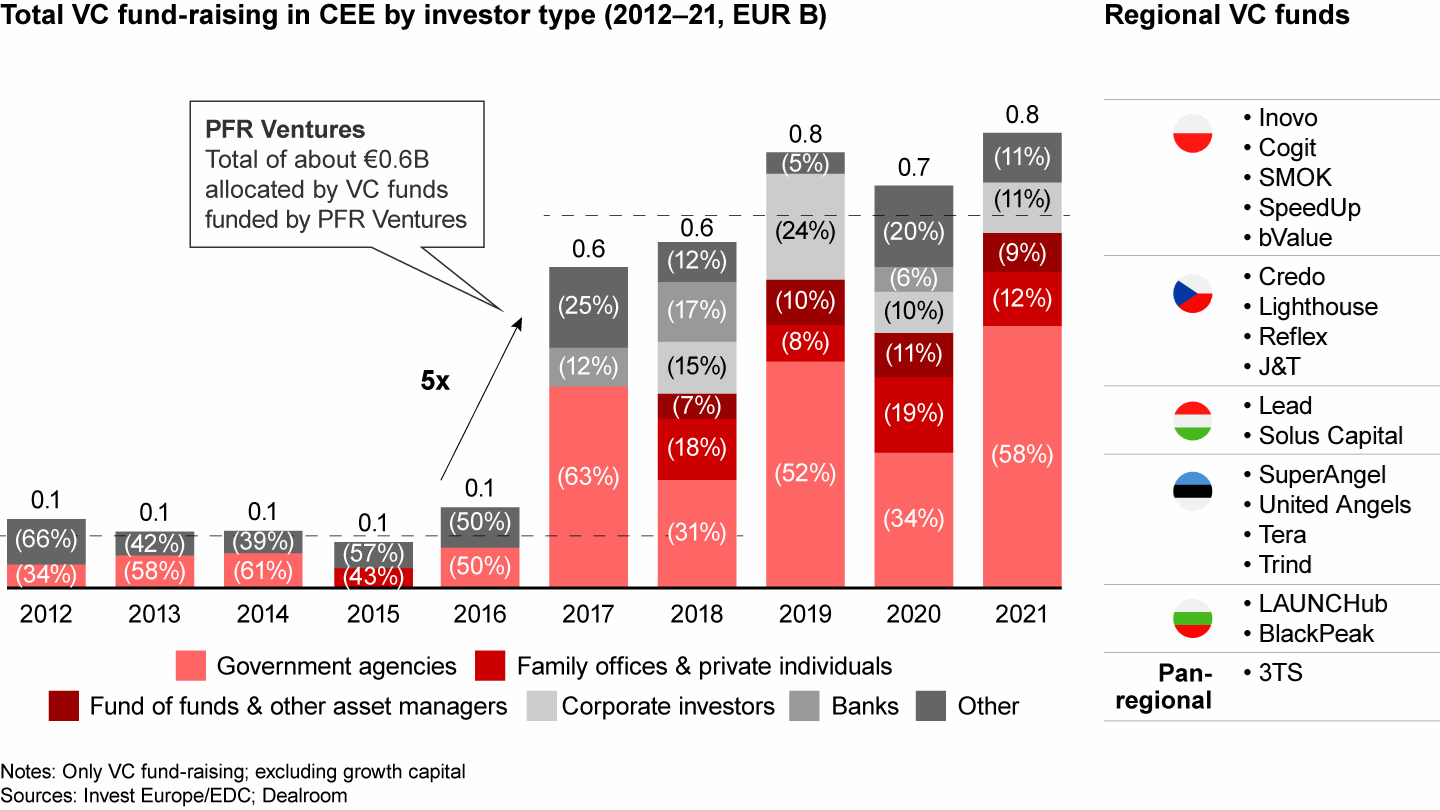
Significantly, not only is overall funding growing, but the size of investment rounds has also expanded. In 2016, there were no rounds larger than $40 million; pre-seed and seed rounds accounted for 42% of total funds raised (see Figure 34). By 2021, megarounds of $250 million or more made up 32% of the total. That’s reflected in the number of unicorns the region is now producing (see Figure 35).
Almost all CEE countries have produced several unicorns—from Skype, Bolt, and DocPlanner to UiPath, Payhawk, and GoTo.
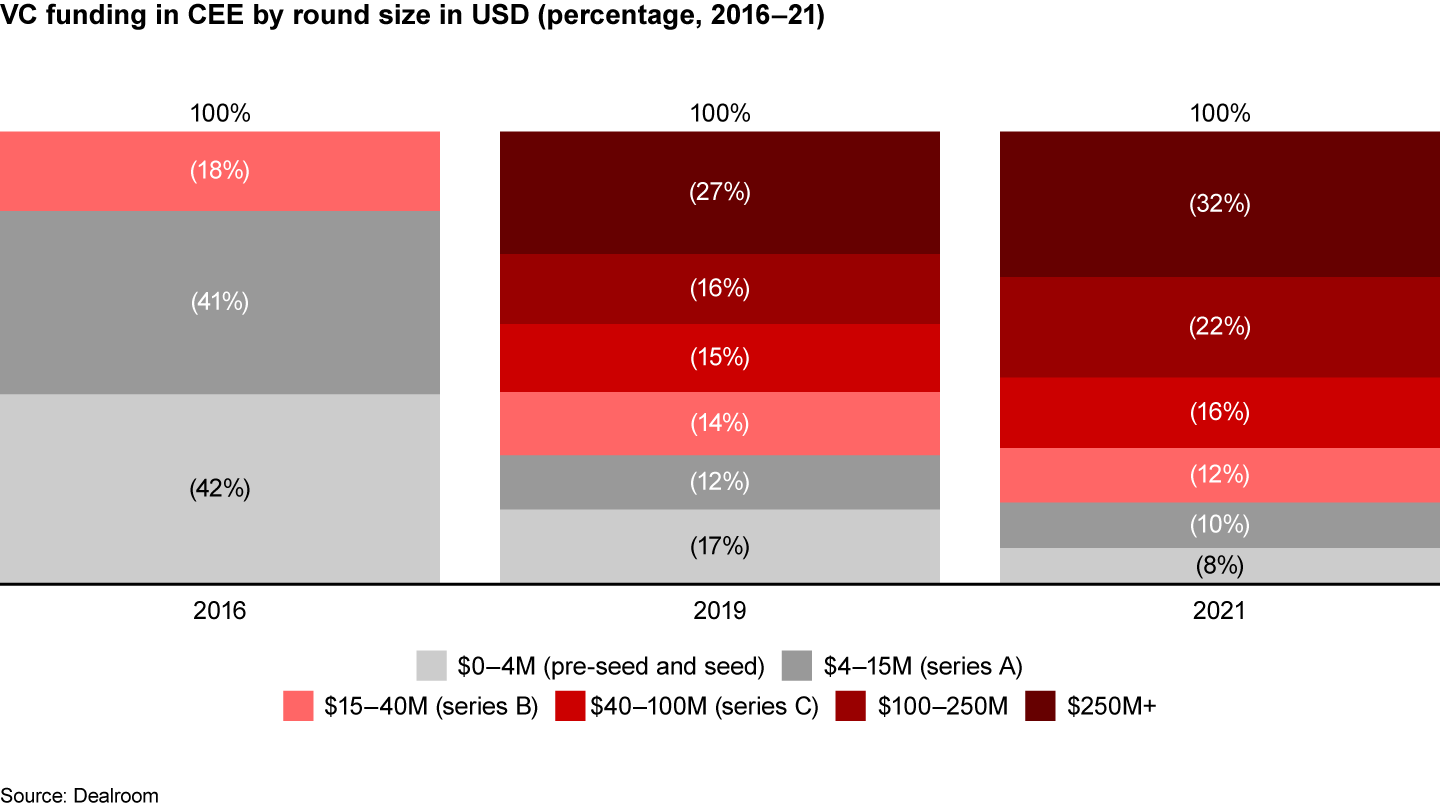
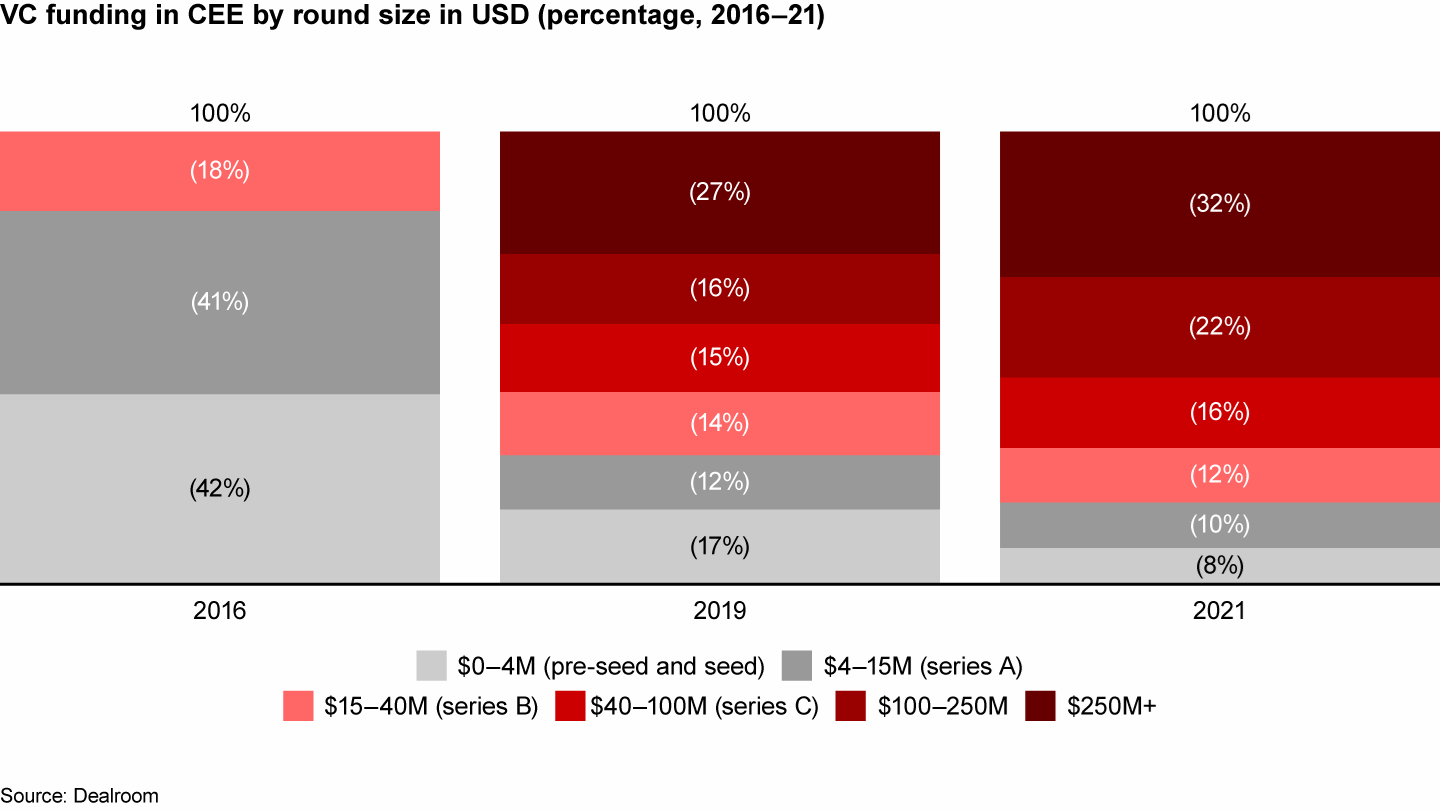
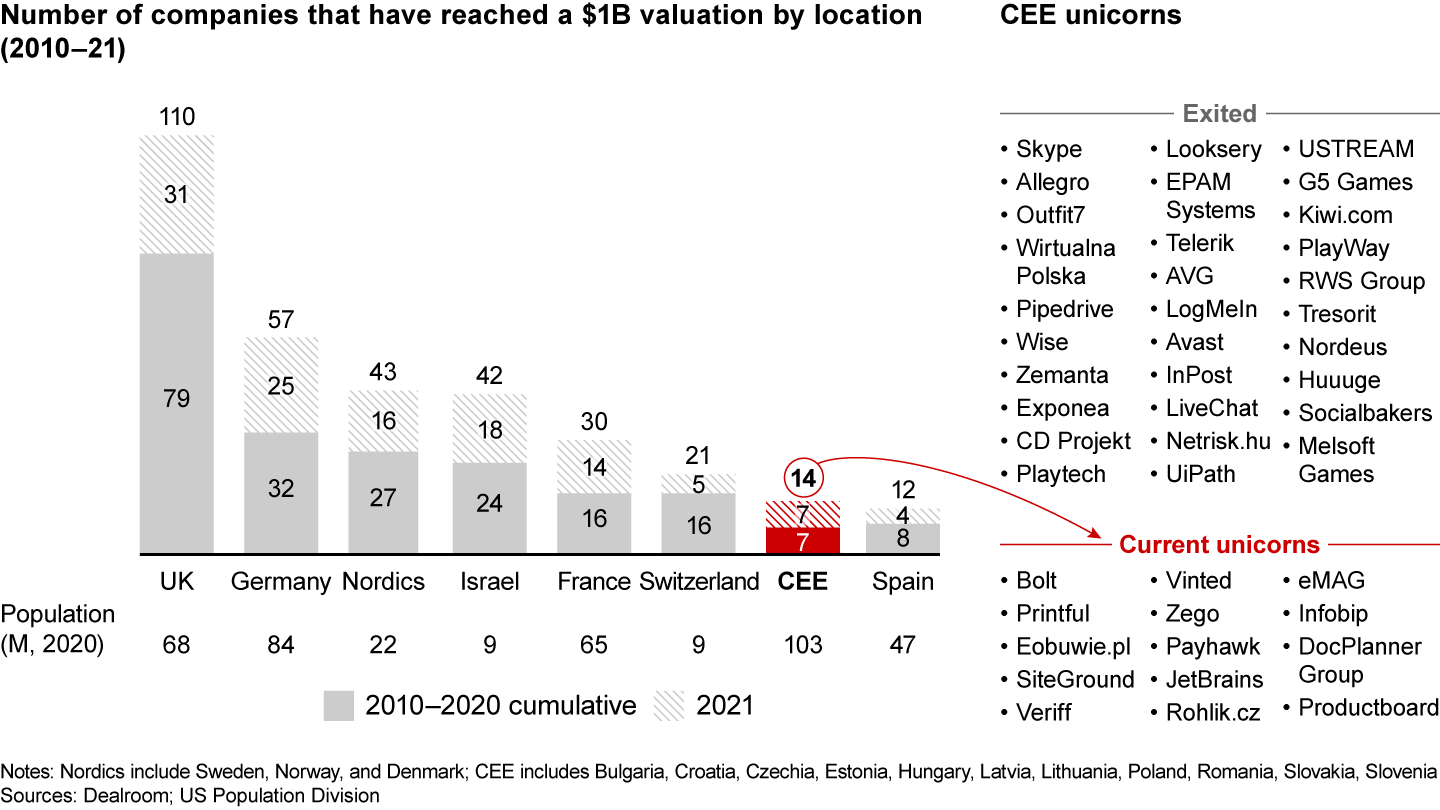
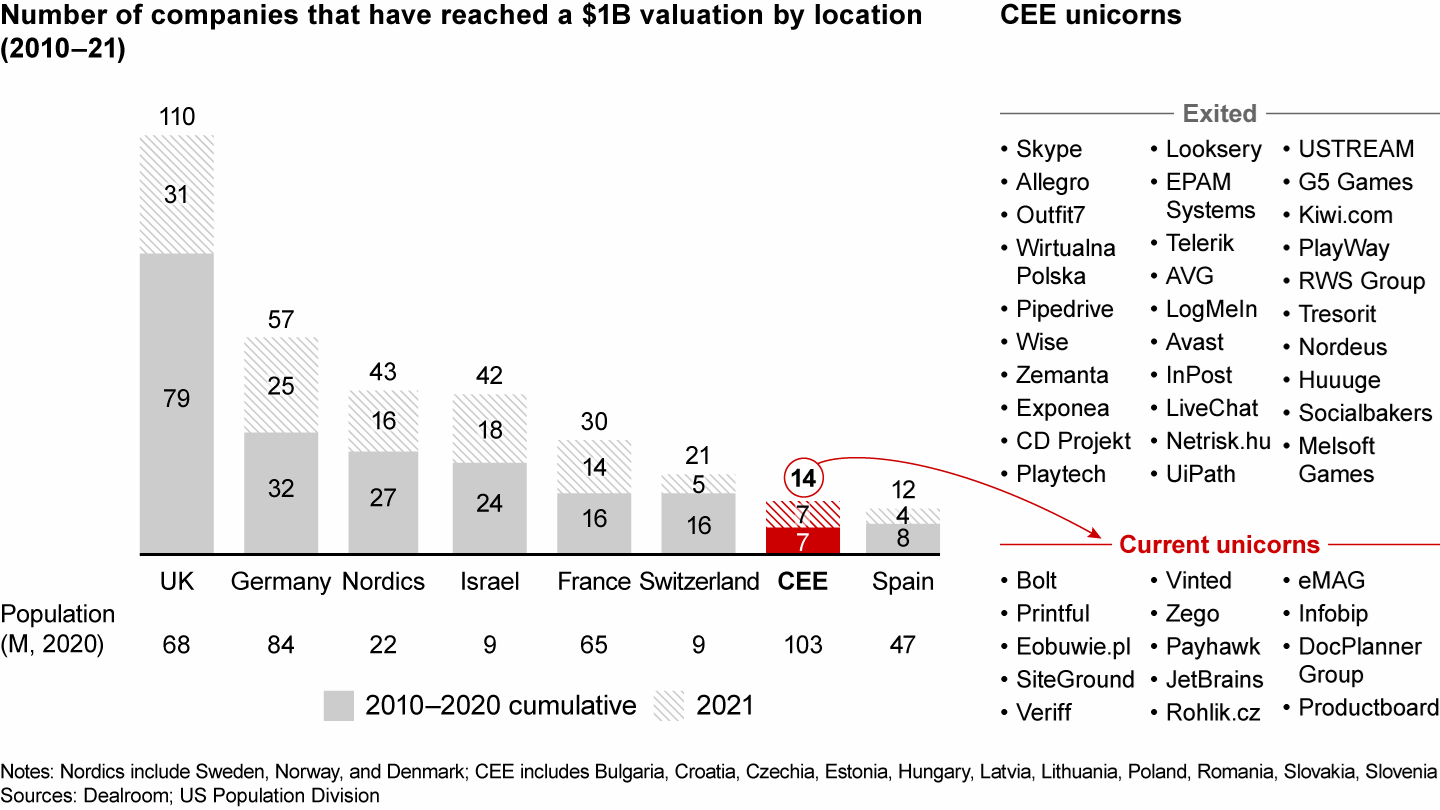
What’s more, this growth is built on solid foundations. As mentioned above, one of CEE’s core assets is its deep pool of tech talent, shaped by robust educational systems in the hard sciences and engineering. Students and young professionals are expressing increasing interest in becoming entrepreneurs (see Figure 36), shaking off previous generations’ reluctance to embark on this career path. And perhaps most crucially, a flywheel effect is beginning to emerge in which alumni of the region’s successful start-ups are now investing in and managing the next generation of companies.
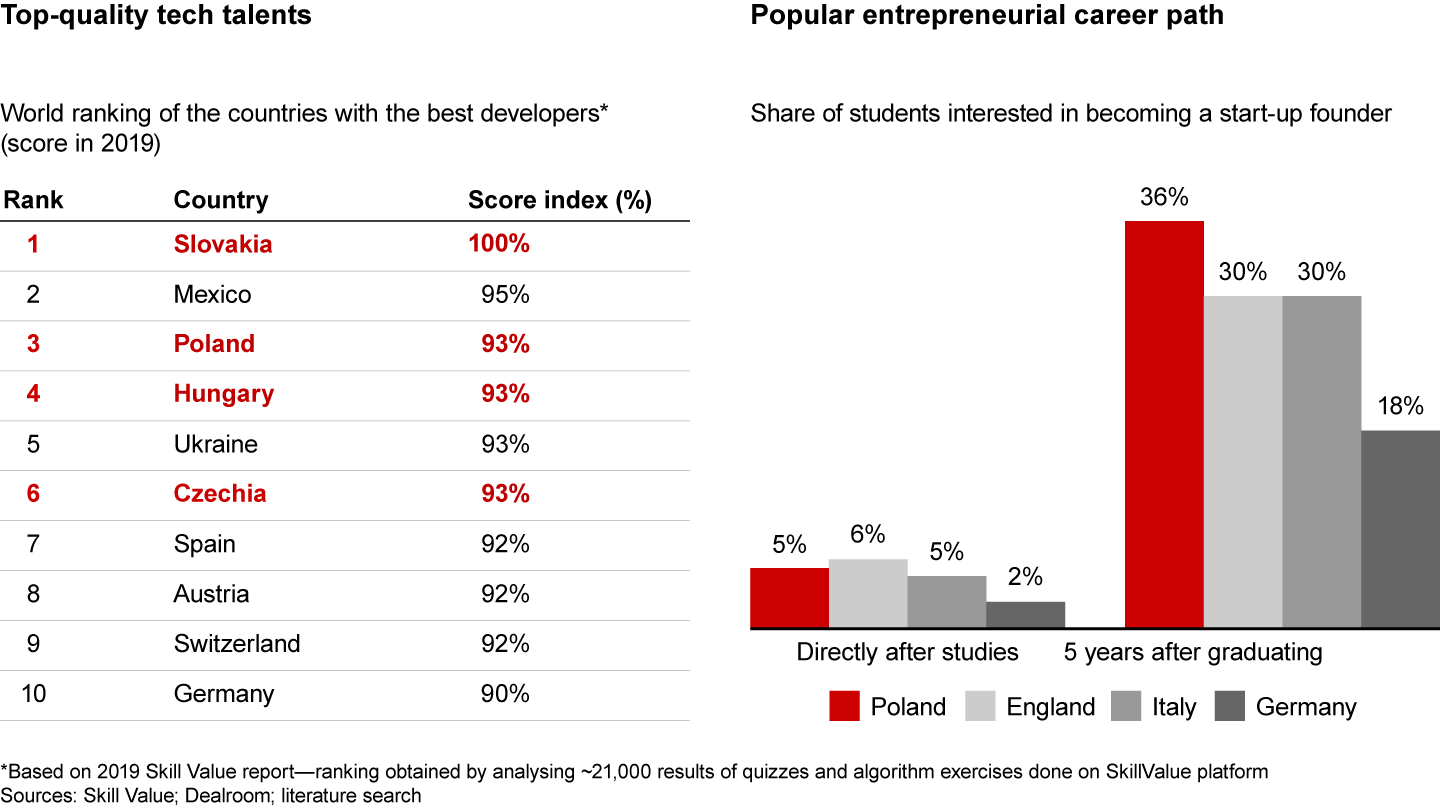
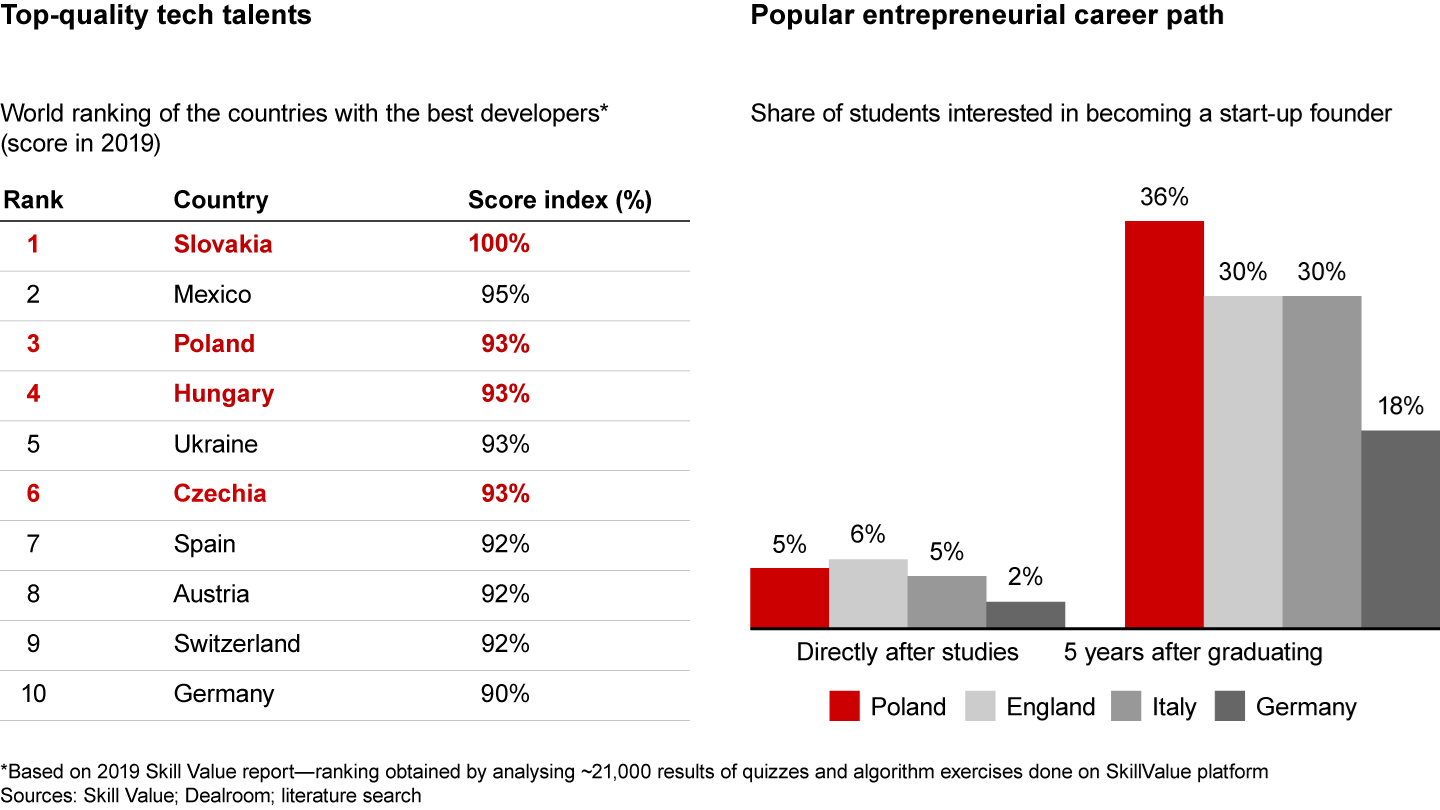
The current stage of Central and Eastern Europe’s VC ecosystem is shown by the share of early-stage funding rounds, which remains higher than in Western Europe (see Figure 37). In 2021, pre-seed rounds made up as much as 70% of the total number of funding rounds on average for CEE countries, compared with 51% for Western European countries. Still, that’s down from 80% in the previous year, and a smaller share than in any year since 2010, indicating that the market is indeed maturing.
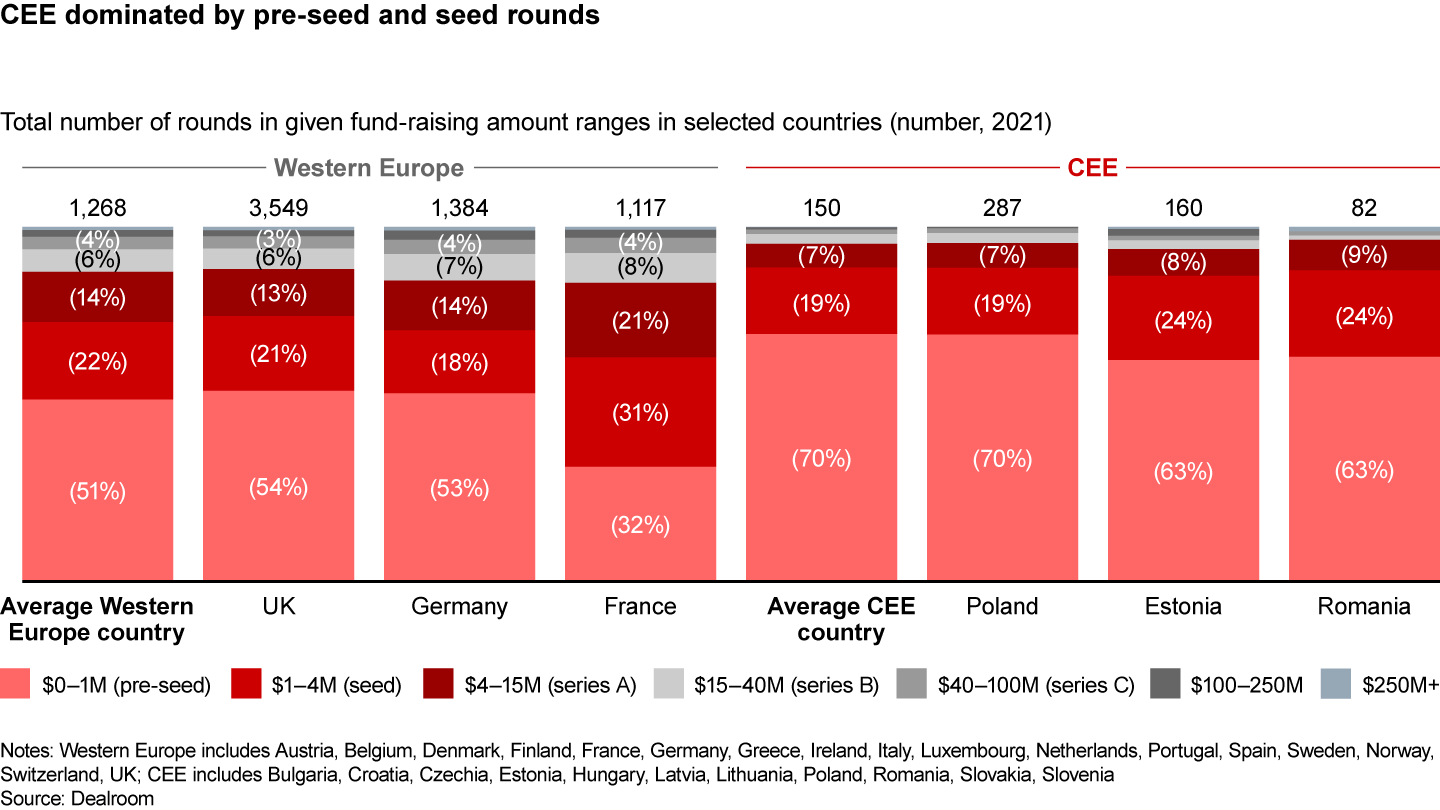
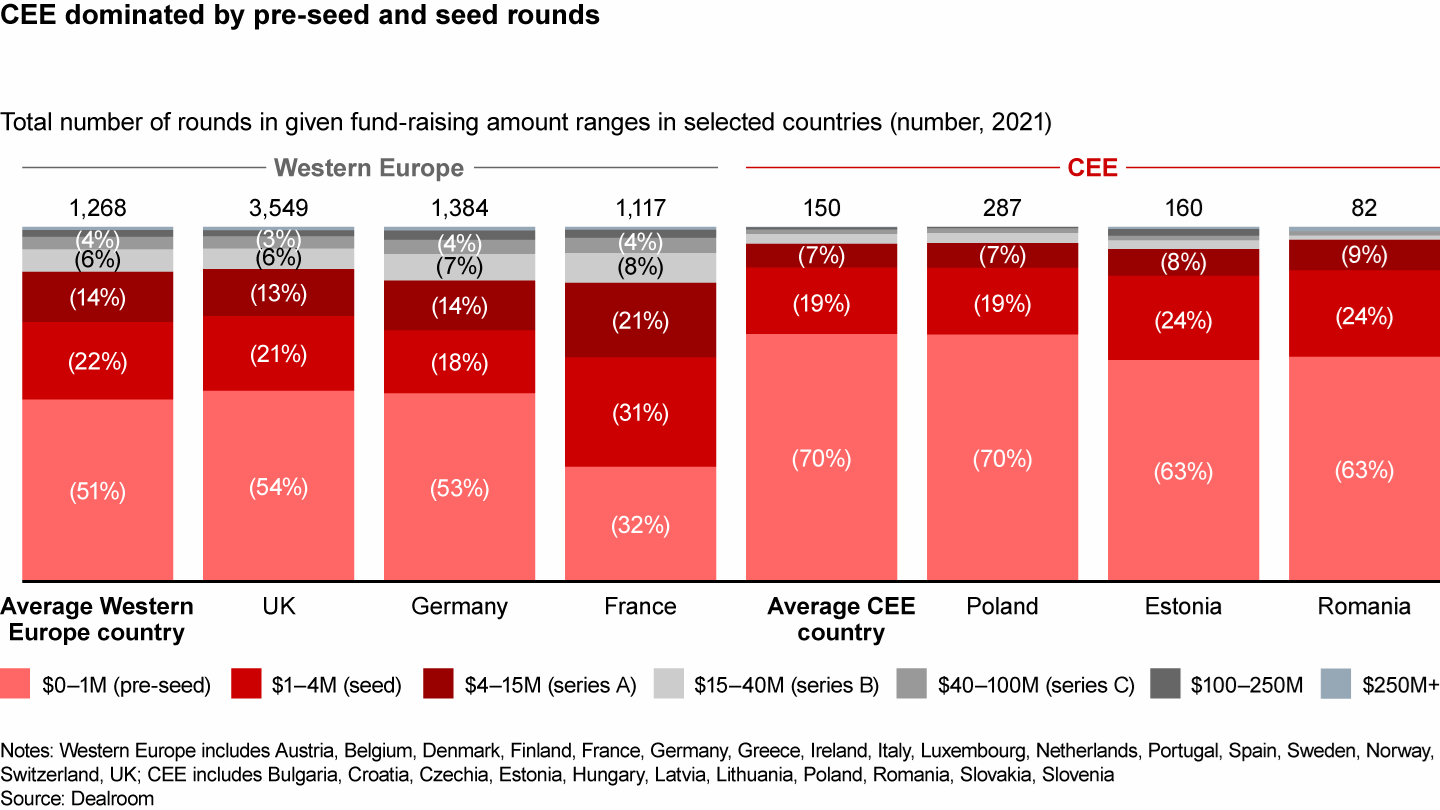
A look at the region’s unicorns also indicates that the VC industry has space to grow: 44% of them were bootstrapped, more than twice the 20% rate for the EU as a whole. VC in the region is equivalent to 0.3% of GDP, less than half the Western European rate of 0.62% (see Figure 38), though Estonia is a standout, with a remarkable 4.44%.
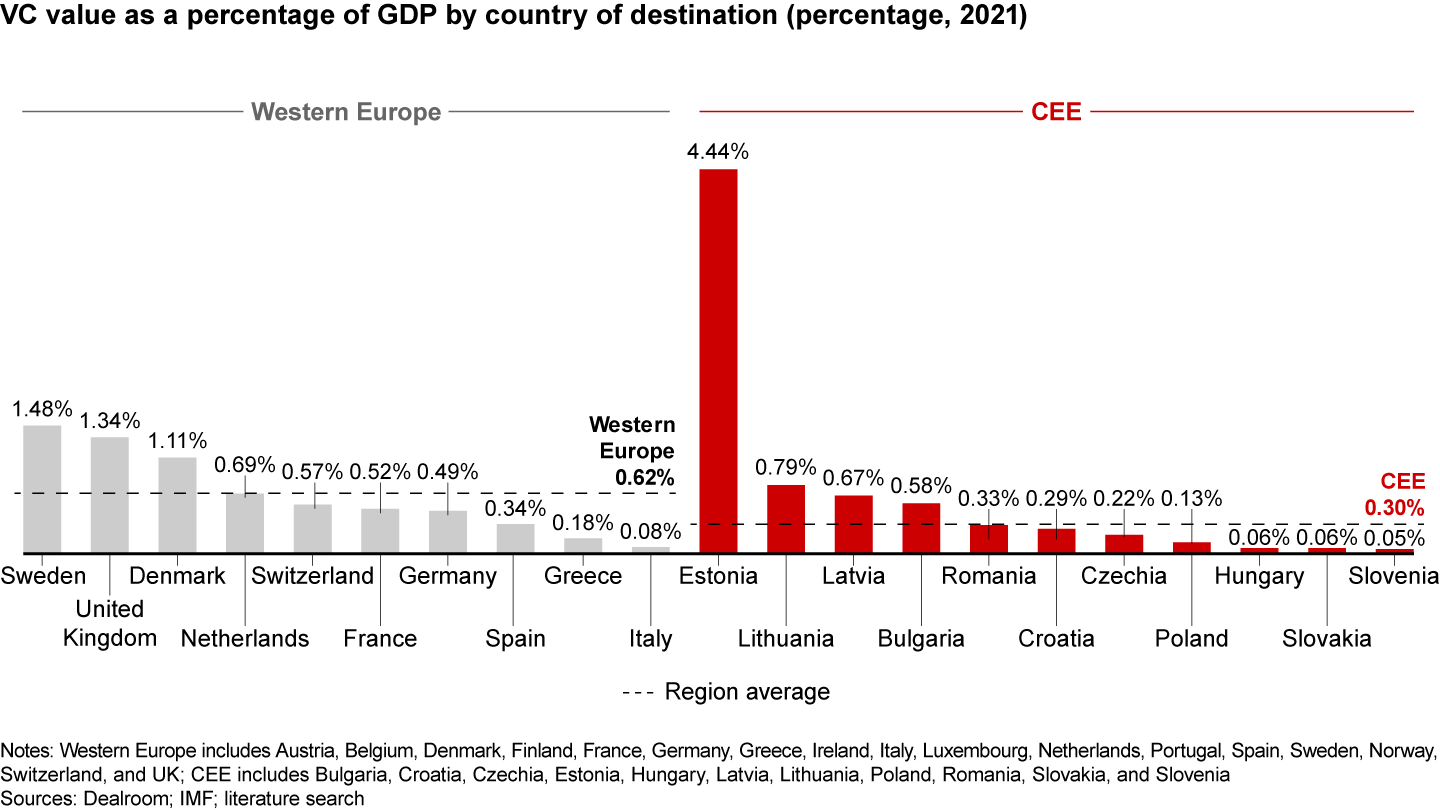
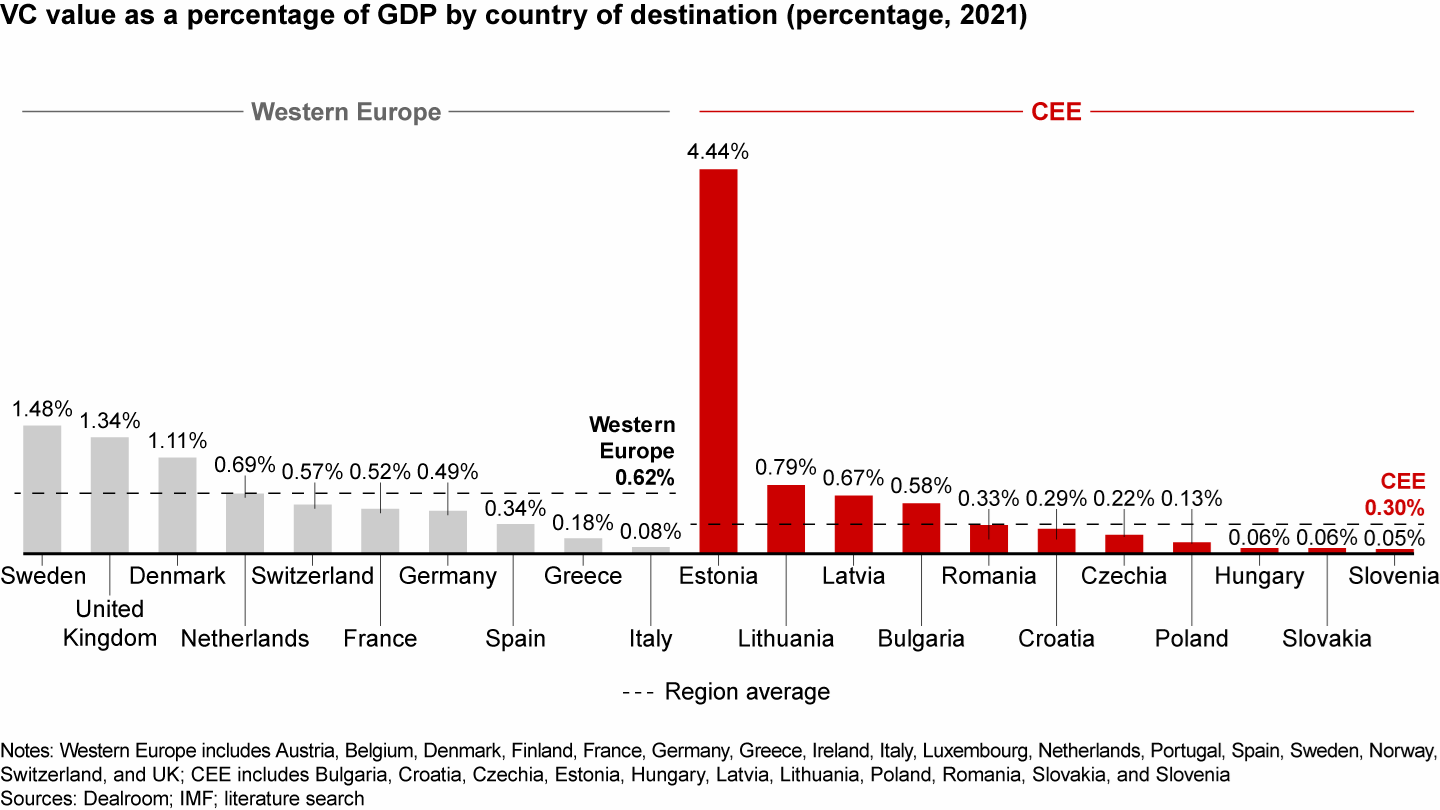
In terms of the sources of capital, CEE boasts a healthy mix of local and international funds. Funding from the US is especially present in megarounds in the region, accounting for 85% of funds raised in rounds of $100 million or more (see Figure 39). Meanwhile, the European Investment Bank, the lending arm of the EU, and the European Investment Fund recently set up the European Tech Champions Initiative, which will manage a €10 billion, multi-investor fund of funds structure. The goal of the initiative is to develop a European ecosystem fostering the growth phase of innovative tech companies, mobilising private investors alongside public commitments.

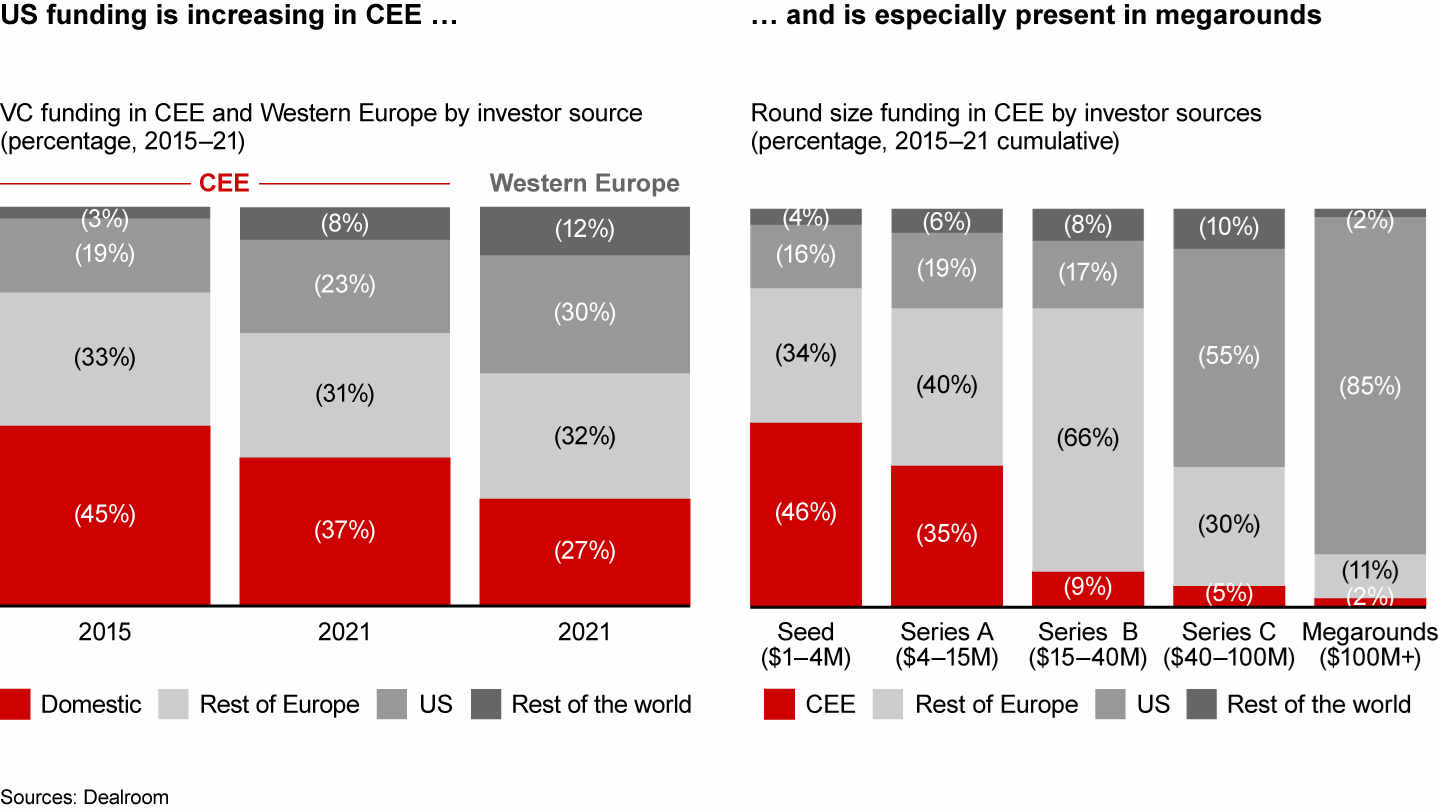
A comparison with other ecosystems indicates that growth may be as fast as two to three times over four years if the region follows the same trajectory as Western European ecosystems from this point in their development (see Figure 40). Although the technology advancement and other enablers do not position VC ecosystems in CEE to achieve performance like that of Israel, CEE could reach a trajectory like that of Germany (see Figure 41). And as the global tech industry faces headwinds, the higher share of early-stage rounds (pre-seed, seed, and series A) in this region means investment activity may be relatively less affected. All these trends add up to a sustained period of healthy growth for the VC industry in Central and Eastern Europe.
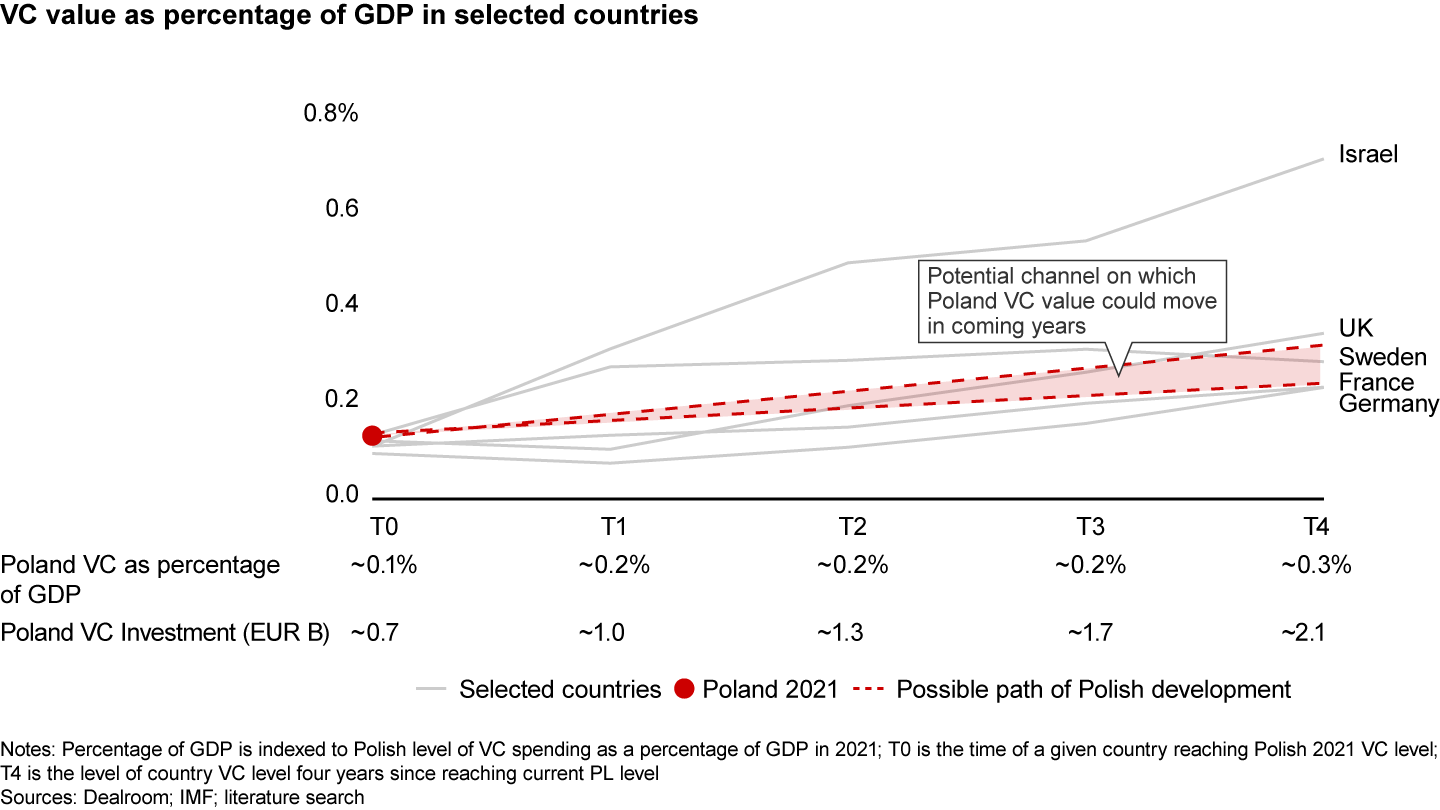
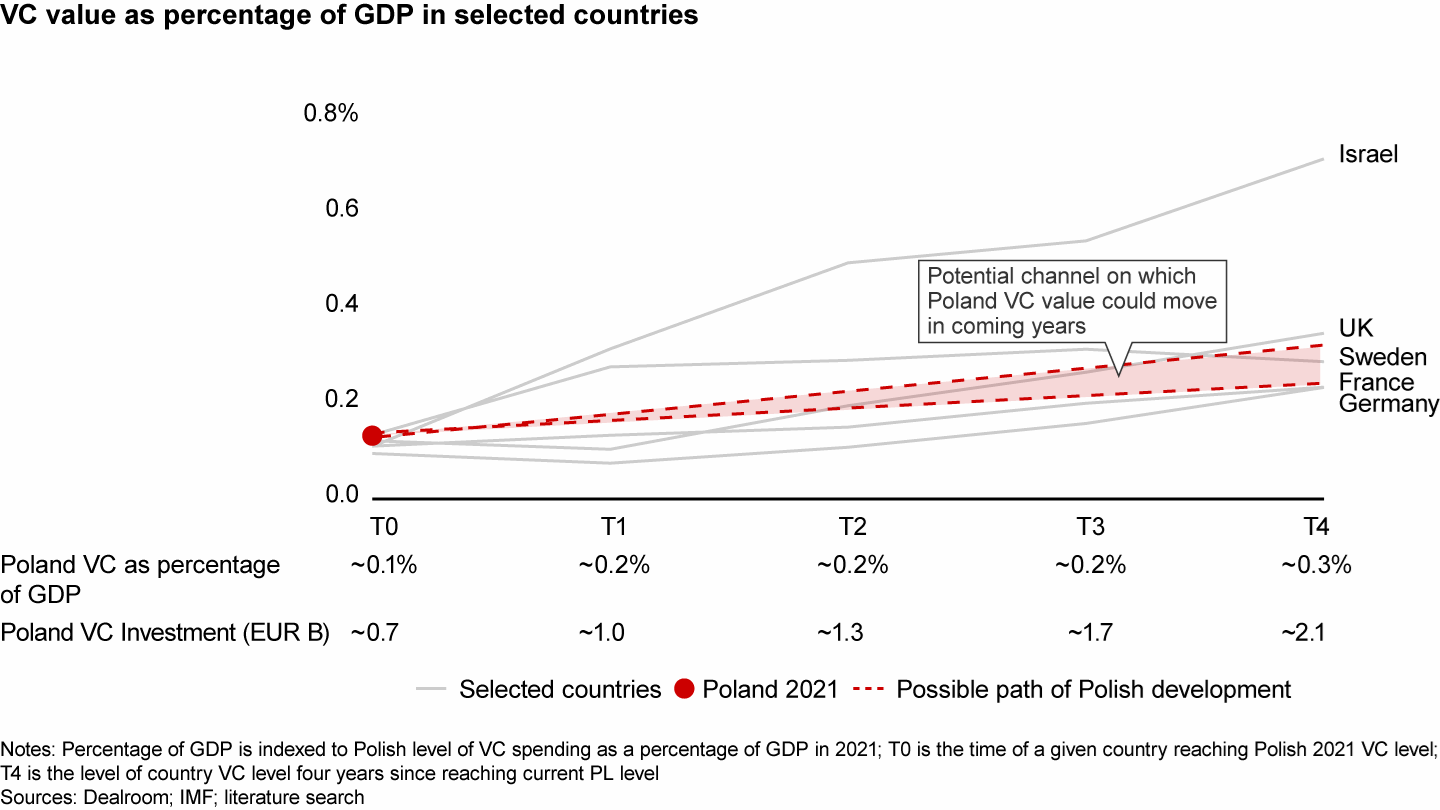
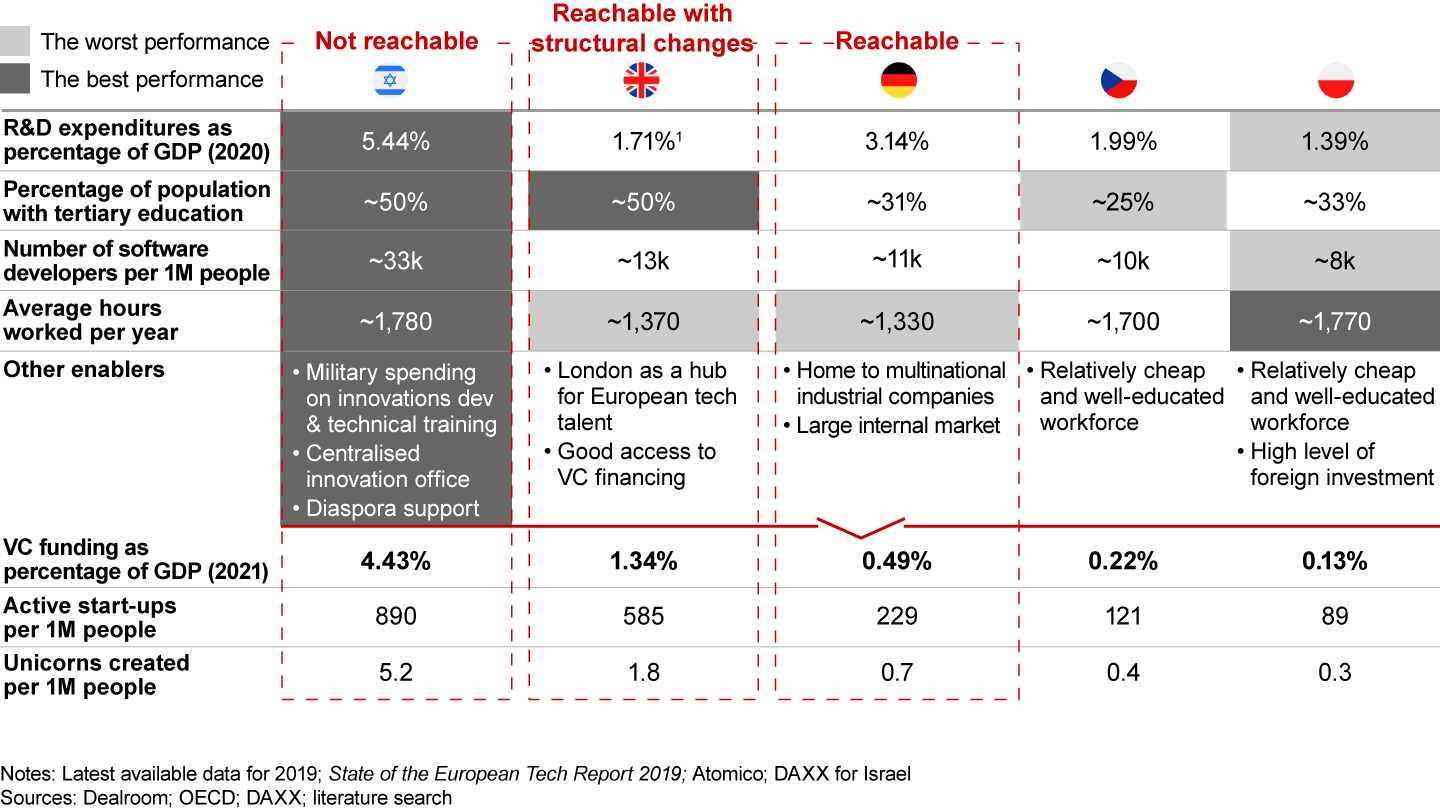
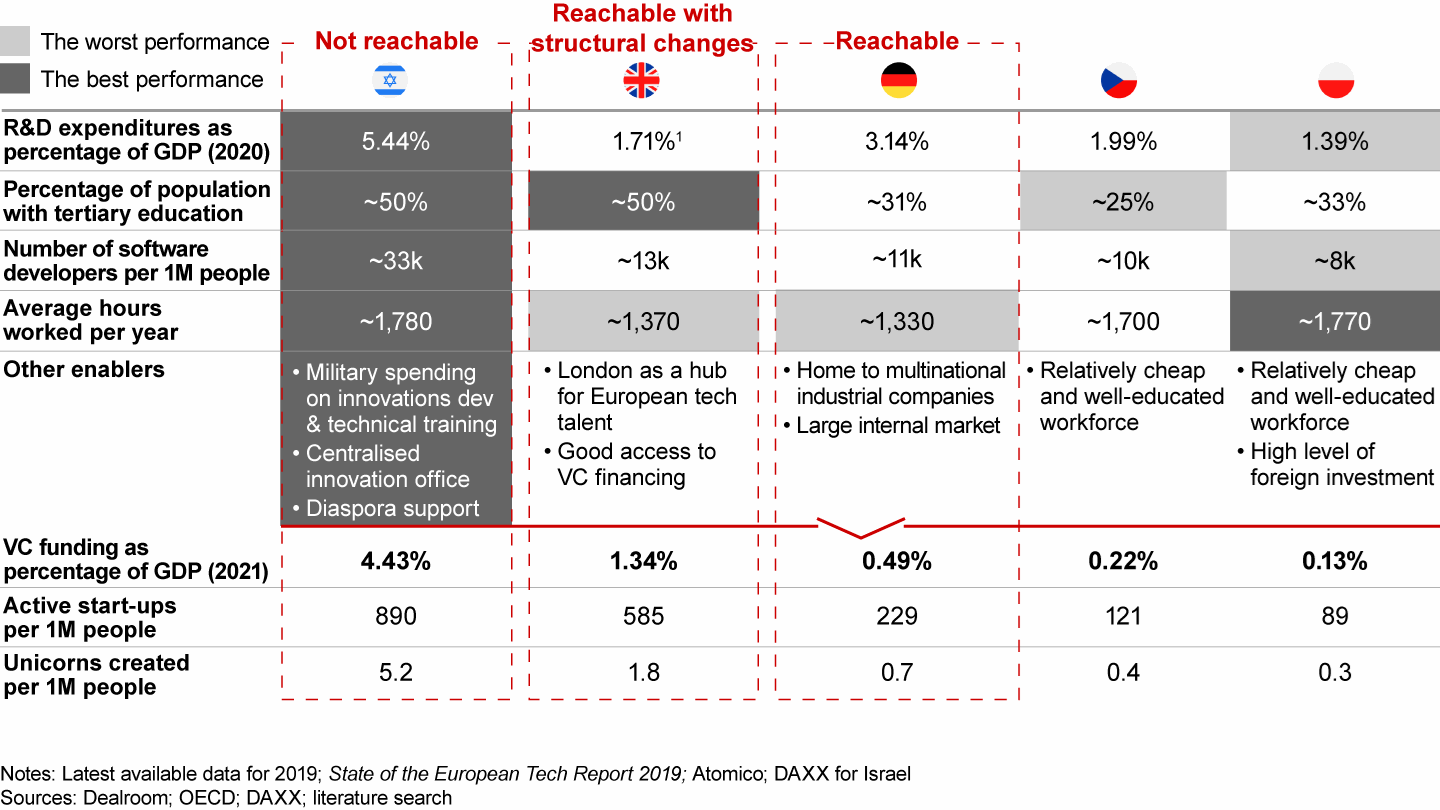

About Polish Private Equity and Venture Capital Association (PSIK)
PSIK gathers private equity/venture capital investors active in Poland. Its mission is to promote and develop the private equity and venture capital industry in Poland and to represent the interests of the Polish PE/VC community in Poland and abroad. PSIK comprises 134 institutions: 43 private equity and venture capital management firms (full members) and 92 associate members—law and consulting companies, investors, and banks cooperating with the private equity and venture capital industry.

About PFR Ventures
PFR Ventures is a company managing funds of funds that—together with private investors, business angels, and corporations—invests in venture capital and private equity. The objective of PFR Ventures is to use this capital to support Polish innovative companies at various stages of development. PFR Ventures currently holds a portfolio of 60 funds that have made over 550 investments.